Second world war ww2 world war ii pearl harbor attack Stock Photos and Images
(72)See second world war ww2 world war ii pearl harbor attack stock video clipsQuick filters:
Second world war ww2 world war ii pearl harbor attack Stock Photos and Images
 WAR ! PEARL HARBOUR ATTACK OAHU Vintage Pearl Harbor headlines December 7th 1941 Surprise Japanese bombing of Pearl Harbor Newspaper headline by Honolulu Star Bullentin “WAR ! Oahu bombed by Japanese Planes” Sunday December 7th 1941 Start of World War II between Japan and America USA Stock Photohttps://www.alamy.com/image-license-details/?v=1https://www.alamy.com/war-!-pearl-harbour-attack-oahu-vintage-pearl-harbor-headlines-december-7th-1941-surprise-japanese-bombing-of-pearl-harbor-newspaper-headline-by-honolulu-star-bullentin-war-!-oahu-bombed-by-japanese-planes-sunday-december-7th-1941-start-of-world-war-ii-between-japan-and-america-usa-image339568332.html
WAR ! PEARL HARBOUR ATTACK OAHU Vintage Pearl Harbor headlines December 7th 1941 Surprise Japanese bombing of Pearl Harbor Newspaper headline by Honolulu Star Bullentin “WAR ! Oahu bombed by Japanese Planes” Sunday December 7th 1941 Start of World War II between Japan and America USA Stock Photohttps://www.alamy.com/image-license-details/?v=1https://www.alamy.com/war-!-pearl-harbour-attack-oahu-vintage-pearl-harbor-headlines-december-7th-1941-surprise-japanese-bombing-of-pearl-harbor-newspaper-headline-by-honolulu-star-bullentin-war-!-oahu-bombed-by-japanese-planes-sunday-december-7th-1941-start-of-world-war-ii-between-japan-and-america-usa-image339568332.htmlRM2AMCJTC–WAR ! PEARL HARBOUR ATTACK OAHU Vintage Pearl Harbor headlines December 7th 1941 Surprise Japanese bombing of Pearl Harbor Newspaper headline by Honolulu Star Bullentin “WAR ! Oahu bombed by Japanese Planes” Sunday December 7th 1941 Start of World War II between Japan and America USA
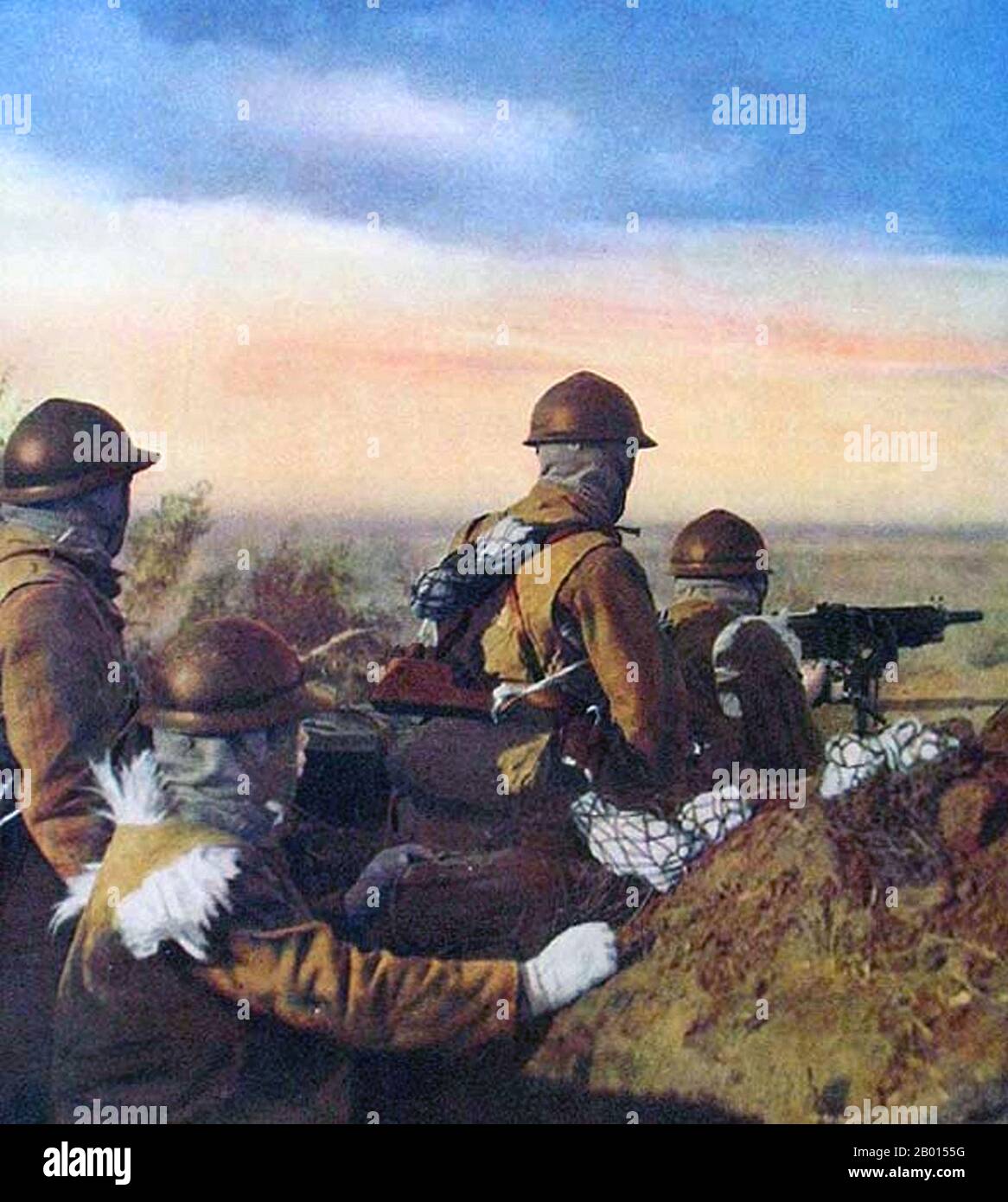 China: Japanese troops using a heavy machine gun during the invasion of Manchuria in 1931. The Second Sino-Japanese War was a military conflict fought primarily between the Republic of China and the Empire of Japan. After the Japanese attack on Pearl Harbor, the war merged into the greater conflict of World War II as a major front of what is broadly known as the Pacific War. Although the two countries had fought intermittently since 1931, total war started in earnest in 1937 and ended only with the surrender of Japan in 1945. Stock Photohttps://www.alamy.com/image-license-details/?v=1https://www.alamy.com/china-japanese-troops-using-a-heavy-machine-gun-during-the-invasion-of-manchuria-in-1931-the-second-sino-japanese-war-was-a-military-conflict-fought-primarily-between-the-republic-of-china-and-the-empire-of-japan-after-the-japanese-attack-on-pearl-harbor-the-war-merged-into-the-greater-conflict-of-world-war-ii-as-a-major-front-of-what-is-broadly-known-as-the-pacific-war-although-the-two-countries-had-fought-intermittently-since-1931-total-war-started-in-earnest-in-1937-and-ended-only-with-the-surrender-of-japan-in-1945-image344233388.html
China: Japanese troops using a heavy machine gun during the invasion of Manchuria in 1931. The Second Sino-Japanese War was a military conflict fought primarily between the Republic of China and the Empire of Japan. After the Japanese attack on Pearl Harbor, the war merged into the greater conflict of World War II as a major front of what is broadly known as the Pacific War. Although the two countries had fought intermittently since 1931, total war started in earnest in 1937 and ended only with the surrender of Japan in 1945. Stock Photohttps://www.alamy.com/image-license-details/?v=1https://www.alamy.com/china-japanese-troops-using-a-heavy-machine-gun-during-the-invasion-of-manchuria-in-1931-the-second-sino-japanese-war-was-a-military-conflict-fought-primarily-between-the-republic-of-china-and-the-empire-of-japan-after-the-japanese-attack-on-pearl-harbor-the-war-merged-into-the-greater-conflict-of-world-war-ii-as-a-major-front-of-what-is-broadly-known-as-the-pacific-war-although-the-two-countries-had-fought-intermittently-since-1931-total-war-started-in-earnest-in-1937-and-ended-only-with-the-surrender-of-japan-in-1945-image344233388.htmlRM2B0155G–China: Japanese troops using a heavy machine gun during the invasion of Manchuria in 1931. The Second Sino-Japanese War was a military conflict fought primarily between the Republic of China and the Empire of Japan. After the Japanese attack on Pearl Harbor, the war merged into the greater conflict of World War II as a major front of what is broadly known as the Pacific War. Although the two countries had fought intermittently since 1931, total war started in earnest in 1937 and ended only with the surrender of Japan in 1945.
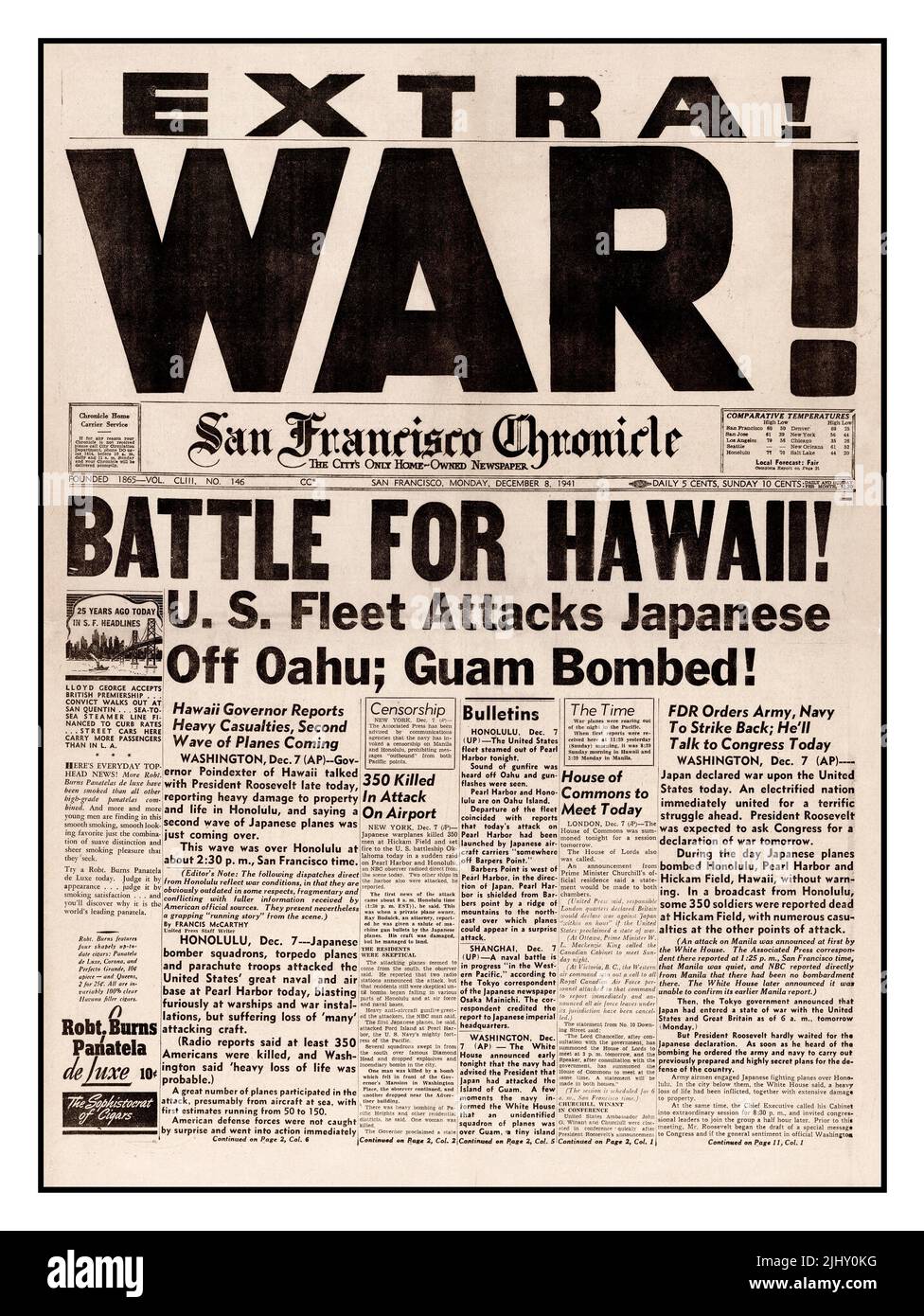 PEARL HARBOR WAR BATTLE ATTACK Newspaper Headline 'WAR' Battle for Hawaii.. Dec 8th 1941 San Francisco Chronicle WW2 Start of World War II for The United States against Imperial Japan Stock Photohttps://www.alamy.com/image-license-details/?v=1https://www.alamy.com/pearl-harbor-war-battle-attack-newspaper-headline-war-battle-for-hawaii-dec-8th-1941-san-francisco-chronicle-ww2-start-of-world-war-ii-for-the-united-states-against-imperial-japan-image475722340.html
PEARL HARBOR WAR BATTLE ATTACK Newspaper Headline 'WAR' Battle for Hawaii.. Dec 8th 1941 San Francisco Chronicle WW2 Start of World War II for The United States against Imperial Japan Stock Photohttps://www.alamy.com/image-license-details/?v=1https://www.alamy.com/pearl-harbor-war-battle-attack-newspaper-headline-war-battle-for-hawaii-dec-8th-1941-san-francisco-chronicle-ww2-start-of-world-war-ii-for-the-united-states-against-imperial-japan-image475722340.htmlRM2JHY0KG–PEARL HARBOR WAR BATTLE ATTACK Newspaper Headline 'WAR' Battle for Hawaii.. Dec 8th 1941 San Francisco Chronicle WW2 Start of World War II for The United States against Imperial Japan
 An American WW2 poster with patriotic slogans to gain support for the war effort saying Remember December 7 (Pearl Harbor attack) Stock Photohttps://www.alamy.com/image-license-details/?v=1https://www.alamy.com/an-american-ww2-poster-with-patriotic-slogans-to-gain-support-for-the-war-effort-saying-remember-december-7-pearl-harbor-attack-image418855641.html
An American WW2 poster with patriotic slogans to gain support for the war effort saying Remember December 7 (Pearl Harbor attack) Stock Photohttps://www.alamy.com/image-license-details/?v=1https://www.alamy.com/an-american-ww2-poster-with-patriotic-slogans-to-gain-support-for-the-war-effort-saying-remember-december-7-pearl-harbor-attack-image418855641.htmlRM2F9CEJ1–An American WW2 poster with patriotic slogans to gain support for the war effort saying Remember December 7 (Pearl Harbor attack)
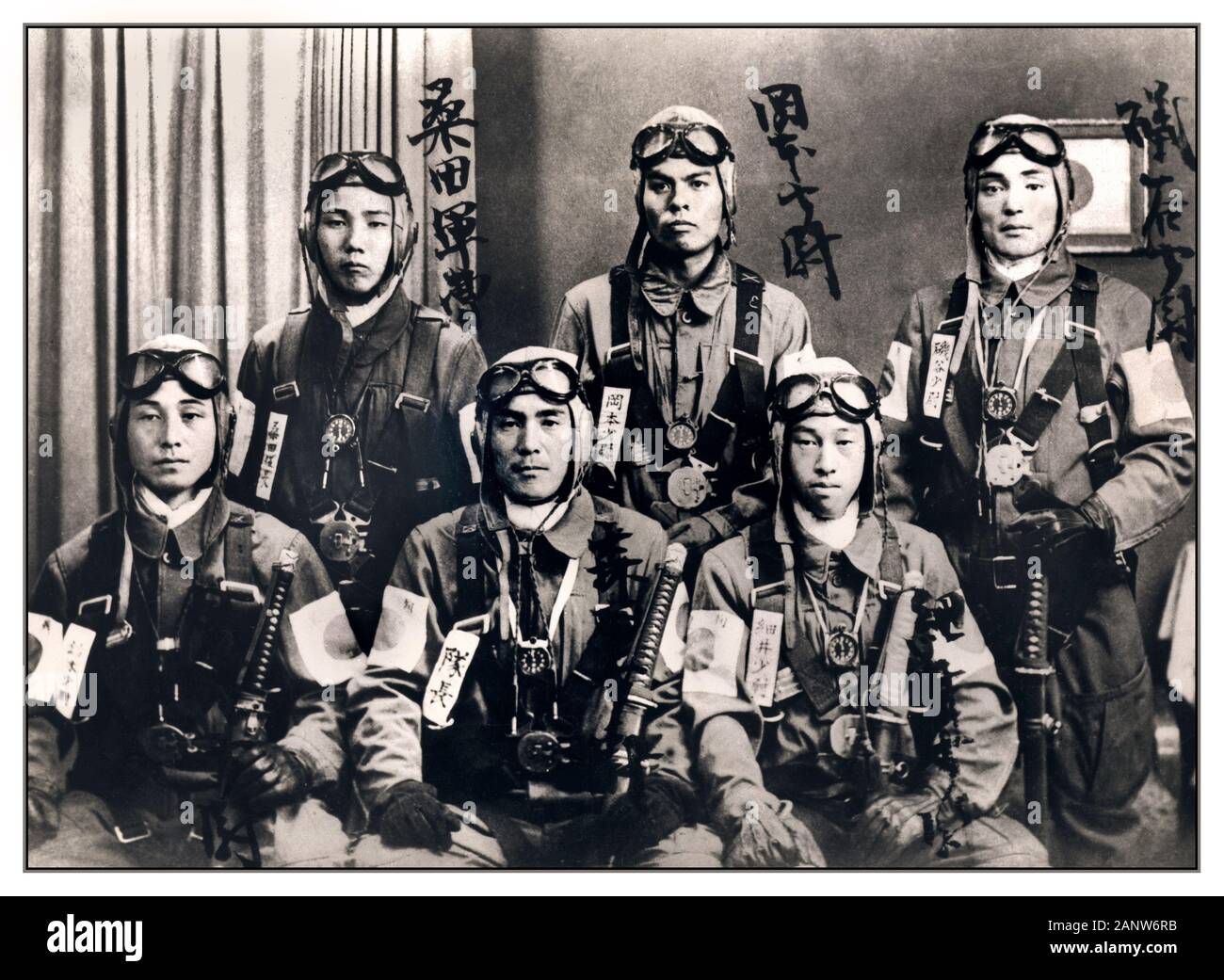 KAMIKAZE PILOTS Vintage 1940’s WW2 Image of a group of Japanese Kamikaze suicide pilots posing for a signed group photo to immortalise them before their final suicide flights as guided flying missiles in the Pacific War against the American Fleet. Japanese 'Kamikaze' or suicide pilots were used to attack Pearl Harbor World War II Second World War WWII JAPAN Stock Photohttps://www.alamy.com/image-license-details/?v=1https://www.alamy.com/kamikaze-pilots-vintage-1940s-ww2-image-of-a-group-of-japanese-kamikaze-suicide-pilots-posing-for-a-signed-group-photo-to-immortalise-them-before-their-final-suicide-flights-as-guided-flying-missiles-in-the-pacific-war-against-the-american-fleet-japanese-kamikaze-or-suicide-pilots-were-used-to-attack-pearl-harbor-world-war-ii-second-world-war-wwii-japan-image340458927.html
KAMIKAZE PILOTS Vintage 1940’s WW2 Image of a group of Japanese Kamikaze suicide pilots posing for a signed group photo to immortalise them before their final suicide flights as guided flying missiles in the Pacific War against the American Fleet. Japanese 'Kamikaze' or suicide pilots were used to attack Pearl Harbor World War II Second World War WWII JAPAN Stock Photohttps://www.alamy.com/image-license-details/?v=1https://www.alamy.com/kamikaze-pilots-vintage-1940s-ww2-image-of-a-group-of-japanese-kamikaze-suicide-pilots-posing-for-a-signed-group-photo-to-immortalise-them-before-their-final-suicide-flights-as-guided-flying-missiles-in-the-pacific-war-against-the-american-fleet-japanese-kamikaze-or-suicide-pilots-were-used-to-attack-pearl-harbor-world-war-ii-second-world-war-wwii-japan-image340458927.htmlRM2ANW6RB–KAMIKAZE PILOTS Vintage 1940’s WW2 Image of a group of Japanese Kamikaze suicide pilots posing for a signed group photo to immortalise them before their final suicide flights as guided flying missiles in the Pacific War against the American Fleet. Japanese 'Kamikaze' or suicide pilots were used to attack Pearl Harbor World War II Second World War WWII JAPAN
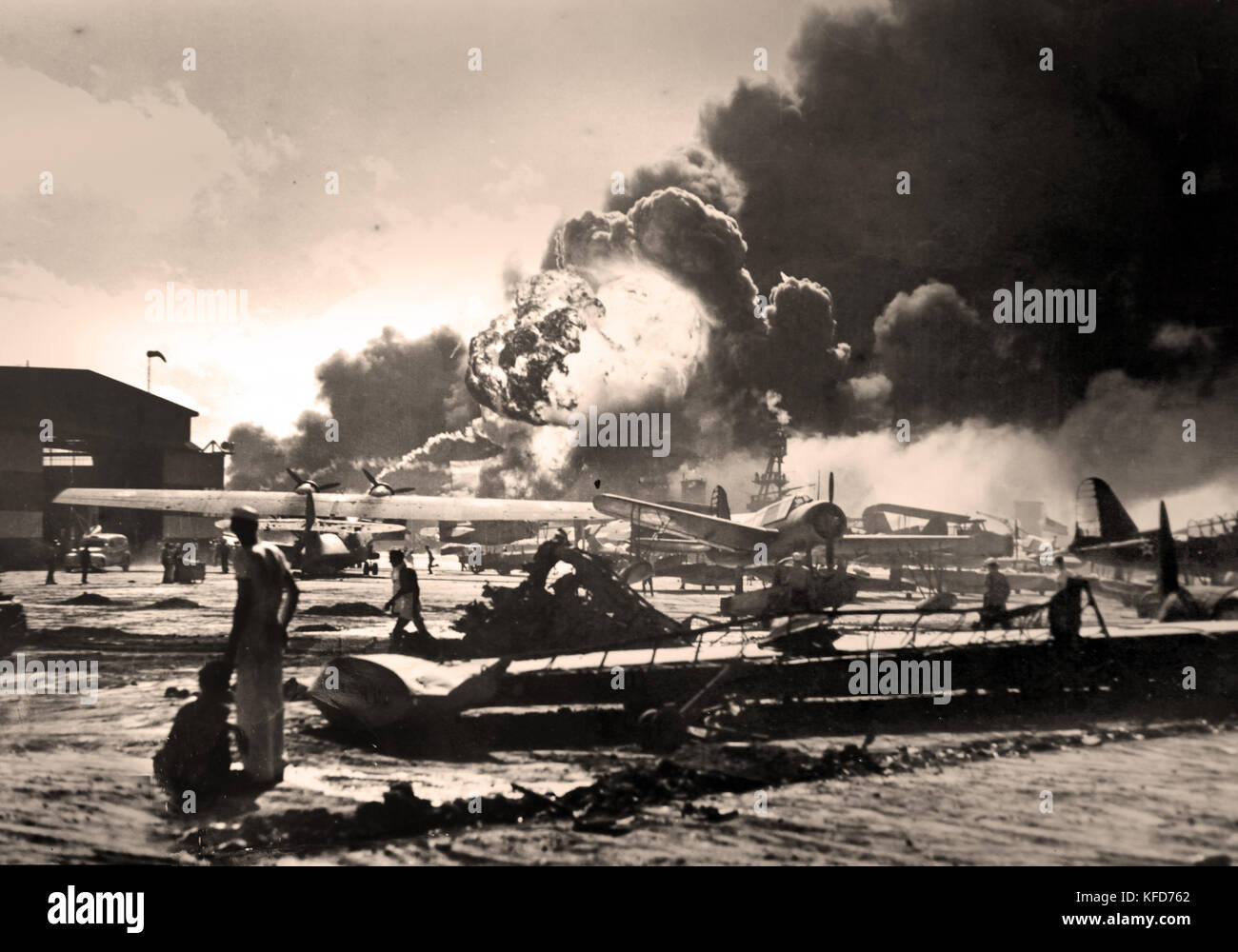 The attack on Pearl Harbor was a surprise military strike by the Imperial Japanese Navy Air Service against the United States naval base at Pearl Harbor, Hawaii Territory, on the morning of December 7, 1941. The attack, also known as the Battle of Pearl Harbor. Stock Photohttps://www.alamy.com/image-license-details/?v=1https://www.alamy.com/stock-image-the-attack-on-pearl-harbor-was-a-surprise-military-strike-by-the-imperial-164404186.html
The attack on Pearl Harbor was a surprise military strike by the Imperial Japanese Navy Air Service against the United States naval base at Pearl Harbor, Hawaii Territory, on the morning of December 7, 1941. The attack, also known as the Battle of Pearl Harbor. Stock Photohttps://www.alamy.com/image-license-details/?v=1https://www.alamy.com/stock-image-the-attack-on-pearl-harbor-was-a-surprise-military-strike-by-the-imperial-164404186.htmlRMKFD762–The attack on Pearl Harbor was a surprise military strike by the Imperial Japanese Navy Air Service against the United States naval base at Pearl Harbor, Hawaii Territory, on the morning of December 7, 1941. The attack, also known as the Battle of Pearl Harbor.
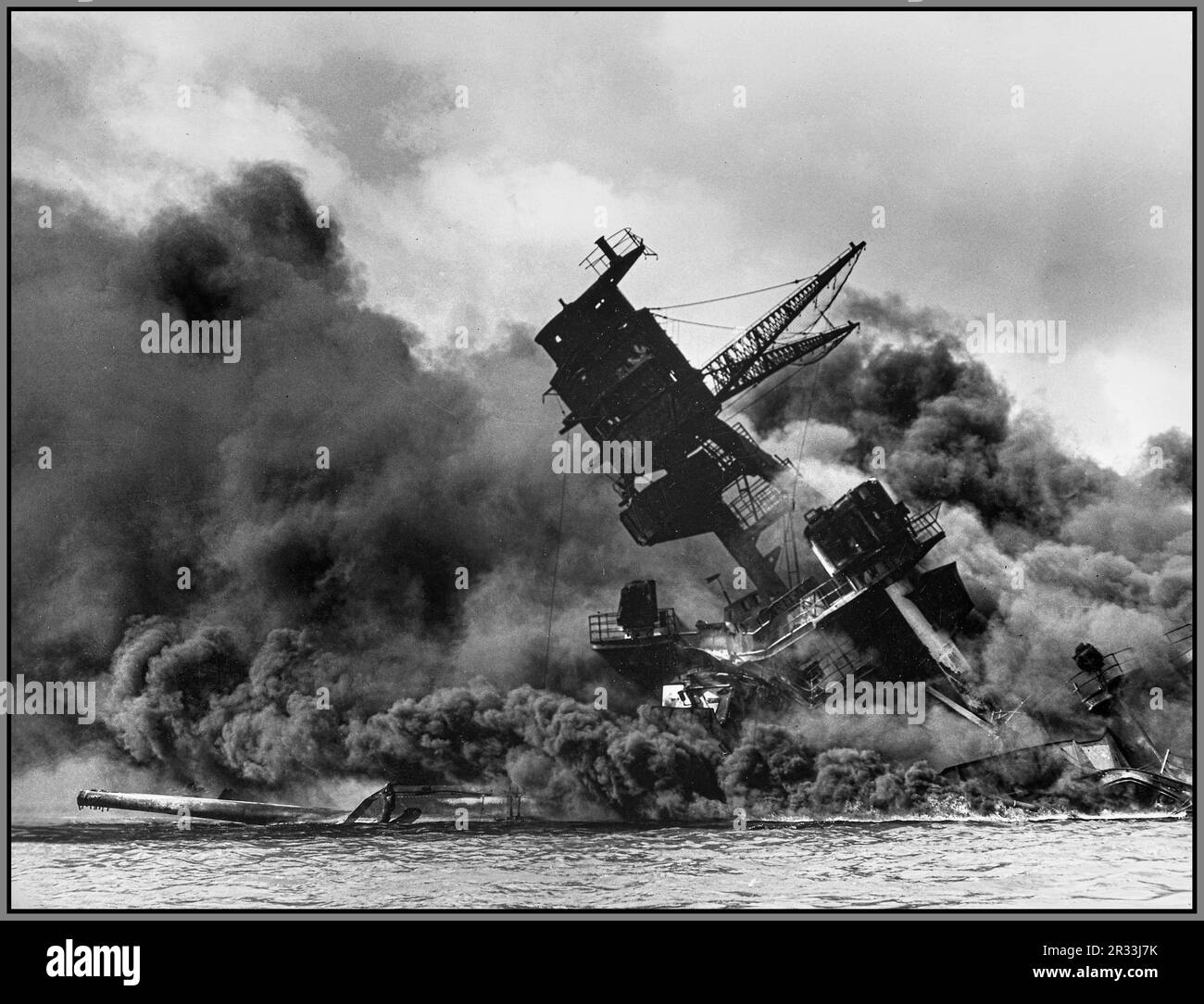 The USS Arizona (BB-39) burning after the Japanese attack on Pearl Harbor, 7 December 1941. USS Arizona sunk at Pearl Harbor. The ship is resting on the harbor bottom. The supporting structure of the forward tripod mast has collapsed after the forward magazine exploded. WW2 World War II Second World War Stock Photohttps://www.alamy.com/image-license-details/?v=1https://www.alamy.com/the-uss-arizona-bb-39-burning-after-the-japanese-attack-on-pearl-harbor-7-december-1941-uss-arizona-sunk-at-pearl-harbor-the-ship-is-resting-on-the-harbor-bottom-the-supporting-structure-of-the-forward-tripod-mast-has-collapsed-after-the-forward-magazine-exploded-ww2-world-war-ii-second-world-war-image552655927.html
The USS Arizona (BB-39) burning after the Japanese attack on Pearl Harbor, 7 December 1941. USS Arizona sunk at Pearl Harbor. The ship is resting on the harbor bottom. The supporting structure of the forward tripod mast has collapsed after the forward magazine exploded. WW2 World War II Second World War Stock Photohttps://www.alamy.com/image-license-details/?v=1https://www.alamy.com/the-uss-arizona-bb-39-burning-after-the-japanese-attack-on-pearl-harbor-7-december-1941-uss-arizona-sunk-at-pearl-harbor-the-ship-is-resting-on-the-harbor-bottom-the-supporting-structure-of-the-forward-tripod-mast-has-collapsed-after-the-forward-magazine-exploded-ww2-world-war-ii-second-world-war-image552655927.htmlRM2R33J7K–The USS Arizona (BB-39) burning after the Japanese attack on Pearl Harbor, 7 December 1941. USS Arizona sunk at Pearl Harbor. The ship is resting on the harbor bottom. The supporting structure of the forward tripod mast has collapsed after the forward magazine exploded. WW2 World War II Second World War
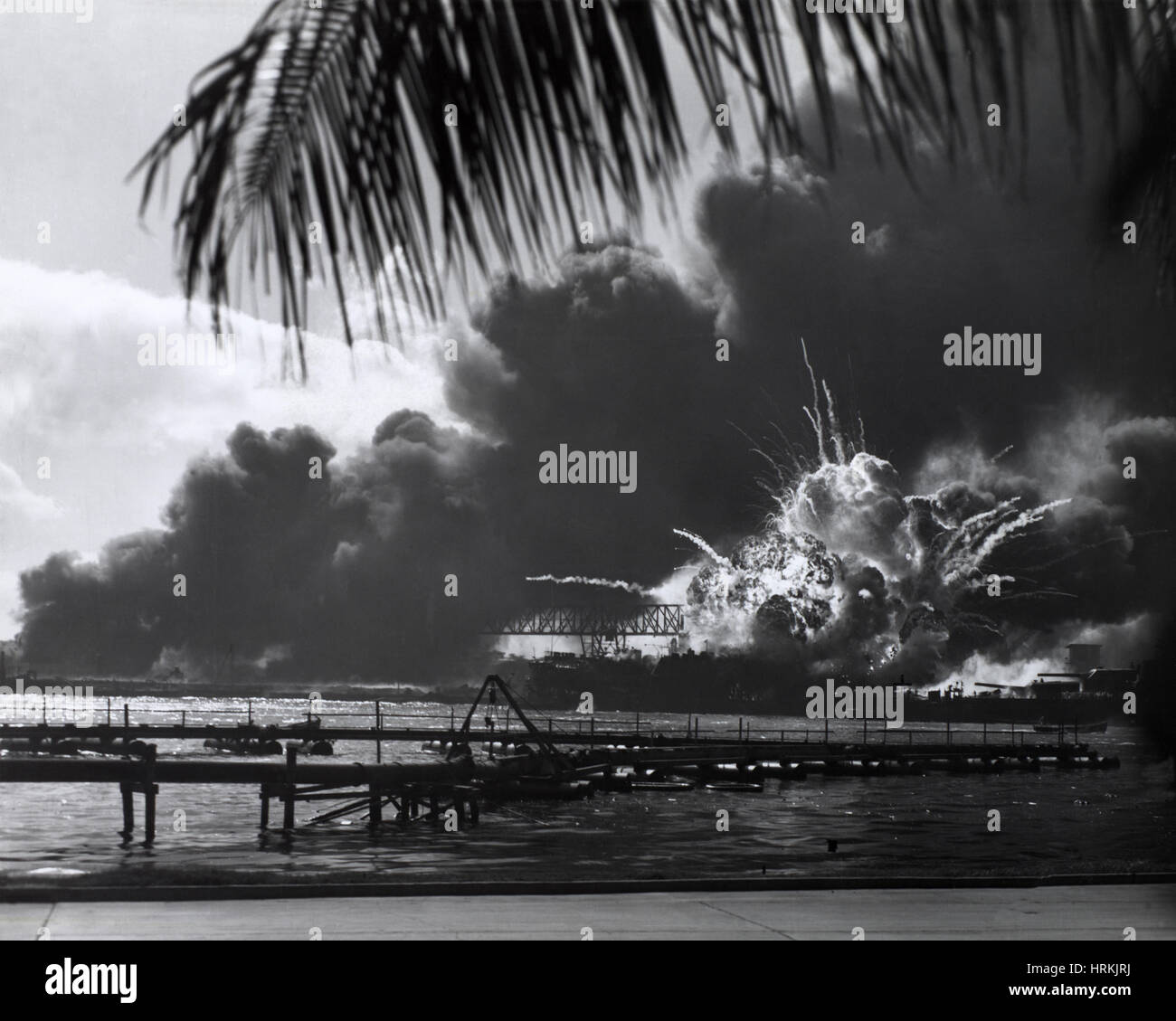 USS Shaw, Pearl Harbor, December 7, 1941 Stock Photohttps://www.alamy.com/image-license-details/?v=1https://www.alamy.com/stock-photo-uss-shaw-pearl-harbor-december-7-1941-135041526.html
USS Shaw, Pearl Harbor, December 7, 1941 Stock Photohttps://www.alamy.com/image-license-details/?v=1https://www.alamy.com/stock-photo-uss-shaw-pearl-harbor-december-7-1941-135041526.htmlRMHRKJRJ–USS Shaw, Pearl Harbor, December 7, 1941
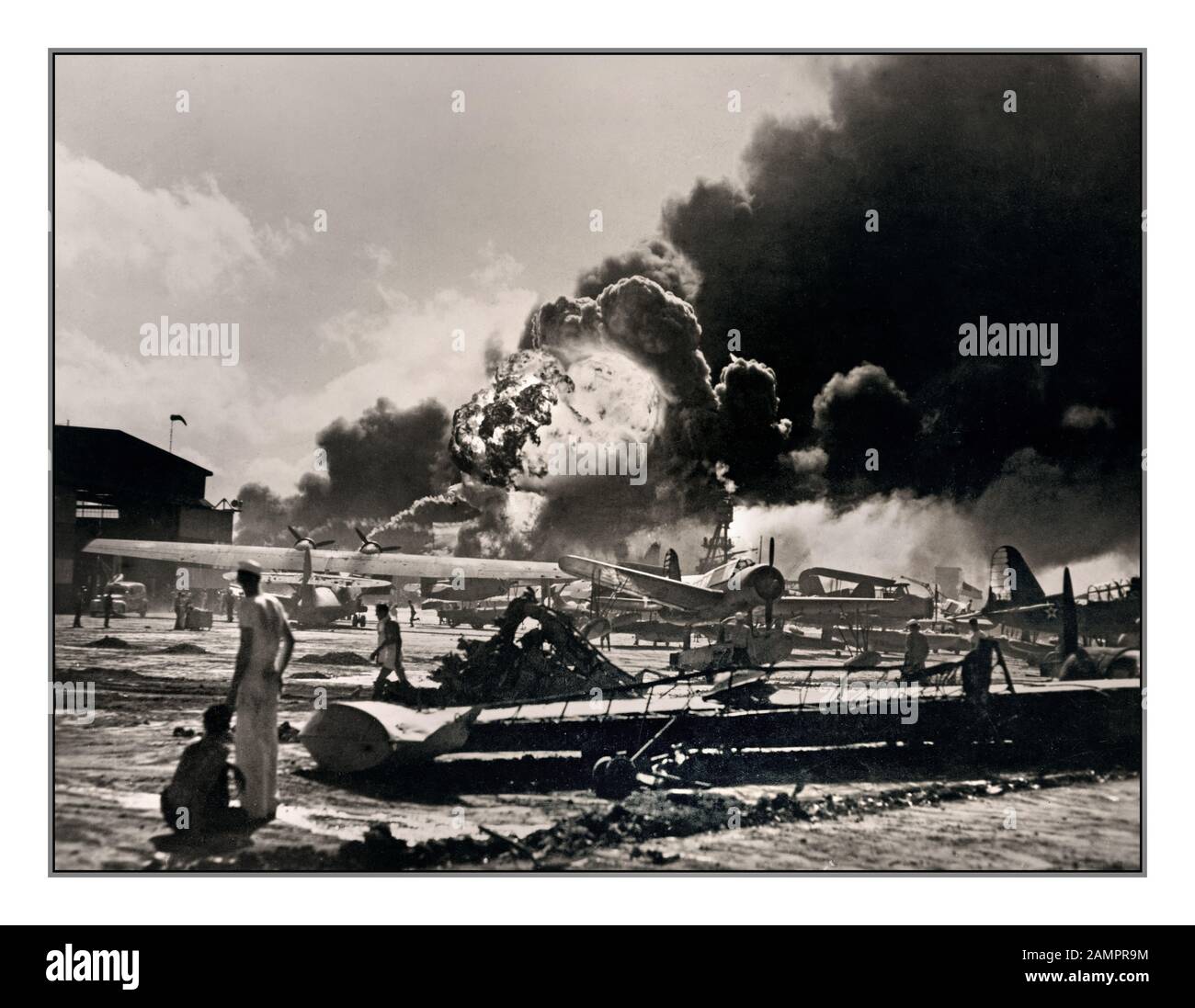 PEARL HARBOR ATTACK HICKAM FIELD WW2 vintage B&W image of chaotic Pearl Harbor Japanese attack December 7th 1941 as viewed from Hickam Field. Japanese attacked Pearl Harbor on Dec. 7th 1941. Hickam Field was badly damaged with significant loss of life and many aircraft lost U.S. Naval Operating Base, Pearl Harbor, Oahu, Hawaii USA, World War II Second World War Stock Photohttps://www.alamy.com/image-license-details/?v=1https://www.alamy.com/pearl-harbor-attack-hickam-field-ww2-vintage-bw-image-of-chaotic-pearl-harbor-japanese-attack-december-7th-1941-as-viewed-from-hickam-field-japanese-attacked-pearl-harbor-on-dec-7th-1941-hickam-field-was-badly-damaged-with-significant-loss-of-life-and-many-aircraft-lost-us-naval-operating-base-pearl-harbor-oahu-hawaii-usa-world-war-ii-second-world-war-image339791360.html
PEARL HARBOR ATTACK HICKAM FIELD WW2 vintage B&W image of chaotic Pearl Harbor Japanese attack December 7th 1941 as viewed from Hickam Field. Japanese attacked Pearl Harbor on Dec. 7th 1941. Hickam Field was badly damaged with significant loss of life and many aircraft lost U.S. Naval Operating Base, Pearl Harbor, Oahu, Hawaii USA, World War II Second World War Stock Photohttps://www.alamy.com/image-license-details/?v=1https://www.alamy.com/pearl-harbor-attack-hickam-field-ww2-vintage-bw-image-of-chaotic-pearl-harbor-japanese-attack-december-7th-1941-as-viewed-from-hickam-field-japanese-attacked-pearl-harbor-on-dec-7th-1941-hickam-field-was-badly-damaged-with-significant-loss-of-life-and-many-aircraft-lost-us-naval-operating-base-pearl-harbor-oahu-hawaii-usa-world-war-ii-second-world-war-image339791360.htmlRM2AMPR9M–PEARL HARBOR ATTACK HICKAM FIELD WW2 vintage B&W image of chaotic Pearl Harbor Japanese attack December 7th 1941 as viewed from Hickam Field. Japanese attacked Pearl Harbor on Dec. 7th 1941. Hickam Field was badly damaged with significant loss of life and many aircraft lost U.S. Naval Operating Base, Pearl Harbor, Oahu, Hawaii USA, World War II Second World War
 The battleship USS West Virginia afire after a Japanese air attack on Pearl Harbor. Stock Photohttps://www.alamy.com/image-license-details/?v=1https://www.alamy.com/the-battleship-uss-west-virginia-afire-after-a-japanese-air-attack-on-pearl-harbor-image636053265.html
The battleship USS West Virginia afire after a Japanese air attack on Pearl Harbor. Stock Photohttps://www.alamy.com/image-license-details/?v=1https://www.alamy.com/the-battleship-uss-west-virginia-afire-after-a-japanese-air-attack-on-pearl-harbor-image636053265.htmlRF2YXPMC1–The battleship USS West Virginia afire after a Japanese air attack on Pearl Harbor.
 New York, USA. 7th December 2019. Armando “Chick” Galella (second from left), 98, and Rev. James E. Blakely (in wheelchair),100, both Pearl Harbor survivor, throw a ceremonial wreath into the Hudson river to commemorate the 78th Anniversary of the Attacks on Pearl Harbor, at the Intrepid Sea, Air & Space Museum, New York, NY, December 7, 2019. The suprise attack on Pearl Harbor by Japan on the morning of December 7, 1941 moved the United Staes to join World War II. (Photo by Anthony Behar/Sipa USA) Stock Photohttps://www.alamy.com/image-license-details/?v=1https://www.alamy.com/new-york-usa-7th-december-2019-armando-chick-galella-second-from-left-98-and-rev-james-e-blakely-in-wheelchair100-both-pearl-harbor-survivor-throw-a-ceremonial-wreath-into-the-hudson-river-to-commemorate-the-78th-anniversary-of-the-attacks-on-pearl-harbor-at-the-intrepid-sea-air-space-museum-new-york-ny-december-7-2019-the-suprise-attack-on-pearl-harbor-by-japan-on-the-morning-of-december-7-1941-moved-the-united-staes-to-join-world-war-ii-photo-by-anthony-beharsipa-usa-image335797876.html
New York, USA. 7th December 2019. Armando “Chick” Galella (second from left), 98, and Rev. James E. Blakely (in wheelchair),100, both Pearl Harbor survivor, throw a ceremonial wreath into the Hudson river to commemorate the 78th Anniversary of the Attacks on Pearl Harbor, at the Intrepid Sea, Air & Space Museum, New York, NY, December 7, 2019. The suprise attack on Pearl Harbor by Japan on the morning of December 7, 1941 moved the United Staes to join World War II. (Photo by Anthony Behar/Sipa USA) Stock Photohttps://www.alamy.com/image-license-details/?v=1https://www.alamy.com/new-york-usa-7th-december-2019-armando-chick-galella-second-from-left-98-and-rev-james-e-blakely-in-wheelchair100-both-pearl-harbor-survivor-throw-a-ceremonial-wreath-into-the-hudson-river-to-commemorate-the-78th-anniversary-of-the-attacks-on-pearl-harbor-at-the-intrepid-sea-air-space-museum-new-york-ny-december-7-2019-the-suprise-attack-on-pearl-harbor-by-japan-on-the-morning-of-december-7-1941-moved-the-united-staes-to-join-world-war-ii-photo-by-anthony-beharsipa-usa-image335797876.htmlRM2AE8WH8–New York, USA. 7th December 2019. Armando “Chick” Galella (second from left), 98, and Rev. James E. Blakely (in wheelchair),100, both Pearl Harbor survivor, throw a ceremonial wreath into the Hudson river to commemorate the 78th Anniversary of the Attacks on Pearl Harbor, at the Intrepid Sea, Air & Space Museum, New York, NY, December 7, 2019. The suprise attack on Pearl Harbor by Japan on the morning of December 7, 1941 moved the United Staes to join World War II. (Photo by Anthony Behar/Sipa USA)
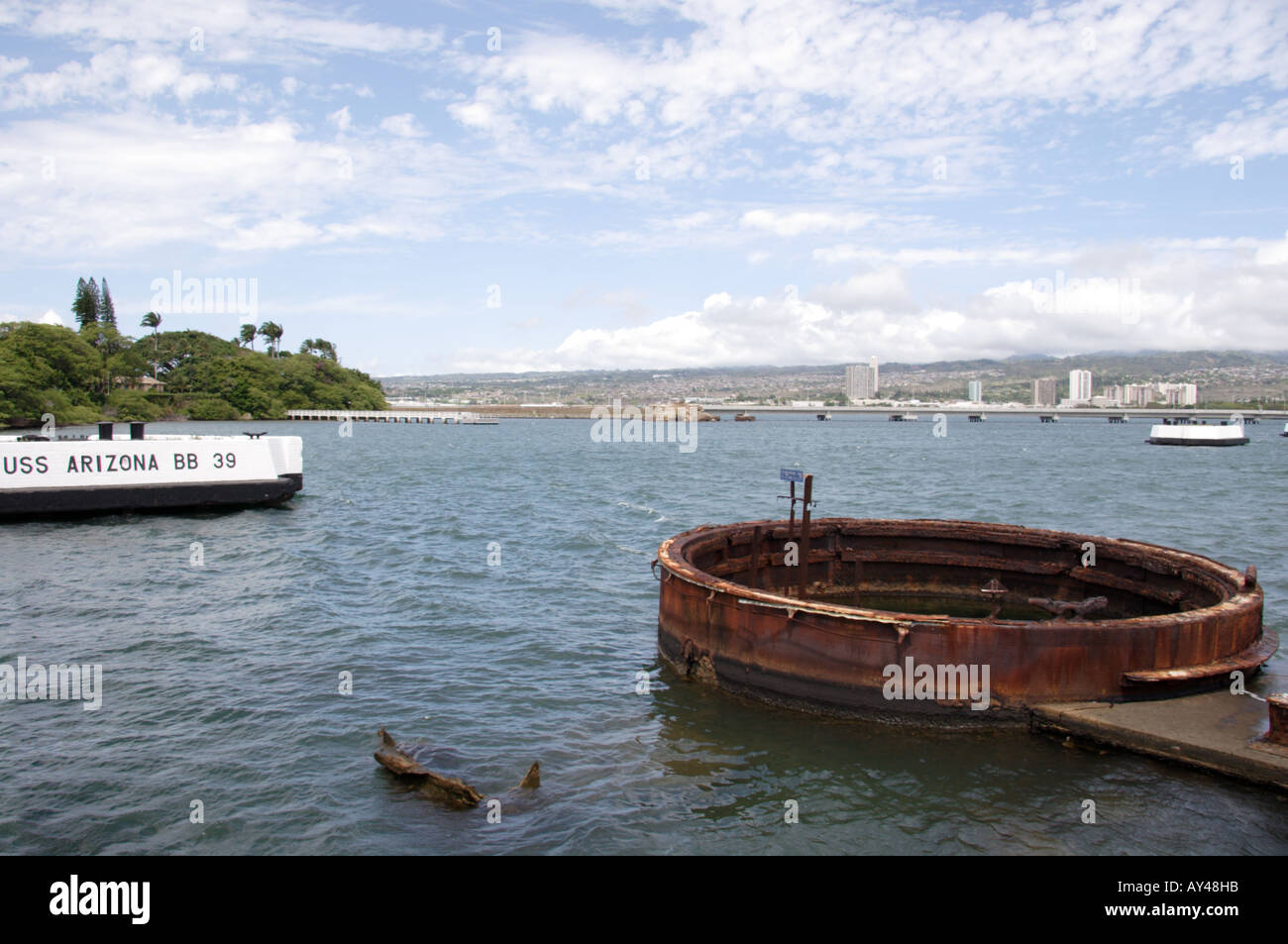 USS Arizona memorial at Pearl Harbor Hawaii Stock Photohttps://www.alamy.com/image-license-details/?v=1https://www.alamy.com/uss-arizona-memorial-at-pearl-harbor-hawaii-image9707034.html
USS Arizona memorial at Pearl Harbor Hawaii Stock Photohttps://www.alamy.com/image-license-details/?v=1https://www.alamy.com/uss-arizona-memorial-at-pearl-harbor-hawaii-image9707034.htmlRMAY48HB–USS Arizona memorial at Pearl Harbor Hawaii
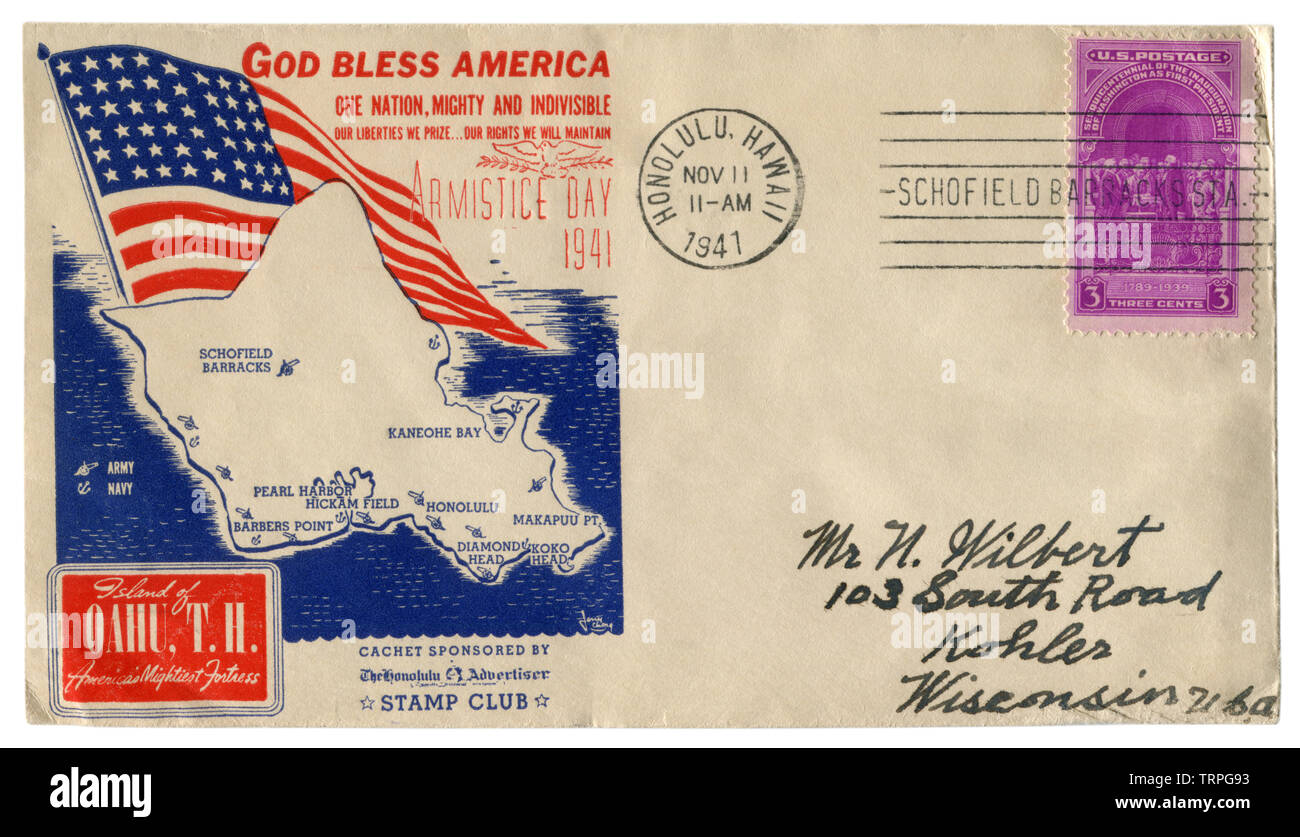 Honolulu, Hawaii, The USA, 11 November 1941: US historical envelope: cover with a patriotic cachet Armistice day, Pearl Harbor and other military base Stock Photohttps://www.alamy.com/image-license-details/?v=1https://www.alamy.com/honolulu-hawaii-the-usa-11-november-1941-us-historical-envelope-cover-with-a-patriotic-cachet-armistice-day-pearl-harbor-and-other-military-base-image255577983.html
Honolulu, Hawaii, The USA, 11 November 1941: US historical envelope: cover with a patriotic cachet Armistice day, Pearl Harbor and other military base Stock Photohttps://www.alamy.com/image-license-details/?v=1https://www.alamy.com/honolulu-hawaii-the-usa-11-november-1941-us-historical-envelope-cover-with-a-patriotic-cachet-armistice-day-pearl-harbor-and-other-military-base-image255577983.htmlRFTRPG93–Honolulu, Hawaii, The USA, 11 November 1941: US historical envelope: cover with a patriotic cachet Armistice day, Pearl Harbor and other military base
 Pearl Harbor, Hawaii: January 7, 1942 The wreckage of a Japanese torpedo plane shot down during the surprise attack on December 7 being salvaged from the bottom of Pearl Harbor. Stock Photohttps://www.alamy.com/image-license-details/?v=1https://www.alamy.com/pearl-harbor-hawaii-january-7-1942-the-wreckage-of-a-japanese-torpedo-plane-shot-down-during-the-surprise-attack-on-december-7-being-salvaged-from-the-bottom-of-pearl-harbor-image558029542.html
Pearl Harbor, Hawaii: January 7, 1942 The wreckage of a Japanese torpedo plane shot down during the surprise attack on December 7 being salvaged from the bottom of Pearl Harbor. Stock Photohttps://www.alamy.com/image-license-details/?v=1https://www.alamy.com/pearl-harbor-hawaii-january-7-1942-the-wreckage-of-a-japanese-torpedo-plane-shot-down-during-the-surprise-attack-on-december-7-being-salvaged-from-the-bottom-of-pearl-harbor-image558029542.htmlRM2RBTCAE–Pearl Harbor, Hawaii: January 7, 1942 The wreckage of a Japanese torpedo plane shot down during the surprise attack on December 7 being salvaged from the bottom of Pearl Harbor.
 Submarine USS Bowfin. Pearl Harbon. Oahu, Hawaii, USA, EEUU.. Stock Photohttps://www.alamy.com/image-license-details/?v=1https://www.alamy.com/stock-image-submarine-uss-bowfin-pearl-harbon-oahu-hawaii-usa-eeuu-166357176.html
Submarine USS Bowfin. Pearl Harbon. Oahu, Hawaii, USA, EEUU.. Stock Photohttps://www.alamy.com/image-license-details/?v=1https://www.alamy.com/stock-image-submarine-uss-bowfin-pearl-harbon-oahu-hawaii-usa-eeuu-166357176.htmlRFKJJ67M–Submarine USS Bowfin. Pearl Harbon. Oahu, Hawaii, USA, EEUU..
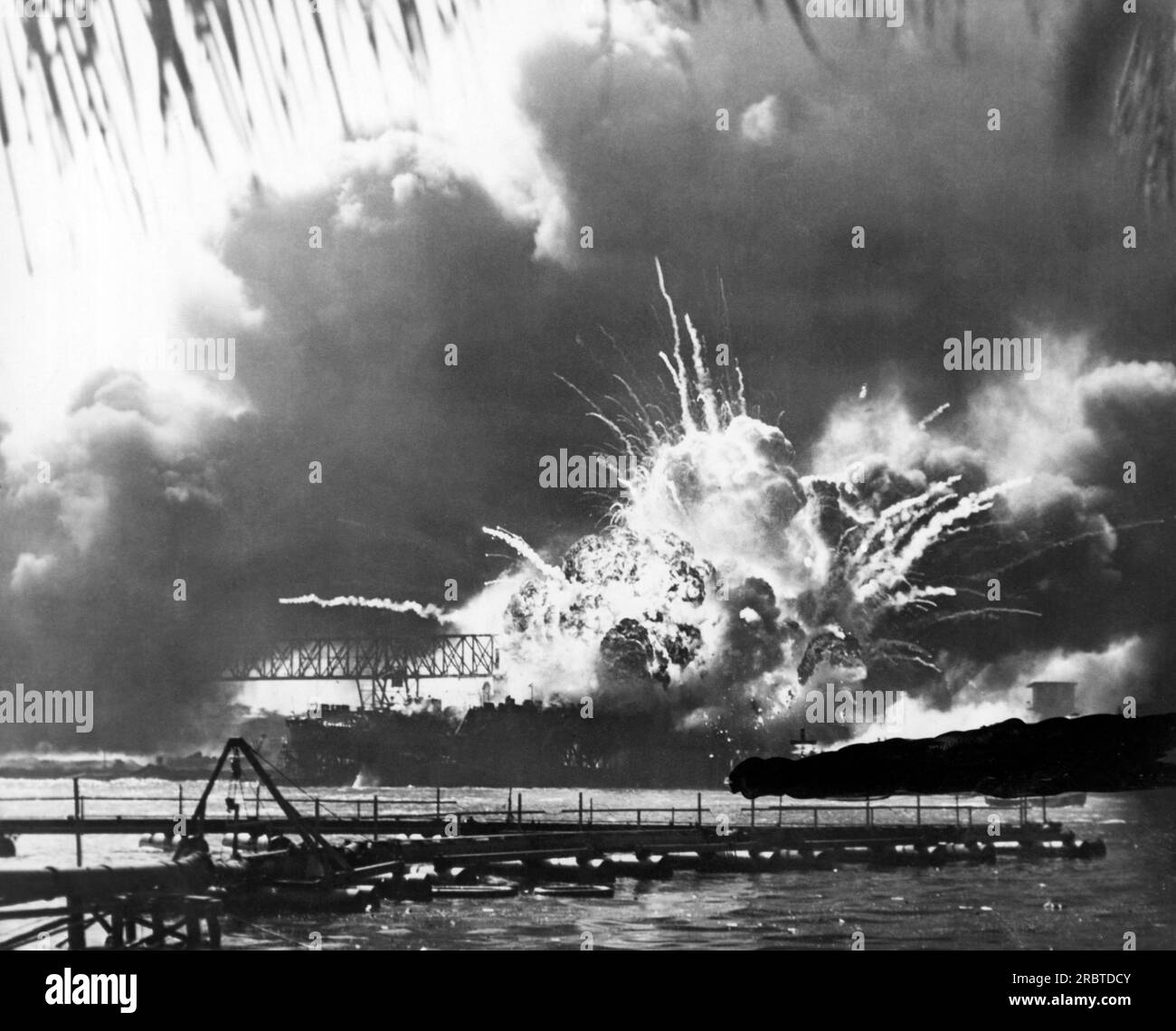 Pearl Harbor, Hawaii: December 7th, 1941 The USS Shaw at the moment of the destroyer's magazine explosion at Pearl Harbor. Stock Photohttps://www.alamy.com/image-license-details/?v=1https://www.alamy.com/pearl-harbor-hawaii-december-7th-1941-the-uss-shaw-at-the-moment-of-the-destroyers-magazine-explosion-at-pearl-harbor-image558030395.html
Pearl Harbor, Hawaii: December 7th, 1941 The USS Shaw at the moment of the destroyer's magazine explosion at Pearl Harbor. Stock Photohttps://www.alamy.com/image-license-details/?v=1https://www.alamy.com/pearl-harbor-hawaii-december-7th-1941-the-uss-shaw-at-the-moment-of-the-destroyers-magazine-explosion-at-pearl-harbor-image558030395.htmlRM2RBTDCY–Pearl Harbor, Hawaii: December 7th, 1941 The USS Shaw at the moment of the destroyer's magazine explosion at Pearl Harbor.
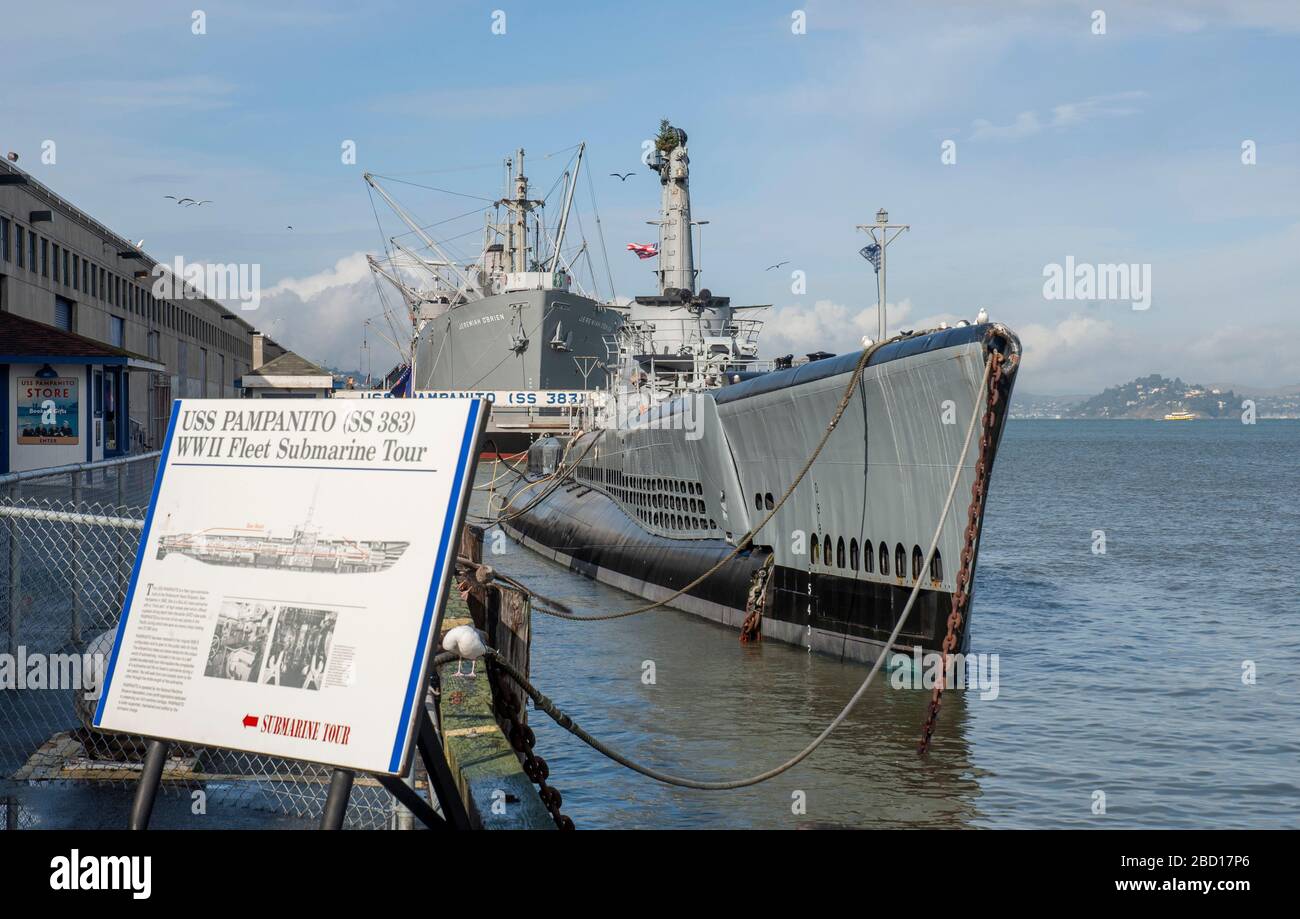 USS Pampanito San Francisco California USA Stock Photohttps://www.alamy.com/image-license-details/?v=1https://www.alamy.com/uss-pampanito-san-francisco-california-usa-image352225950.html
USS Pampanito San Francisco California USA Stock Photohttps://www.alamy.com/image-license-details/?v=1https://www.alamy.com/uss-pampanito-san-francisco-california-usa-image352225950.htmlRM2BD17P6–USS Pampanito San Francisco California USA
 Oahu, Hawaii December, 1941 Seamen at Kaneohe Naval Air Station decorate the graves of their fellow sailors killed at Pearl Harbor on December 7, 1941 Stock Photohttps://www.alamy.com/image-license-details/?v=1https://www.alamy.com/oahu-hawaii-december-1941-seamen-at-kaneohe-naval-air-station-decorate-the-graves-of-their-fellow-sailors-killed-at-pearl-harbor-on-december-7-1941-image566080720.html
Oahu, Hawaii December, 1941 Seamen at Kaneohe Naval Air Station decorate the graves of their fellow sailors killed at Pearl Harbor on December 7, 1941 Stock Photohttps://www.alamy.com/image-license-details/?v=1https://www.alamy.com/oahu-hawaii-december-1941-seamen-at-kaneohe-naval-air-station-decorate-the-graves-of-their-fellow-sailors-killed-at-pearl-harbor-on-december-7-1941-image566080720.htmlRM2RTY5MG–Oahu, Hawaii December, 1941 Seamen at Kaneohe Naval Air Station decorate the graves of their fellow sailors killed at Pearl Harbor on December 7, 1941
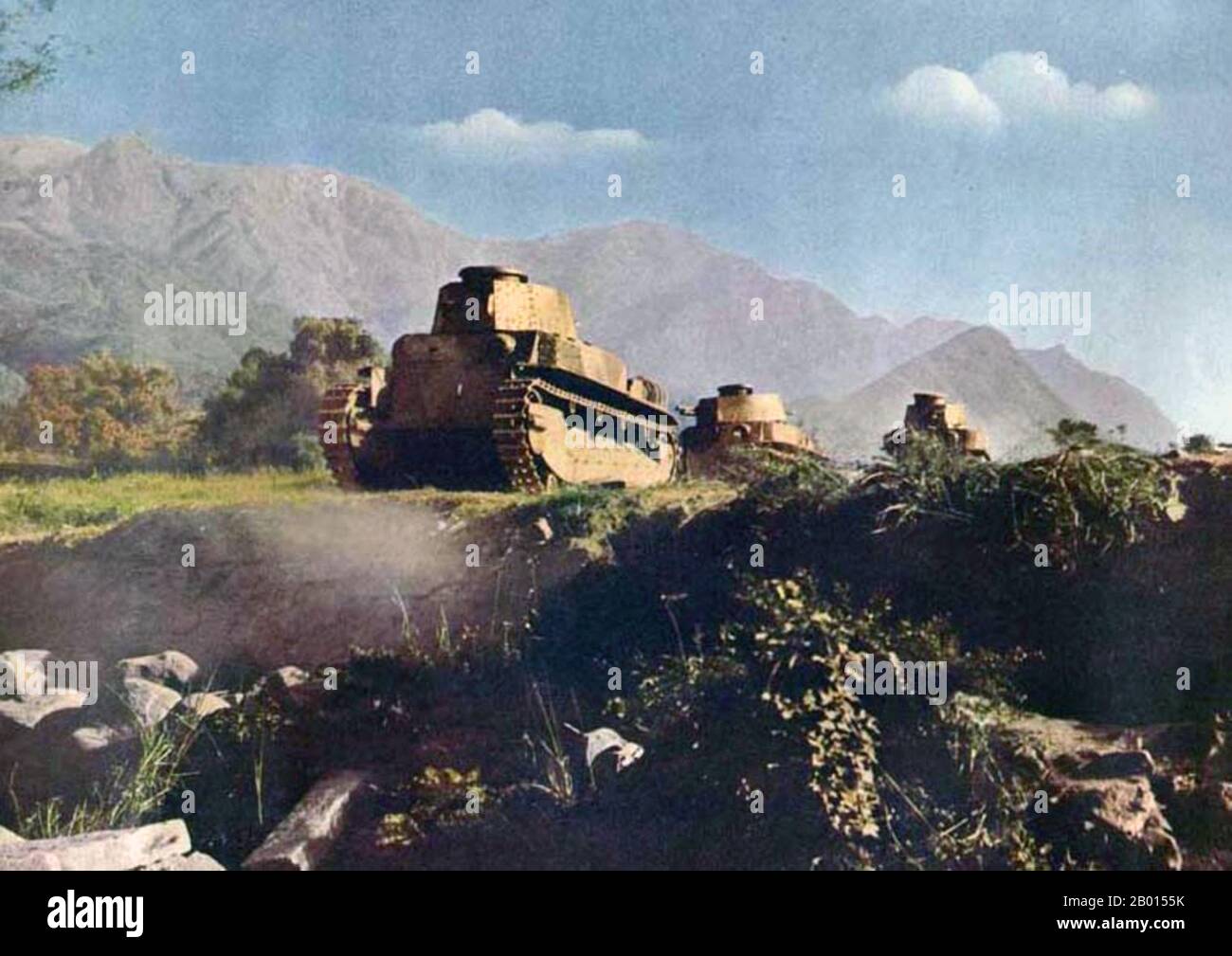 China: Japanese tanks preparing to go into battle. Second Sino-Japanese War (July 7, 1937 – September 9, 1945). The Second Sino-Japanese War was a military conflict fought primarily between the Republic of China and the Empire of Japan. After the Japanese attack on Pearl Harbor, the war merged into the greater conflict of World War II as a major front of what is broadly known as the Pacific War. Although the two countries had fought intermittently since 1931, total war started in earnest in 1937 and ended only with the surrender of Japan in 1945. Stock Photohttps://www.alamy.com/image-license-details/?v=1https://www.alamy.com/china-japanese-tanks-preparing-to-go-into-battle-second-sino-japanese-war-july-7-1937-september-9-1945-the-second-sino-japanese-war-was-a-military-conflict-fought-primarily-between-the-republic-of-china-and-the-empire-of-japan-after-the-japanese-attack-on-pearl-harbor-the-war-merged-into-the-greater-conflict-of-world-war-ii-as-a-major-front-of-what-is-broadly-known-as-the-pacific-war-although-the-two-countries-had-fought-intermittently-since-1931-total-war-started-in-earnest-in-1937-and-ended-only-with-the-surrender-of-japan-in-1945-image344233391.html
China: Japanese tanks preparing to go into battle. Second Sino-Japanese War (July 7, 1937 – September 9, 1945). The Second Sino-Japanese War was a military conflict fought primarily between the Republic of China and the Empire of Japan. After the Japanese attack on Pearl Harbor, the war merged into the greater conflict of World War II as a major front of what is broadly known as the Pacific War. Although the two countries had fought intermittently since 1931, total war started in earnest in 1937 and ended only with the surrender of Japan in 1945. Stock Photohttps://www.alamy.com/image-license-details/?v=1https://www.alamy.com/china-japanese-tanks-preparing-to-go-into-battle-second-sino-japanese-war-july-7-1937-september-9-1945-the-second-sino-japanese-war-was-a-military-conflict-fought-primarily-between-the-republic-of-china-and-the-empire-of-japan-after-the-japanese-attack-on-pearl-harbor-the-war-merged-into-the-greater-conflict-of-world-war-ii-as-a-major-front-of-what-is-broadly-known-as-the-pacific-war-although-the-two-countries-had-fought-intermittently-since-1931-total-war-started-in-earnest-in-1937-and-ended-only-with-the-surrender-of-japan-in-1945-image344233391.htmlRM2B0155K–China: Japanese tanks preparing to go into battle. Second Sino-Japanese War (July 7, 1937 – September 9, 1945). The Second Sino-Japanese War was a military conflict fought primarily between the Republic of China and the Empire of Japan. After the Japanese attack on Pearl Harbor, the war merged into the greater conflict of World War II as a major front of what is broadly known as the Pacific War. Although the two countries had fought intermittently since 1931, total war started in earnest in 1937 and ended only with the surrender of Japan in 1945.
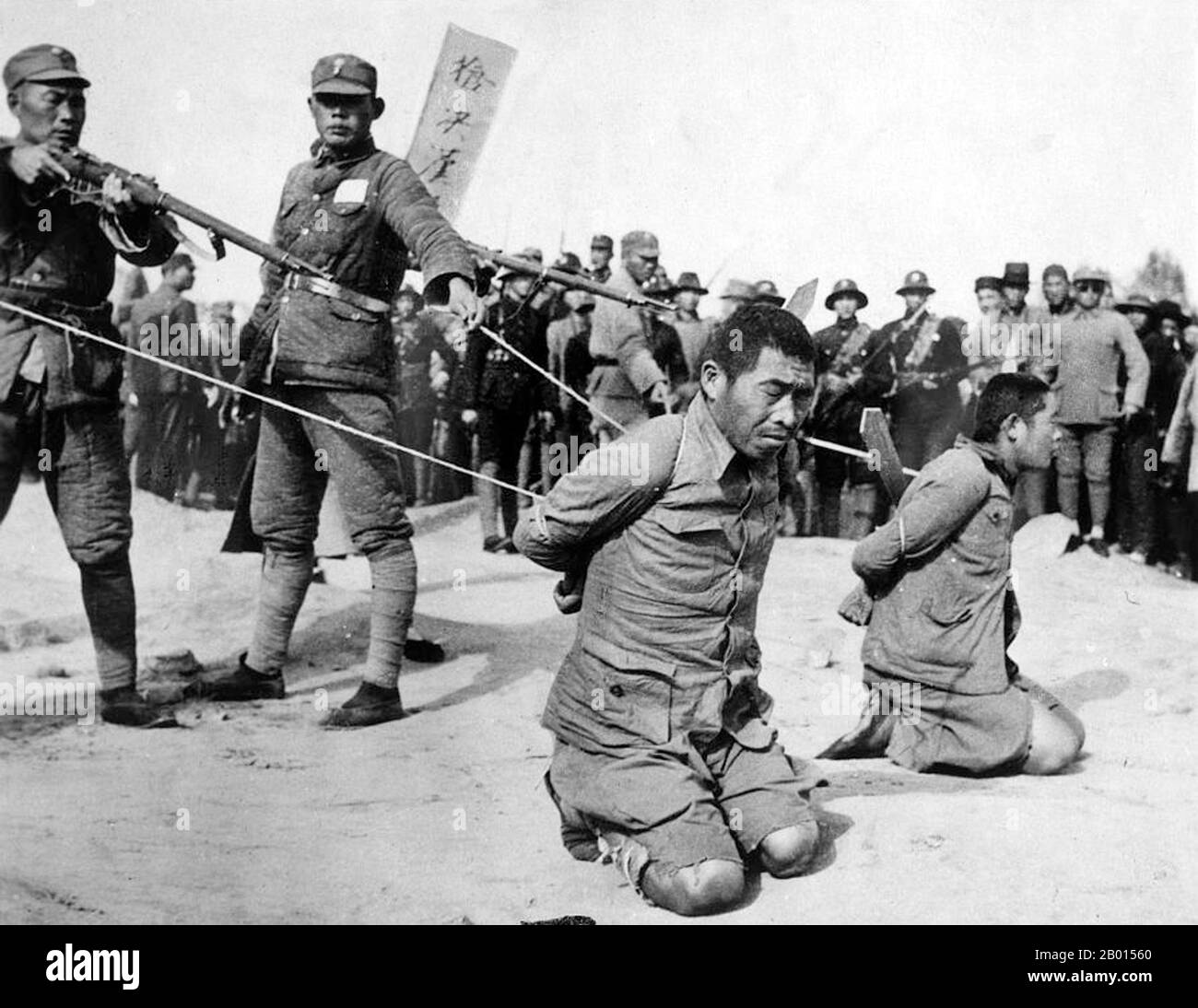 China: Execution of Chinese collaborators by Nationalist troops, Shanghai, 1937. Second Sino-Japanese War (July 7, 1937 – September 9, 1945). The Second Sino-Japanese War was a military conflict fought primarily between the Republic of China and the Empire of Japan. After the Japanese attack on Pearl Harbor, the war merged into the greater conflict of World War II as a major front of what is broadly known as the Pacific War. Although the two countries had fought intermittently since 1931, total war started in earnest in 1937 and ended only with the surrender of Japan in 1945. Stock Photohttps://www.alamy.com/image-license-details/?v=1https://www.alamy.com/china-execution-of-chinese-collaborators-by-nationalist-troops-shanghai-1937-second-sino-japanese-war-july-7-1937-september-9-1945-the-second-sino-japanese-war-was-a-military-conflict-fought-primarily-between-the-republic-of-china-and-the-empire-of-japan-after-the-japanese-attack-on-pearl-harbor-the-war-merged-into-the-greater-conflict-of-world-war-ii-as-a-major-front-of-what-is-broadly-known-as-the-pacific-war-although-the-two-countries-had-fought-intermittently-since-1931-total-war-started-in-earnest-in-1937-and-ended-only-with-the-surrender-of-japan-in-1945-image344233400.html
China: Execution of Chinese collaborators by Nationalist troops, Shanghai, 1937. Second Sino-Japanese War (July 7, 1937 – September 9, 1945). The Second Sino-Japanese War was a military conflict fought primarily between the Republic of China and the Empire of Japan. After the Japanese attack on Pearl Harbor, the war merged into the greater conflict of World War II as a major front of what is broadly known as the Pacific War. Although the two countries had fought intermittently since 1931, total war started in earnest in 1937 and ended only with the surrender of Japan in 1945. Stock Photohttps://www.alamy.com/image-license-details/?v=1https://www.alamy.com/china-execution-of-chinese-collaborators-by-nationalist-troops-shanghai-1937-second-sino-japanese-war-july-7-1937-september-9-1945-the-second-sino-japanese-war-was-a-military-conflict-fought-primarily-between-the-republic-of-china-and-the-empire-of-japan-after-the-japanese-attack-on-pearl-harbor-the-war-merged-into-the-greater-conflict-of-world-war-ii-as-a-major-front-of-what-is-broadly-known-as-the-pacific-war-although-the-two-countries-had-fought-intermittently-since-1931-total-war-started-in-earnest-in-1937-and-ended-only-with-the-surrender-of-japan-in-1945-image344233400.htmlRM2B01560–China: Execution of Chinese collaborators by Nationalist troops, Shanghai, 1937. Second Sino-Japanese War (July 7, 1937 – September 9, 1945). The Second Sino-Japanese War was a military conflict fought primarily between the Republic of China and the Empire of Japan. After the Japanese attack on Pearl Harbor, the war merged into the greater conflict of World War II as a major front of what is broadly known as the Pacific War. Although the two countries had fought intermittently since 1931, total war started in earnest in 1937 and ended only with the surrender of Japan in 1945.
 An American WW2 poster using patriotic slogans to gain support for the war effort saying Avenge December 7 (Pearl Harbor attack) Stock Photohttps://www.alamy.com/image-license-details/?v=1https://www.alamy.com/an-american-ww2-poster-using-patriotic-slogans-to-gain-support-for-the-war-effort-saying-avenge-december-7-pearl-harbor-attack-image418855607.html
An American WW2 poster using patriotic slogans to gain support for the war effort saying Avenge December 7 (Pearl Harbor attack) Stock Photohttps://www.alamy.com/image-license-details/?v=1https://www.alamy.com/an-american-ww2-poster-using-patriotic-slogans-to-gain-support-for-the-war-effort-saying-avenge-december-7-pearl-harbor-attack-image418855607.htmlRM2F9CEGR–An American WW2 poster using patriotic slogans to gain support for the war effort saying Avenge December 7 (Pearl Harbor attack)
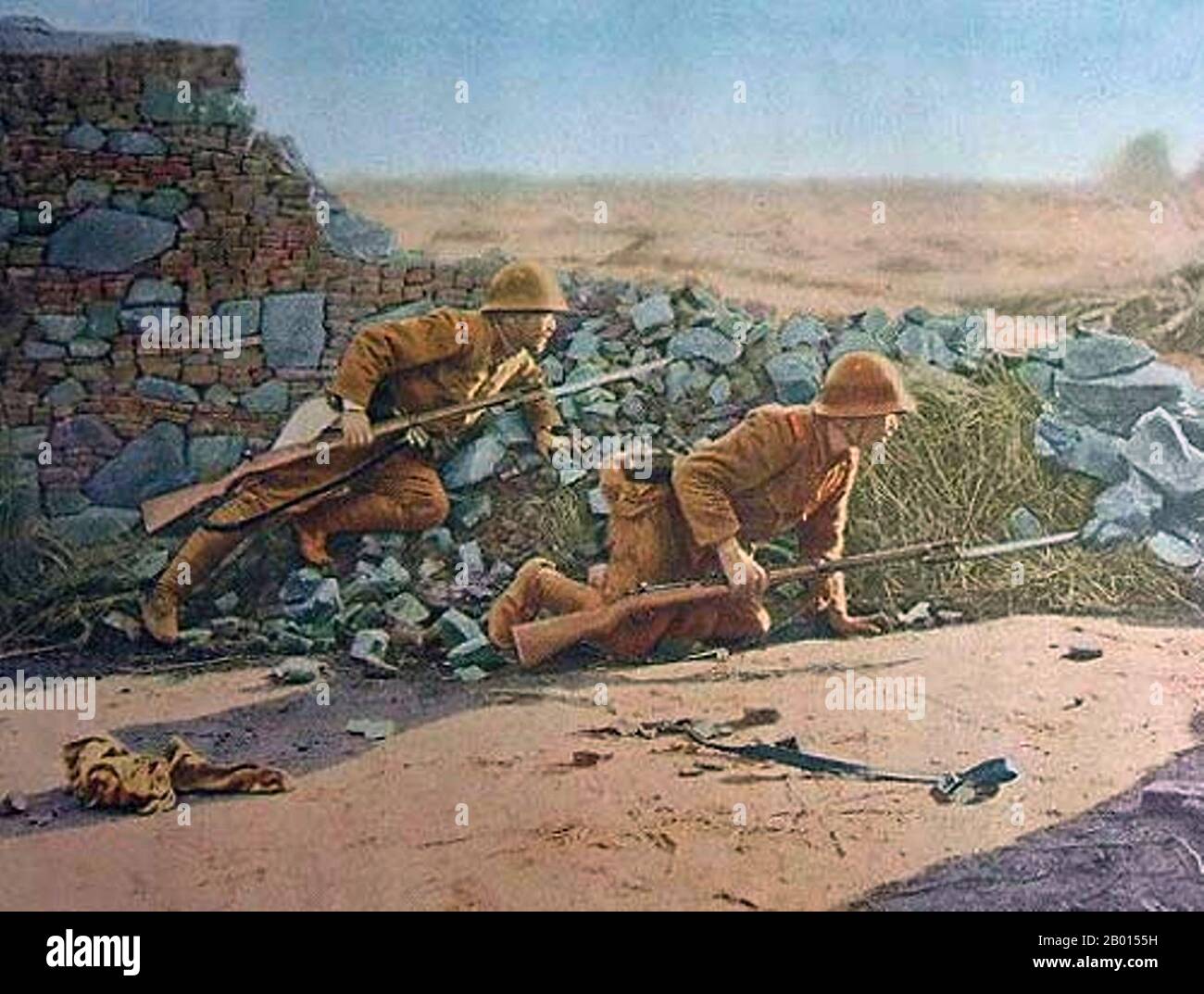 China: Second Sino-Japanese War (7 July 1937 – 9 September 1945). Japanese troops await Chinese attack. The Second Sino-Japanese War was a military conflict fought primarily between the Republic of China and the Empire of Japan. After the Japanese attack on Pearl Harbor, the war merged into the greater conflict of World War II as a major front of what is broadly known as the Pacific War. Although the two countries had fought intermittently since 1931, total war started in earnest in 1937 and ended only with the surrender of Japan in 1945. Stock Photohttps://www.alamy.com/image-license-details/?v=1https://www.alamy.com/china-second-sino-japanese-war-7-july-1937-9-september-1945-japanese-troops-await-chinese-attack-the-second-sino-japanese-war-was-a-military-conflict-fought-primarily-between-the-republic-of-china-and-the-empire-of-japan-after-the-japanese-attack-on-pearl-harbor-the-war-merged-into-the-greater-conflict-of-world-war-ii-as-a-major-front-of-what-is-broadly-known-as-the-pacific-war-although-the-two-countries-had-fought-intermittently-since-1931-total-war-started-in-earnest-in-1937-and-ended-only-with-the-surrender-of-japan-in-1945-image344233389.html
China: Second Sino-Japanese War (7 July 1937 – 9 September 1945). Japanese troops await Chinese attack. The Second Sino-Japanese War was a military conflict fought primarily between the Republic of China and the Empire of Japan. After the Japanese attack on Pearl Harbor, the war merged into the greater conflict of World War II as a major front of what is broadly known as the Pacific War. Although the two countries had fought intermittently since 1931, total war started in earnest in 1937 and ended only with the surrender of Japan in 1945. Stock Photohttps://www.alamy.com/image-license-details/?v=1https://www.alamy.com/china-second-sino-japanese-war-7-july-1937-9-september-1945-japanese-troops-await-chinese-attack-the-second-sino-japanese-war-was-a-military-conflict-fought-primarily-between-the-republic-of-china-and-the-empire-of-japan-after-the-japanese-attack-on-pearl-harbor-the-war-merged-into-the-greater-conflict-of-world-war-ii-as-a-major-front-of-what-is-broadly-known-as-the-pacific-war-although-the-two-countries-had-fought-intermittently-since-1931-total-war-started-in-earnest-in-1937-and-ended-only-with-the-surrender-of-japan-in-1945-image344233389.htmlRM2B0155H–China: Second Sino-Japanese War (7 July 1937 – 9 September 1945). Japanese troops await Chinese attack. The Second Sino-Japanese War was a military conflict fought primarily between the Republic of China and the Empire of Japan. After the Japanese attack on Pearl Harbor, the war merged into the greater conflict of World War II as a major front of what is broadly known as the Pacific War. Although the two countries had fought intermittently since 1931, total war started in earnest in 1937 and ended only with the surrender of Japan in 1945.
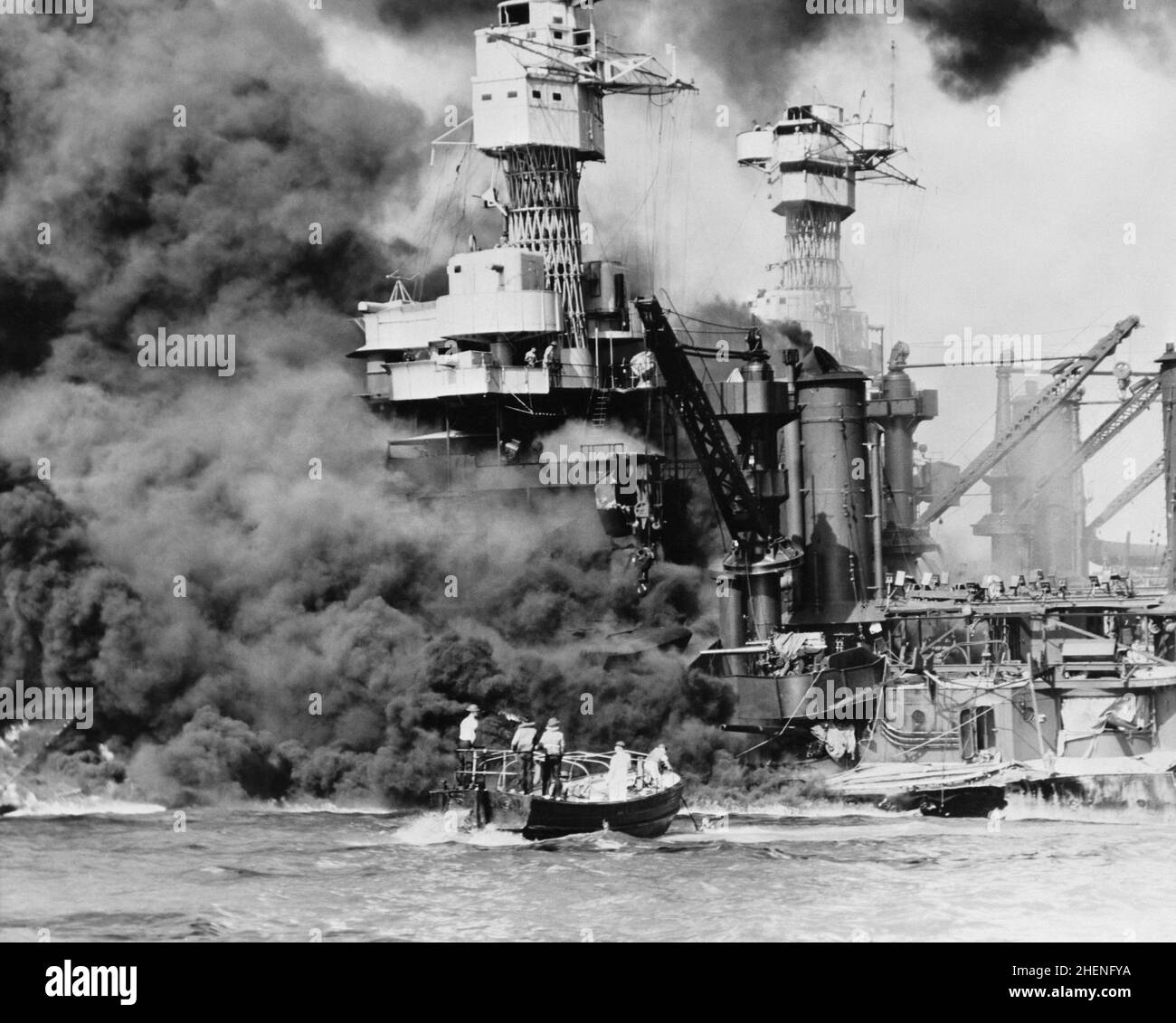 A rescue launch passing the burning wreck of the USS West Virginia during the attack on Pearl Harbor Stock Photohttps://www.alamy.com/image-license-details/?v=1https://www.alamy.com/a-rescue-launch-passing-the-burning-wreck-of-the-uss-west-virginia-during-the-attack-on-pearl-harbor-image456548270.html
A rescue launch passing the burning wreck of the USS West Virginia during the attack on Pearl Harbor Stock Photohttps://www.alamy.com/image-license-details/?v=1https://www.alamy.com/a-rescue-launch-passing-the-burning-wreck-of-the-uss-west-virginia-during-the-attack-on-pearl-harbor-image456548270.htmlRM2HENFYA–A rescue launch passing the burning wreck of the USS West Virginia during the attack on Pearl Harbor
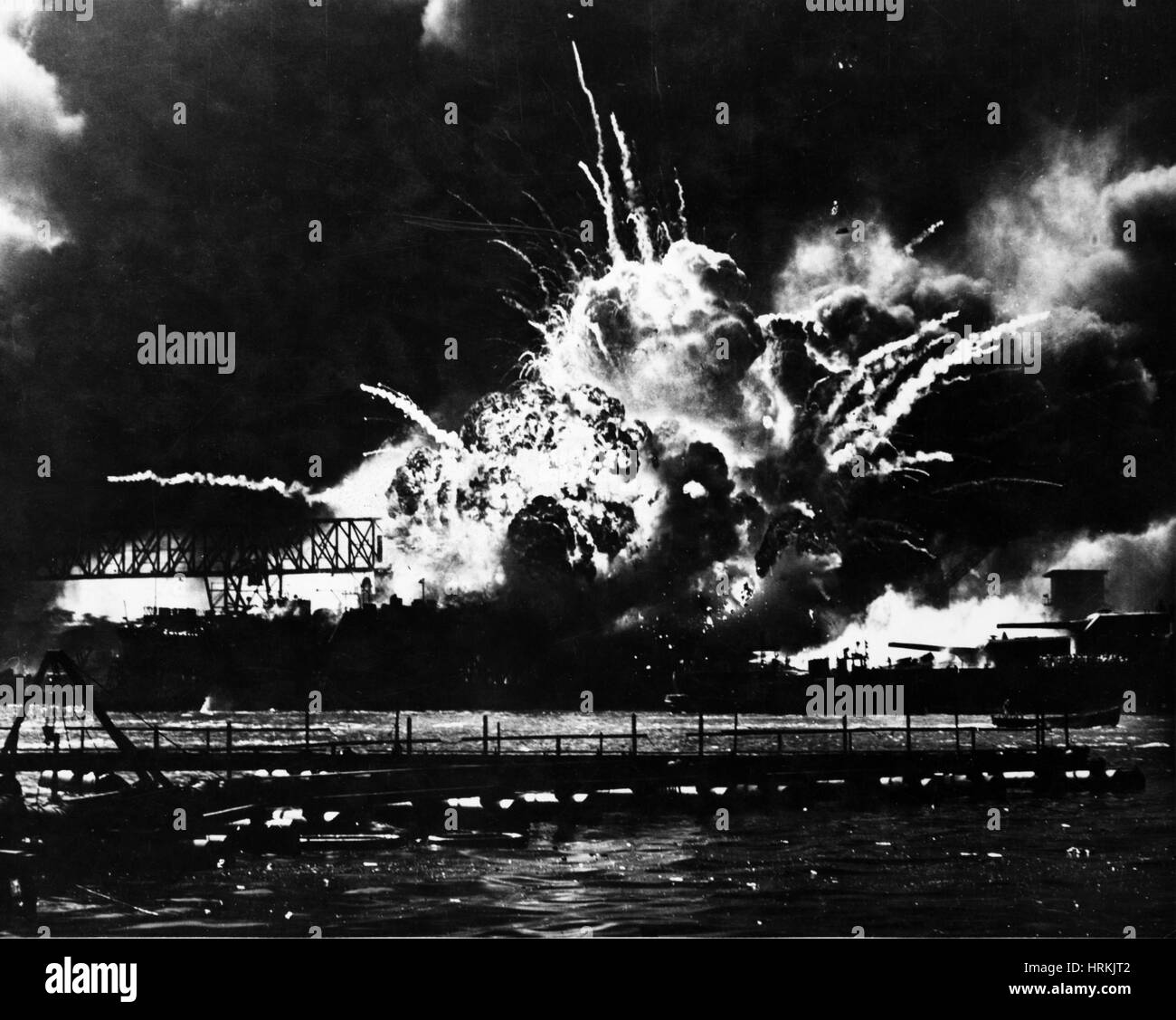 USS Shaw, Pearl Harbor, December 7, 1941 Stock Photohttps://www.alamy.com/image-license-details/?v=1https://www.alamy.com/stock-photo-uss-shaw-pearl-harbor-december-7-1941-135041538.html
USS Shaw, Pearl Harbor, December 7, 1941 Stock Photohttps://www.alamy.com/image-license-details/?v=1https://www.alamy.com/stock-photo-uss-shaw-pearl-harbor-december-7-1941-135041538.htmlRMHRKJT2–USS Shaw, Pearl Harbor, December 7, 1941
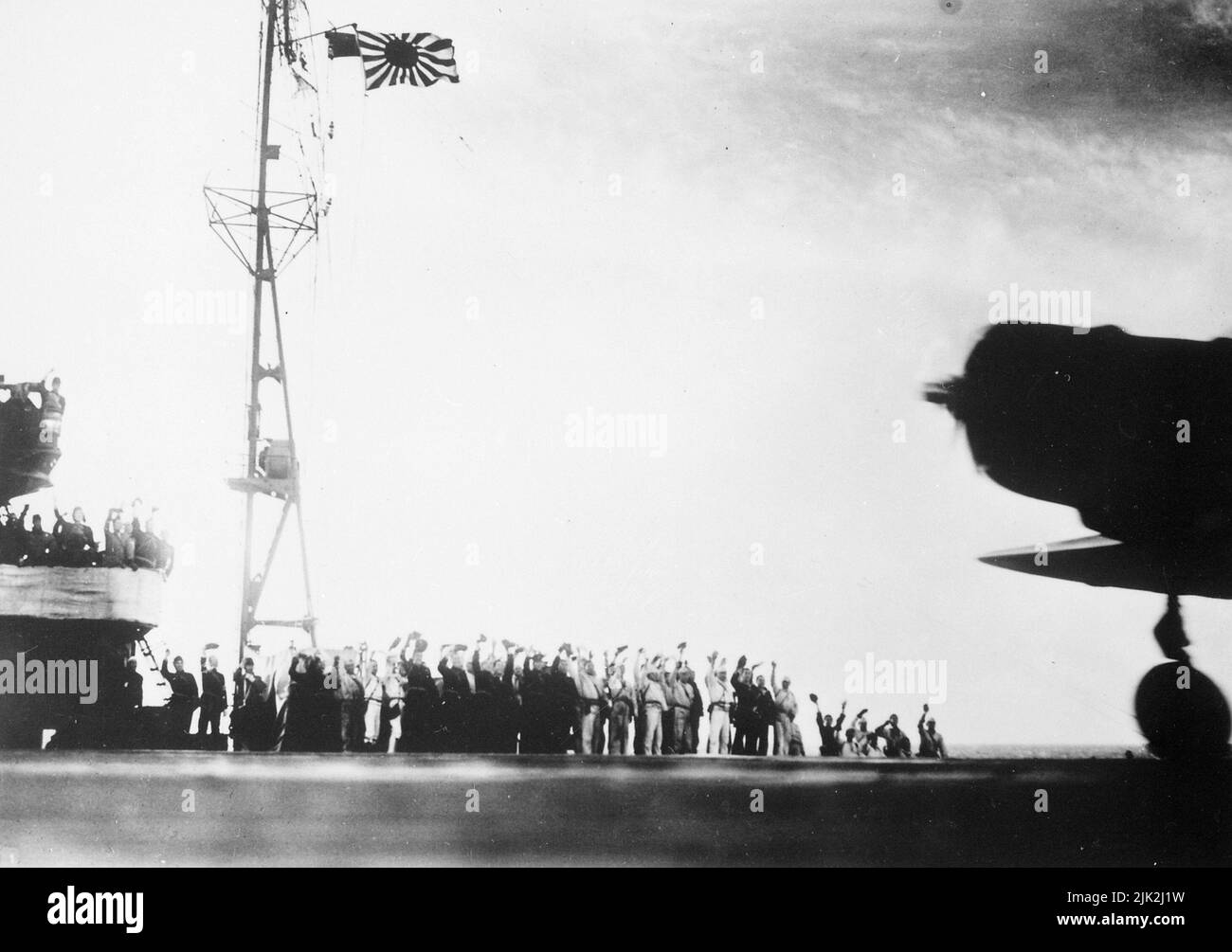 A captured Japanese photograph taken aboard a Japanese carrier before the attack on Pearl Harbor, December 7, 1941. It shows the men raising their arms in salute with the silhouette of a plane and the Rising Sun flag. The propellor on the plane is turning, so this image was possibly taken as the planes were leaving in their famous and infamous mission. Stock Photohttps://www.alamy.com/image-license-details/?v=1https://www.alamy.com/a-captured-japanese-photograph-taken-aboard-a-japanese-carrier-before-the-attack-on-pearl-harbor-december-7-1941-it-shows-the-men-raising-their-arms-in-salute-with-the-silhouette-of-a-plane-and-the-rising-sun-flag-the-propellor-on-the-plane-is-turning-so-this-image-was-possibly-taken-as-the-planes-were-leaving-in-their-famous-and-infamous-mission-image476416469.html
A captured Japanese photograph taken aboard a Japanese carrier before the attack on Pearl Harbor, December 7, 1941. It shows the men raising their arms in salute with the silhouette of a plane and the Rising Sun flag. The propellor on the plane is turning, so this image was possibly taken as the planes were leaving in their famous and infamous mission. Stock Photohttps://www.alamy.com/image-license-details/?v=1https://www.alamy.com/a-captured-japanese-photograph-taken-aboard-a-japanese-carrier-before-the-attack-on-pearl-harbor-december-7-1941-it-shows-the-men-raising-their-arms-in-salute-with-the-silhouette-of-a-plane-and-the-rising-sun-flag-the-propellor-on-the-plane-is-turning-so-this-image-was-possibly-taken-as-the-planes-were-leaving-in-their-famous-and-infamous-mission-image476416469.htmlRM2JK2J1W–A captured Japanese photograph taken aboard a Japanese carrier before the attack on Pearl Harbor, December 7, 1941. It shows the men raising their arms in salute with the silhouette of a plane and the Rising Sun flag. The propellor on the plane is turning, so this image was possibly taken as the planes were leaving in their famous and infamous mission.
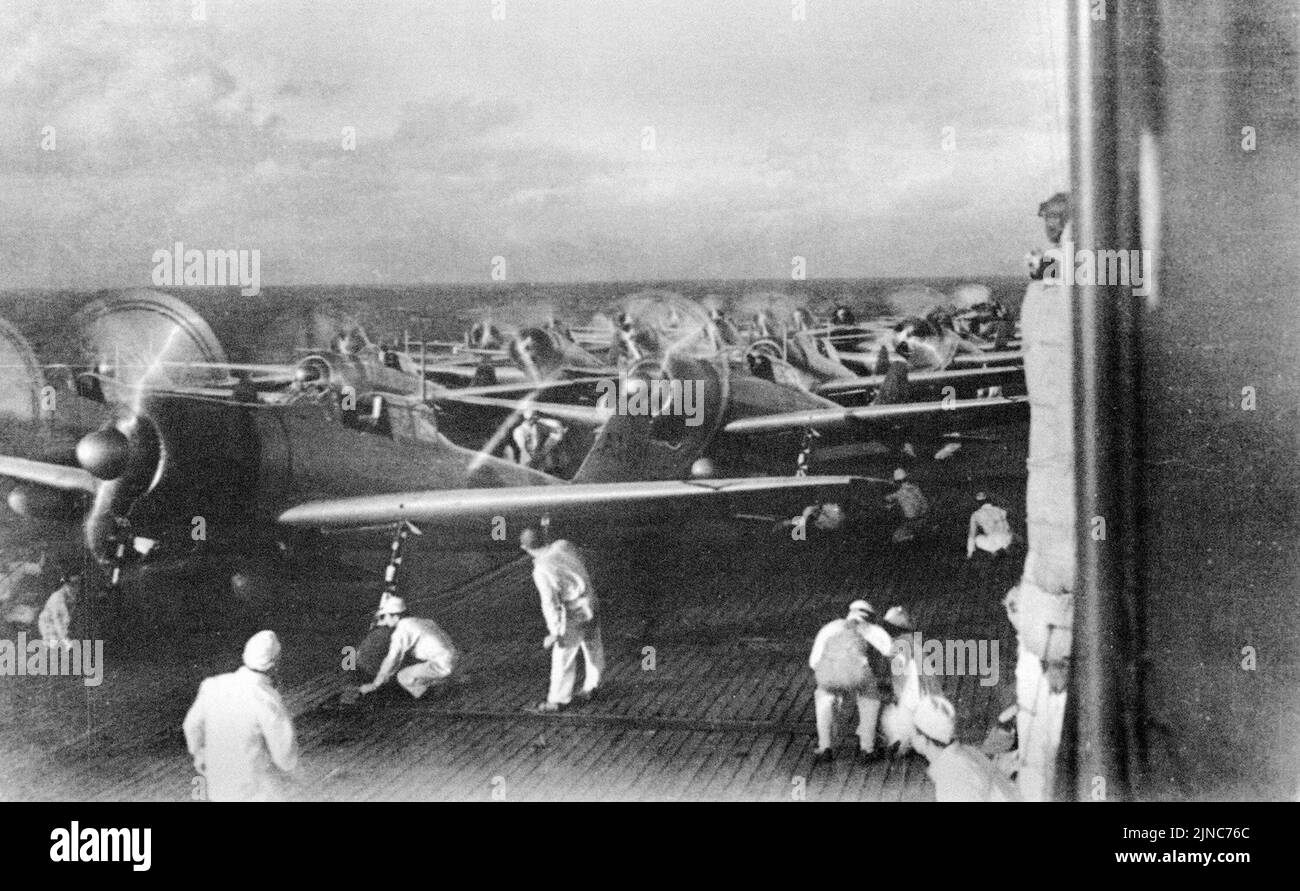 A6M2 Zero fighters prepare to launch from Akagi as part of the second wave during the attack on Pearl Harbor Stock Photohttps://www.alamy.com/image-license-details/?v=1https://www.alamy.com/a6m2-zero-fighters-prepare-to-launch-from-akagi-as-part-of-the-second-wave-during-the-attack-on-pearl-harbor-image477856804.html
A6M2 Zero fighters prepare to launch from Akagi as part of the second wave during the attack on Pearl Harbor Stock Photohttps://www.alamy.com/image-license-details/?v=1https://www.alamy.com/a6m2-zero-fighters-prepare-to-launch-from-akagi-as-part-of-the-second-wave-during-the-attack-on-pearl-harbor-image477856804.htmlRM2JNC76C–A6M2 Zero fighters prepare to launch from Akagi as part of the second wave during the attack on Pearl Harbor
 New York, USA. 7th December 2019. Armando “Chick” Galella (second from left), 98, and Rev. James E. Blakely (in wheelchair),100, both Pearl Harbor survivor, throw a ceremonial wreath into the Hudson river to commemorate the 78th Anniversary of the Attacks on Pearl Harbor, at the Intrepid Sea, Air & Space Museum, New York, NY, December 7, 2019. The suprise attack on Pearl Harbor by Japan on the morning of December 7, 1941 moved the United Staes to join World War II. (Photo by Anthony Behar/Sipa USA) Stock Photohttps://www.alamy.com/image-license-details/?v=1https://www.alamy.com/new-york-usa-7th-december-2019-armando-chick-galella-second-from-left-98-and-rev-james-e-blakely-in-wheelchair100-both-pearl-harbor-survivor-throw-a-ceremonial-wreath-into-the-hudson-river-to-commemorate-the-78th-anniversary-of-the-attacks-on-pearl-harbor-at-the-intrepid-sea-air-space-museum-new-york-ny-december-7-2019-the-suprise-attack-on-pearl-harbor-by-japan-on-the-morning-of-december-7-1941-moved-the-united-staes-to-join-world-war-ii-photo-by-anthony-beharsipa-usa-image335797866.html
New York, USA. 7th December 2019. Armando “Chick” Galella (second from left), 98, and Rev. James E. Blakely (in wheelchair),100, both Pearl Harbor survivor, throw a ceremonial wreath into the Hudson river to commemorate the 78th Anniversary of the Attacks on Pearl Harbor, at the Intrepid Sea, Air & Space Museum, New York, NY, December 7, 2019. The suprise attack on Pearl Harbor by Japan on the morning of December 7, 1941 moved the United Staes to join World War II. (Photo by Anthony Behar/Sipa USA) Stock Photohttps://www.alamy.com/image-license-details/?v=1https://www.alamy.com/new-york-usa-7th-december-2019-armando-chick-galella-second-from-left-98-and-rev-james-e-blakely-in-wheelchair100-both-pearl-harbor-survivor-throw-a-ceremonial-wreath-into-the-hudson-river-to-commemorate-the-78th-anniversary-of-the-attacks-on-pearl-harbor-at-the-intrepid-sea-air-space-museum-new-york-ny-december-7-2019-the-suprise-attack-on-pearl-harbor-by-japan-on-the-morning-of-december-7-1941-moved-the-united-staes-to-join-world-war-ii-photo-by-anthony-beharsipa-usa-image335797866.htmlRM2AE8WGX–New York, USA. 7th December 2019. Armando “Chick” Galella (second from left), 98, and Rev. James E. Blakely (in wheelchair),100, both Pearl Harbor survivor, throw a ceremonial wreath into the Hudson river to commemorate the 78th Anniversary of the Attacks on Pearl Harbor, at the Intrepid Sea, Air & Space Museum, New York, NY, December 7, 2019. The suprise attack on Pearl Harbor by Japan on the morning of December 7, 1941 moved the United Staes to join World War II. (Photo by Anthony Behar/Sipa USA)
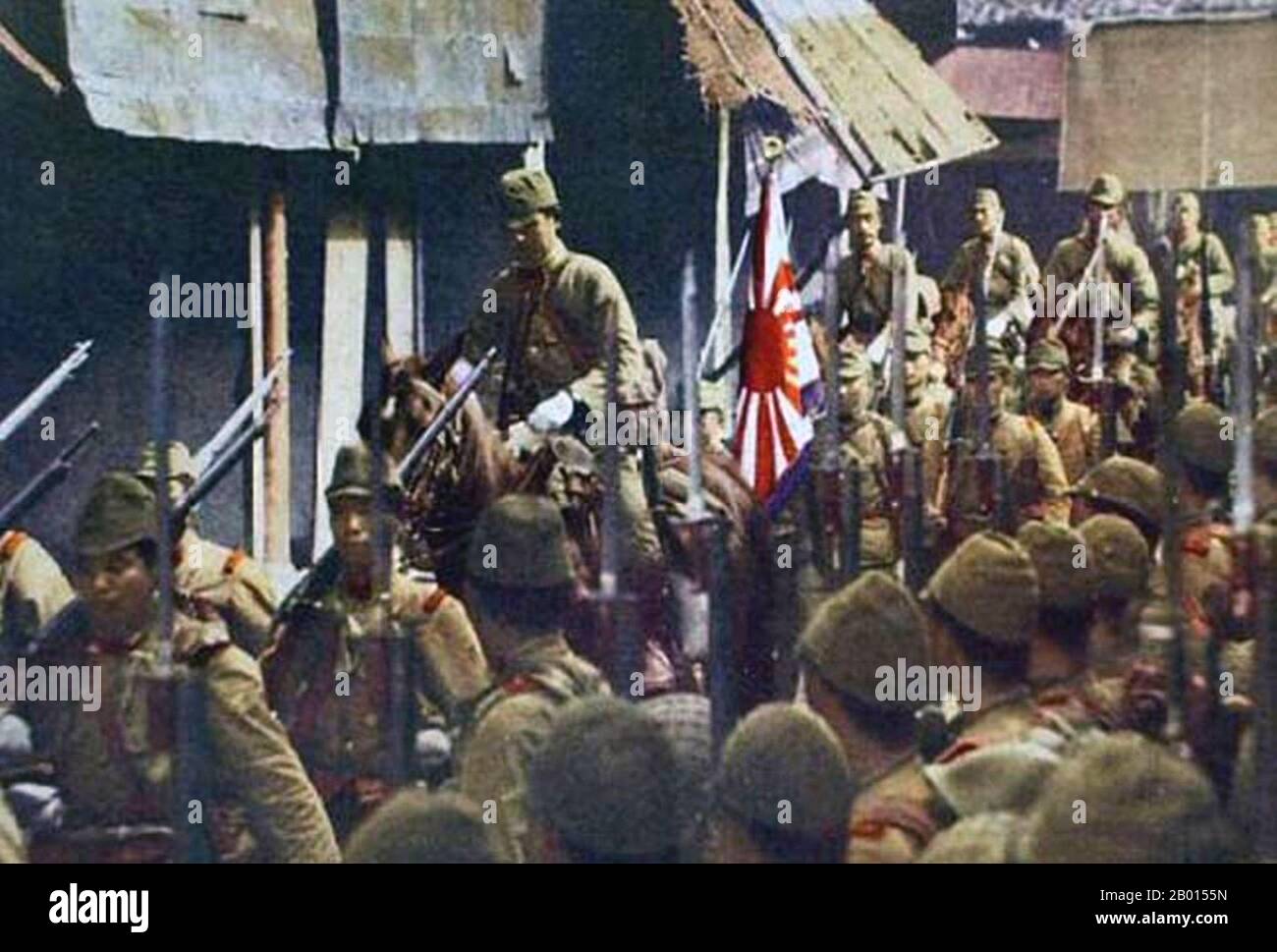 China: Japanese troops marching through an occupied Chinese town. Second Sino-Japanese War (July 7, 1937 – September 9, 1945). The Second Sino-Japanese War was a military conflict fought primarily between the Republic of China and the Empire of Japan. After the Japanese attack on Pearl Harbor, the war merged into the greater conflict of World War II as a major front of what is broadly known as the Pacific War. Although the two countries had fought intermittently since 1931, total war started in earnest in 1937 and ended only with the surrender of Japan in 1945. Stock Photohttps://www.alamy.com/image-license-details/?v=1https://www.alamy.com/china-japanese-troops-marching-through-an-occupied-chinese-town-second-sino-japanese-war-july-7-1937-september-9-1945-the-second-sino-japanese-war-was-a-military-conflict-fought-primarily-between-the-republic-of-china-and-the-empire-of-japan-after-the-japanese-attack-on-pearl-harbor-the-war-merged-into-the-greater-conflict-of-world-war-ii-as-a-major-front-of-what-is-broadly-known-as-the-pacific-war-although-the-two-countries-had-fought-intermittently-since-1931-total-war-started-in-earnest-in-1937-and-ended-only-with-the-surrender-of-japan-in-1945-image344233393.html
China: Japanese troops marching through an occupied Chinese town. Second Sino-Japanese War (July 7, 1937 – September 9, 1945). The Second Sino-Japanese War was a military conflict fought primarily between the Republic of China and the Empire of Japan. After the Japanese attack on Pearl Harbor, the war merged into the greater conflict of World War II as a major front of what is broadly known as the Pacific War. Although the two countries had fought intermittently since 1931, total war started in earnest in 1937 and ended only with the surrender of Japan in 1945. Stock Photohttps://www.alamy.com/image-license-details/?v=1https://www.alamy.com/china-japanese-troops-marching-through-an-occupied-chinese-town-second-sino-japanese-war-july-7-1937-september-9-1945-the-second-sino-japanese-war-was-a-military-conflict-fought-primarily-between-the-republic-of-china-and-the-empire-of-japan-after-the-japanese-attack-on-pearl-harbor-the-war-merged-into-the-greater-conflict-of-world-war-ii-as-a-major-front-of-what-is-broadly-known-as-the-pacific-war-although-the-two-countries-had-fought-intermittently-since-1931-total-war-started-in-earnest-in-1937-and-ended-only-with-the-surrender-of-japan-in-1945-image344233393.htmlRM2B0155N–China: Japanese troops marching through an occupied Chinese town. Second Sino-Japanese War (July 7, 1937 – September 9, 1945). The Second Sino-Japanese War was a military conflict fought primarily between the Republic of China and the Empire of Japan. After the Japanese attack on Pearl Harbor, the war merged into the greater conflict of World War II as a major front of what is broadly known as the Pacific War. Although the two countries had fought intermittently since 1931, total war started in earnest in 1937 and ended only with the surrender of Japan in 1945.
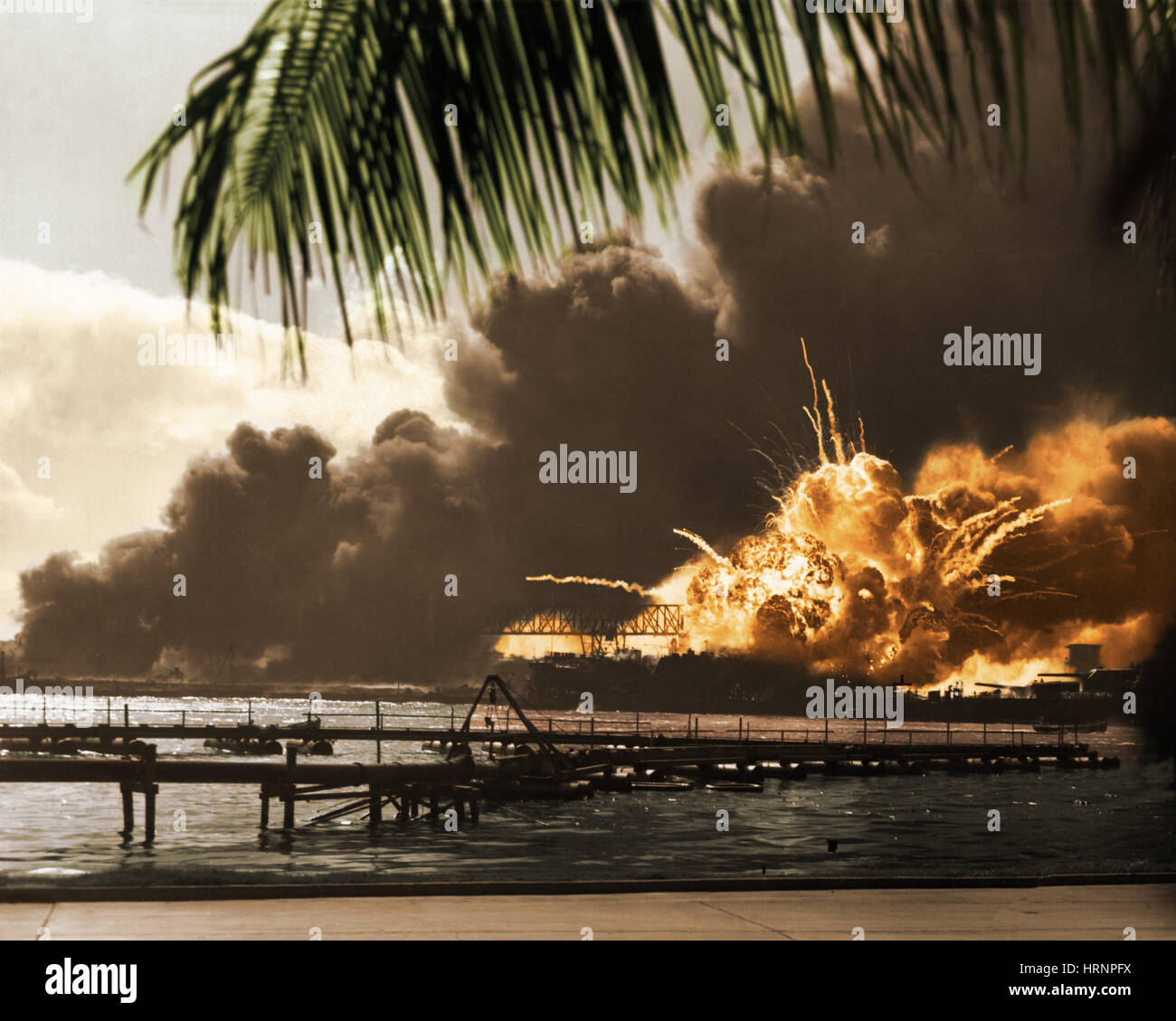 USS Shaw, Pearl Harbor, December 7, 1941 Stock Photohttps://www.alamy.com/image-license-details/?v=1https://www.alamy.com/stock-photo-uss-shaw-pearl-harbor-december-7-1941-135088350.html
USS Shaw, Pearl Harbor, December 7, 1941 Stock Photohttps://www.alamy.com/image-license-details/?v=1https://www.alamy.com/stock-photo-uss-shaw-pearl-harbor-december-7-1941-135088350.htmlRMHRNPFX–USS Shaw, Pearl Harbor, December 7, 1941
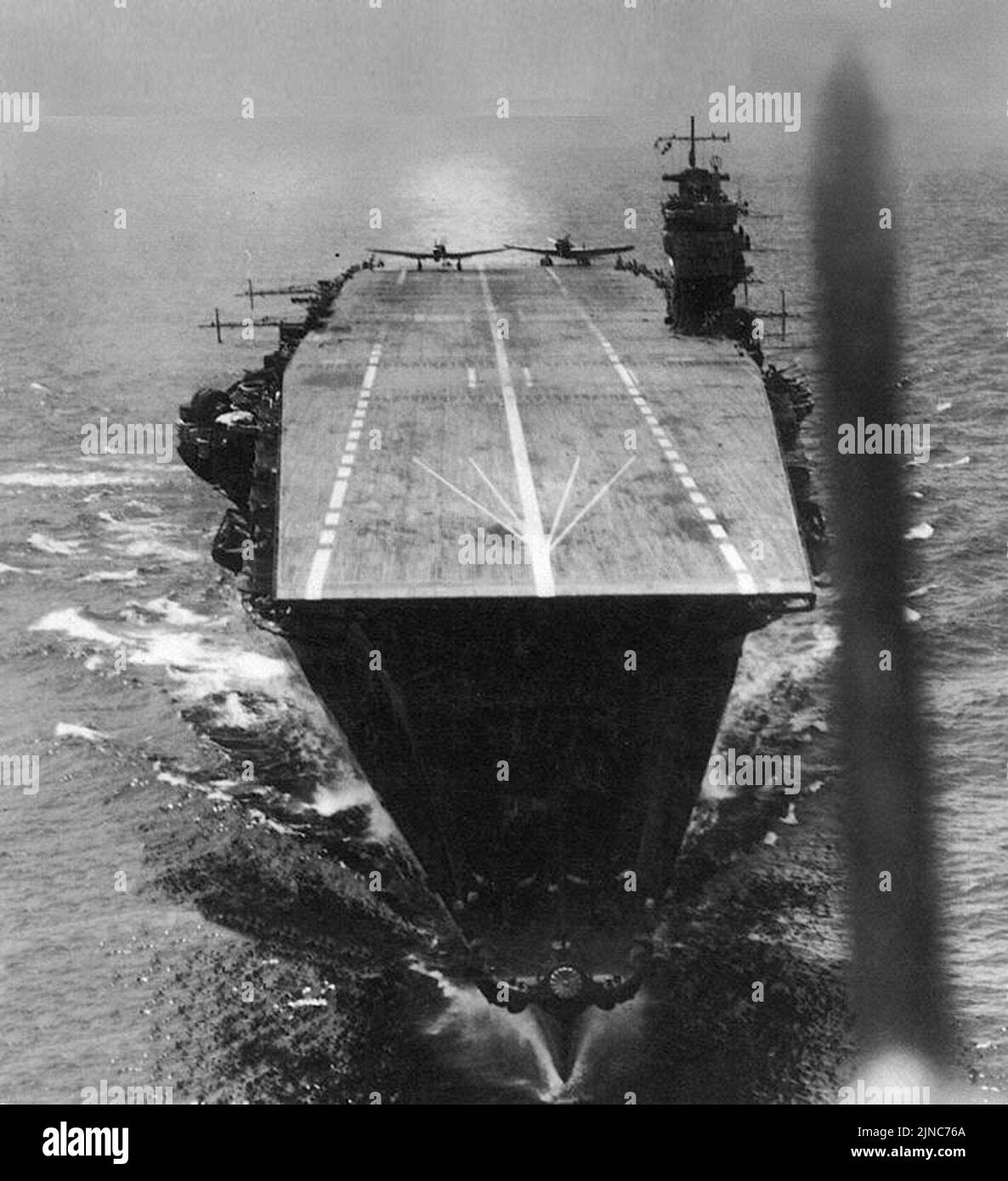 The Japanese flagship carrier Akagi as seen from a departing plane. This carrier took part in the attack on Pearl Harbor and was finally sunk at the Battle of Midway on June 1942 Stock Photohttps://www.alamy.com/image-license-details/?v=1https://www.alamy.com/the-japanese-flagship-carrier-akagi-as-seen-from-a-departing-plane-this-carrier-took-part-in-the-attack-on-pearl-harbor-and-was-finally-sunk-at-the-battle-of-midway-on-june-1942-image477856802.html
The Japanese flagship carrier Akagi as seen from a departing plane. This carrier took part in the attack on Pearl Harbor and was finally sunk at the Battle of Midway on June 1942 Stock Photohttps://www.alamy.com/image-license-details/?v=1https://www.alamy.com/the-japanese-flagship-carrier-akagi-as-seen-from-a-departing-plane-this-carrier-took-part-in-the-attack-on-pearl-harbor-and-was-finally-sunk-at-the-battle-of-midway-on-june-1942-image477856802.htmlRM2JNC76A–The Japanese flagship carrier Akagi as seen from a departing plane. This carrier took part in the attack on Pearl Harbor and was finally sunk at the Battle of Midway on June 1942
 New York, USA. 7th December 2019. Armando “Chick” Galella (second from left), 98, and Rev. James E. Blakely (in wheelchair),100, both Pearl Harbor survivor, throw a ceremonial wreath into the Hudson river to commemorate the 78th Anniversary of the Attacks on Pearl Harbor, at the Intrepid Sea, Air & Space Museum, New York, NY, December 7, 2019. The suprise attack on Pearl Harbor by Japan on the morning of December 7, 1941 moved the United Staes to join World War II. (Photo by Anthony Behar/Sipa USA) Stock Photohttps://www.alamy.com/image-license-details/?v=1https://www.alamy.com/new-york-usa-7th-december-2019-armando-chick-galella-second-from-left-98-and-rev-james-e-blakely-in-wheelchair100-both-pearl-harbor-survivor-throw-a-ceremonial-wreath-into-the-hudson-river-to-commemorate-the-78th-anniversary-of-the-attacks-on-pearl-harbor-at-the-intrepid-sea-air-space-museum-new-york-ny-december-7-2019-the-suprise-attack-on-pearl-harbor-by-japan-on-the-morning-of-december-7-1941-moved-the-united-staes-to-join-world-war-ii-photo-by-anthony-beharsipa-usa-image335797873.html
New York, USA. 7th December 2019. Armando “Chick” Galella (second from left), 98, and Rev. James E. Blakely (in wheelchair),100, both Pearl Harbor survivor, throw a ceremonial wreath into the Hudson river to commemorate the 78th Anniversary of the Attacks on Pearl Harbor, at the Intrepid Sea, Air & Space Museum, New York, NY, December 7, 2019. The suprise attack on Pearl Harbor by Japan on the morning of December 7, 1941 moved the United Staes to join World War II. (Photo by Anthony Behar/Sipa USA) Stock Photohttps://www.alamy.com/image-license-details/?v=1https://www.alamy.com/new-york-usa-7th-december-2019-armando-chick-galella-second-from-left-98-and-rev-james-e-blakely-in-wheelchair100-both-pearl-harbor-survivor-throw-a-ceremonial-wreath-into-the-hudson-river-to-commemorate-the-78th-anniversary-of-the-attacks-on-pearl-harbor-at-the-intrepid-sea-air-space-museum-new-york-ny-december-7-2019-the-suprise-attack-on-pearl-harbor-by-japan-on-the-morning-of-december-7-1941-moved-the-united-staes-to-join-world-war-ii-photo-by-anthony-beharsipa-usa-image335797873.htmlRM2AE8WH5–New York, USA. 7th December 2019. Armando “Chick” Galella (second from left), 98, and Rev. James E. Blakely (in wheelchair),100, both Pearl Harbor survivor, throw a ceremonial wreath into the Hudson river to commemorate the 78th Anniversary of the Attacks on Pearl Harbor, at the Intrepid Sea, Air & Space Museum, New York, NY, December 7, 2019. The suprise attack on Pearl Harbor by Japan on the morning of December 7, 1941 moved the United Staes to join World War II. (Photo by Anthony Behar/Sipa USA)
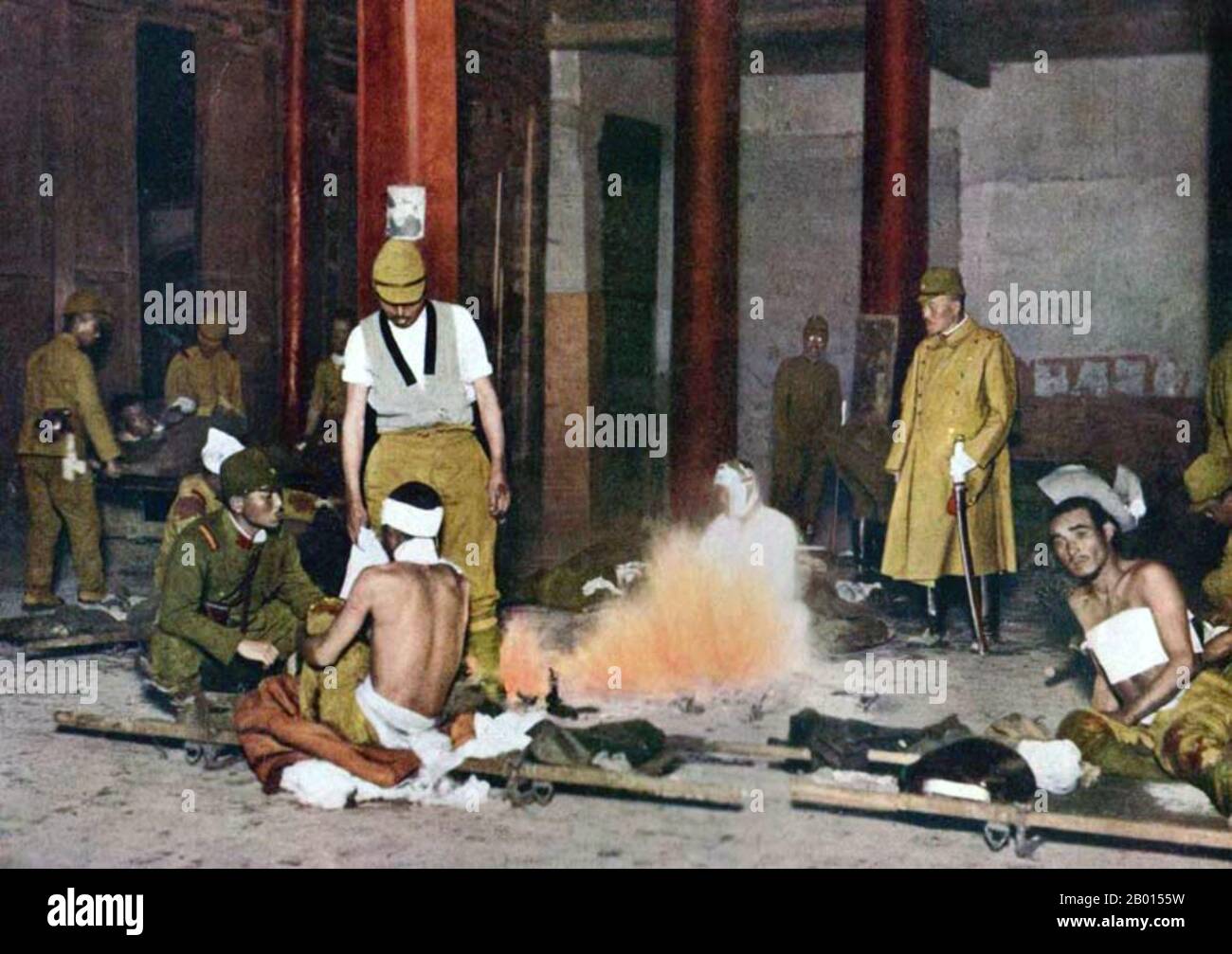 China: Improvised Japanese field hospital, Beijing, 1938. Second Sino-Japanese War (July 7, 1937 – September 9, 1945). The Second Sino-Japanese War was a military conflict fought primarily between the Republic of China and the Empire of Japan. After the Japanese attack on Pearl Harbor, the war merged into the greater conflict of World War II as a major front of what is broadly known as the Pacific War. Although the two countries had fought intermittently since 1931, total war started in earnest in 1937 and ended only with the surrender of Japan in 1945. Stock Photohttps://www.alamy.com/image-license-details/?v=1https://www.alamy.com/china-improvised-japanese-field-hospital-beijing-1938-second-sino-japanese-war-july-7-1937-september-9-1945-the-second-sino-japanese-war-was-a-military-conflict-fought-primarily-between-the-republic-of-china-and-the-empire-of-japan-after-the-japanese-attack-on-pearl-harbor-the-war-merged-into-the-greater-conflict-of-world-war-ii-as-a-major-front-of-what-is-broadly-known-as-the-pacific-war-although-the-two-countries-had-fought-intermittently-since-1931-total-war-started-in-earnest-in-1937-and-ended-only-with-the-surrender-of-japan-in-1945-image344233397.html
China: Improvised Japanese field hospital, Beijing, 1938. Second Sino-Japanese War (July 7, 1937 – September 9, 1945). The Second Sino-Japanese War was a military conflict fought primarily between the Republic of China and the Empire of Japan. After the Japanese attack on Pearl Harbor, the war merged into the greater conflict of World War II as a major front of what is broadly known as the Pacific War. Although the two countries had fought intermittently since 1931, total war started in earnest in 1937 and ended only with the surrender of Japan in 1945. Stock Photohttps://www.alamy.com/image-license-details/?v=1https://www.alamy.com/china-improvised-japanese-field-hospital-beijing-1938-second-sino-japanese-war-july-7-1937-september-9-1945-the-second-sino-japanese-war-was-a-military-conflict-fought-primarily-between-the-republic-of-china-and-the-empire-of-japan-after-the-japanese-attack-on-pearl-harbor-the-war-merged-into-the-greater-conflict-of-world-war-ii-as-a-major-front-of-what-is-broadly-known-as-the-pacific-war-although-the-two-countries-had-fought-intermittently-since-1931-total-war-started-in-earnest-in-1937-and-ended-only-with-the-surrender-of-japan-in-1945-image344233397.htmlRM2B0155W–China: Improvised Japanese field hospital, Beijing, 1938. Second Sino-Japanese War (July 7, 1937 – September 9, 1945). The Second Sino-Japanese War was a military conflict fought primarily between the Republic of China and the Empire of Japan. After the Japanese attack on Pearl Harbor, the war merged into the greater conflict of World War II as a major front of what is broadly known as the Pacific War. Although the two countries had fought intermittently since 1931, total war started in earnest in 1937 and ended only with the surrender of Japan in 1945.
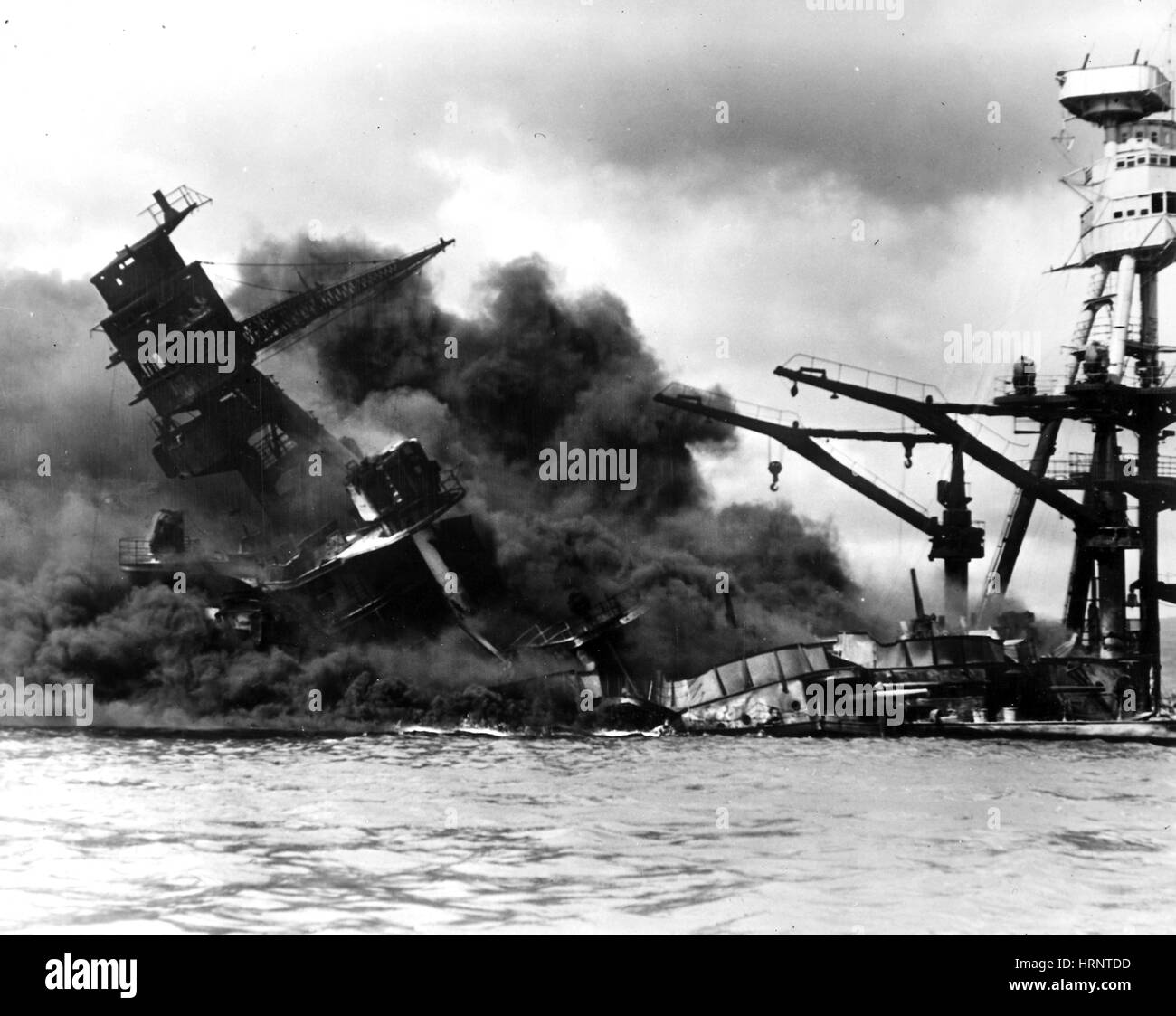 Battleship USS Arizona Sinking, 1941 Stock Photohttps://www.alamy.com/image-license-details/?v=1https://www.alamy.com/stock-photo-battleship-uss-arizona-sinking-1941-135089849.html
Battleship USS Arizona Sinking, 1941 Stock Photohttps://www.alamy.com/image-license-details/?v=1https://www.alamy.com/stock-photo-battleship-uss-arizona-sinking-1941-135089849.htmlRMHRNTDD–Battleship USS Arizona Sinking, 1941
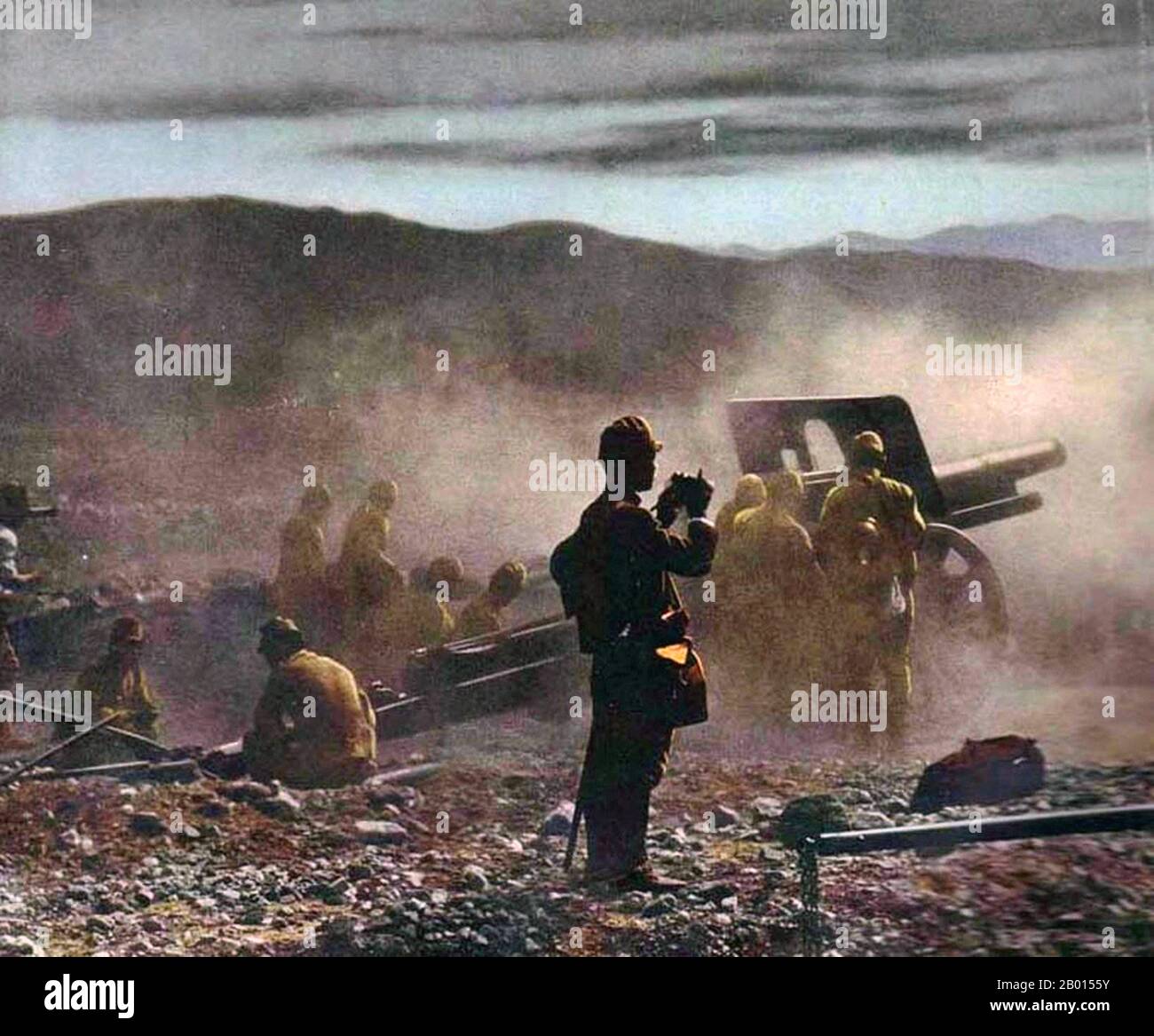 China: Japanese artillery in north China, 1938. Second Sino-Japanese War (July 7, 1937 – September 9, 1945). The Second Sino-Japanese War was a military conflict fought primarily between the Republic of China and the Empire of Japan. After the Japanese attack on Pearl Harbor, the war merged into the greater conflict of World War II as a major front of what is broadly known as the Pacific War. Although the two countries had fought intermittently since 1931, total war started in earnest in 1937 and ended only with the surrender of Japan in 1945. Stock Photohttps://www.alamy.com/image-license-details/?v=1https://www.alamy.com/china-japanese-artillery-in-north-china-1938-second-sino-japanese-war-july-7-1937-september-9-1945-the-second-sino-japanese-war-was-a-military-conflict-fought-primarily-between-the-republic-of-china-and-the-empire-of-japan-after-the-japanese-attack-on-pearl-harbor-the-war-merged-into-the-greater-conflict-of-world-war-ii-as-a-major-front-of-what-is-broadly-known-as-the-pacific-war-although-the-two-countries-had-fought-intermittently-since-1931-total-war-started-in-earnest-in-1937-and-ended-only-with-the-surrender-of-japan-in-1945-image344233399.html
China: Japanese artillery in north China, 1938. Second Sino-Japanese War (July 7, 1937 – September 9, 1945). The Second Sino-Japanese War was a military conflict fought primarily between the Republic of China and the Empire of Japan. After the Japanese attack on Pearl Harbor, the war merged into the greater conflict of World War II as a major front of what is broadly known as the Pacific War. Although the two countries had fought intermittently since 1931, total war started in earnest in 1937 and ended only with the surrender of Japan in 1945. Stock Photohttps://www.alamy.com/image-license-details/?v=1https://www.alamy.com/china-japanese-artillery-in-north-china-1938-second-sino-japanese-war-july-7-1937-september-9-1945-the-second-sino-japanese-war-was-a-military-conflict-fought-primarily-between-the-republic-of-china-and-the-empire-of-japan-after-the-japanese-attack-on-pearl-harbor-the-war-merged-into-the-greater-conflict-of-world-war-ii-as-a-major-front-of-what-is-broadly-known-as-the-pacific-war-although-the-two-countries-had-fought-intermittently-since-1931-total-war-started-in-earnest-in-1937-and-ended-only-with-the-surrender-of-japan-in-1945-image344233399.htmlRM2B0155Y–China: Japanese artillery in north China, 1938. Second Sino-Japanese War (July 7, 1937 – September 9, 1945). The Second Sino-Japanese War was a military conflict fought primarily between the Republic of China and the Empire of Japan. After the Japanese attack on Pearl Harbor, the war merged into the greater conflict of World War II as a major front of what is broadly known as the Pacific War. Although the two countries had fought intermittently since 1931, total war started in earnest in 1937 and ended only with the surrender of Japan in 1945.
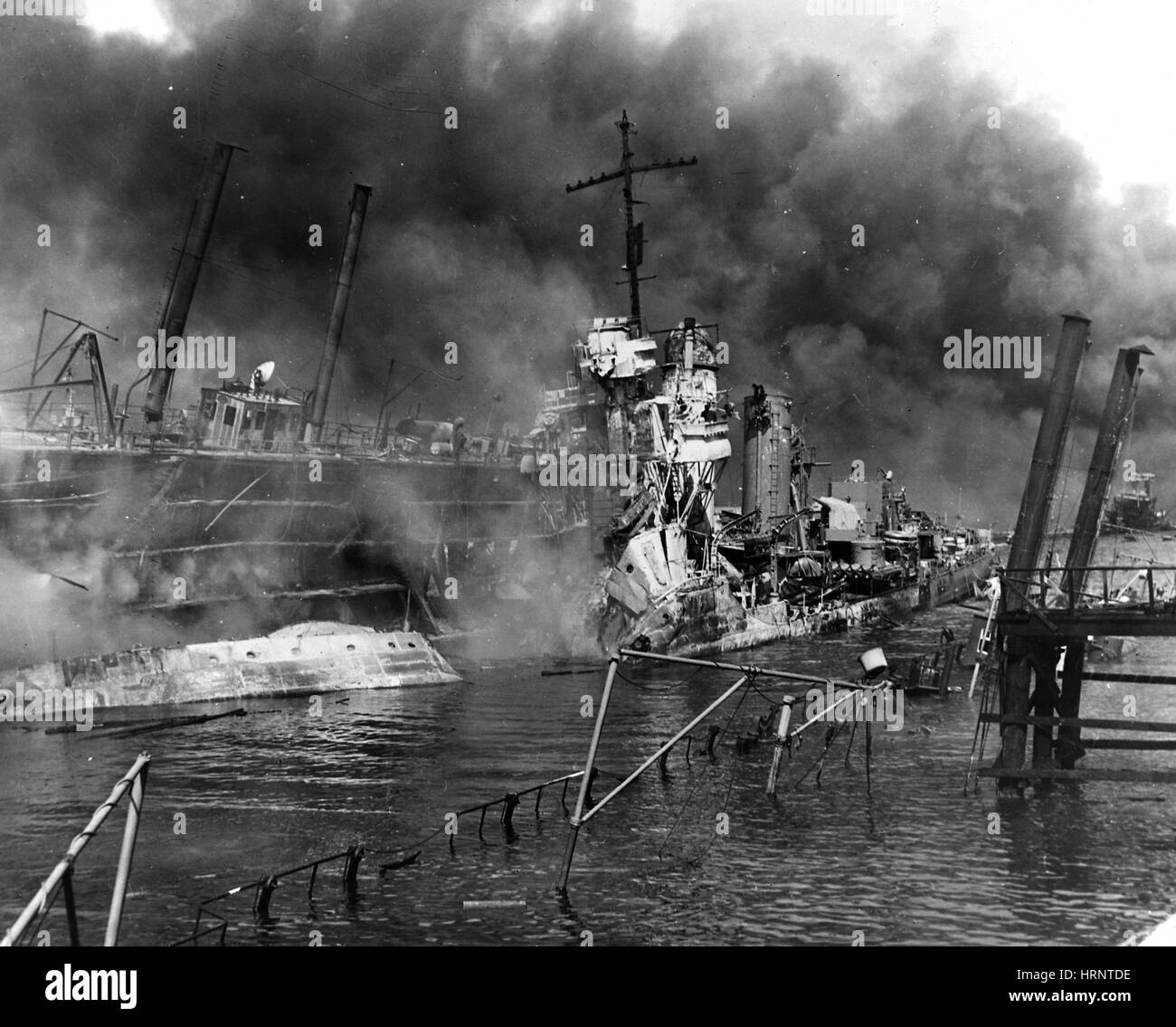 Destroyer USS Shaw Burning, 1941 Stock Photohttps://www.alamy.com/image-license-details/?v=1https://www.alamy.com/stock-photo-destroyer-uss-shaw-burning-1941-135089850.html
Destroyer USS Shaw Burning, 1941 Stock Photohttps://www.alamy.com/image-license-details/?v=1https://www.alamy.com/stock-photo-destroyer-uss-shaw-burning-1941-135089850.htmlRMHRNTDE–Destroyer USS Shaw Burning, 1941
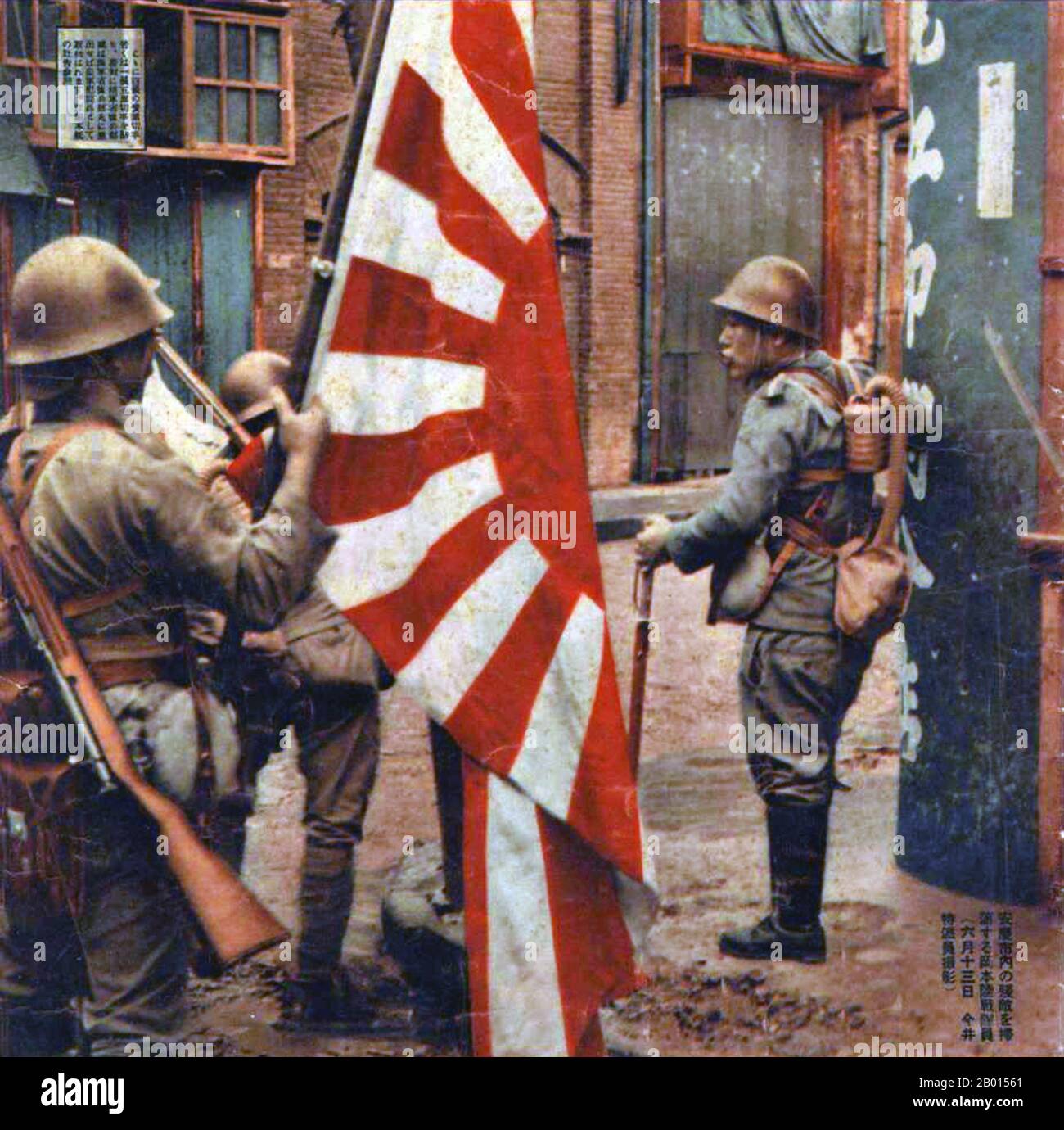 China: Japanese troops in Shanghai, 1937. Second Sino-Japanese War (July 7, 1937 – September 9, 1945). The Second Sino-Japanese War was a military conflict fought primarily between the Republic of China and the Empire of Japan. After the Japanese attack on Pearl Harbor, the war merged into the greater conflict of World War II as a major front of what is broadly known as the Pacific War. Although the two countries had fought intermittently since 1931, total war started in earnest in 1937 and ended only with the surrender of Japan in 1945. Stock Photohttps://www.alamy.com/image-license-details/?v=1https://www.alamy.com/china-japanese-troops-in-shanghai-1937-second-sino-japanese-war-july-7-1937-september-9-1945-the-second-sino-japanese-war-was-a-military-conflict-fought-primarily-between-the-republic-of-china-and-the-empire-of-japan-after-the-japanese-attack-on-pearl-harbor-the-war-merged-into-the-greater-conflict-of-world-war-ii-as-a-major-front-of-what-is-broadly-known-as-the-pacific-war-although-the-two-countries-had-fought-intermittently-since-1931-total-war-started-in-earnest-in-1937-and-ended-only-with-the-surrender-of-japan-in-1945-image344233401.html
China: Japanese troops in Shanghai, 1937. Second Sino-Japanese War (July 7, 1937 – September 9, 1945). The Second Sino-Japanese War was a military conflict fought primarily between the Republic of China and the Empire of Japan. After the Japanese attack on Pearl Harbor, the war merged into the greater conflict of World War II as a major front of what is broadly known as the Pacific War. Although the two countries had fought intermittently since 1931, total war started in earnest in 1937 and ended only with the surrender of Japan in 1945. Stock Photohttps://www.alamy.com/image-license-details/?v=1https://www.alamy.com/china-japanese-troops-in-shanghai-1937-second-sino-japanese-war-july-7-1937-september-9-1945-the-second-sino-japanese-war-was-a-military-conflict-fought-primarily-between-the-republic-of-china-and-the-empire-of-japan-after-the-japanese-attack-on-pearl-harbor-the-war-merged-into-the-greater-conflict-of-world-war-ii-as-a-major-front-of-what-is-broadly-known-as-the-pacific-war-although-the-two-countries-had-fought-intermittently-since-1931-total-war-started-in-earnest-in-1937-and-ended-only-with-the-surrender-of-japan-in-1945-image344233401.htmlRM2B01561–China: Japanese troops in Shanghai, 1937. Second Sino-Japanese War (July 7, 1937 – September 9, 1945). The Second Sino-Japanese War was a military conflict fought primarily between the Republic of China and the Empire of Japan. After the Japanese attack on Pearl Harbor, the war merged into the greater conflict of World War II as a major front of what is broadly known as the Pacific War. Although the two countries had fought intermittently since 1931, total war started in earnest in 1937 and ended only with the surrender of Japan in 1945.
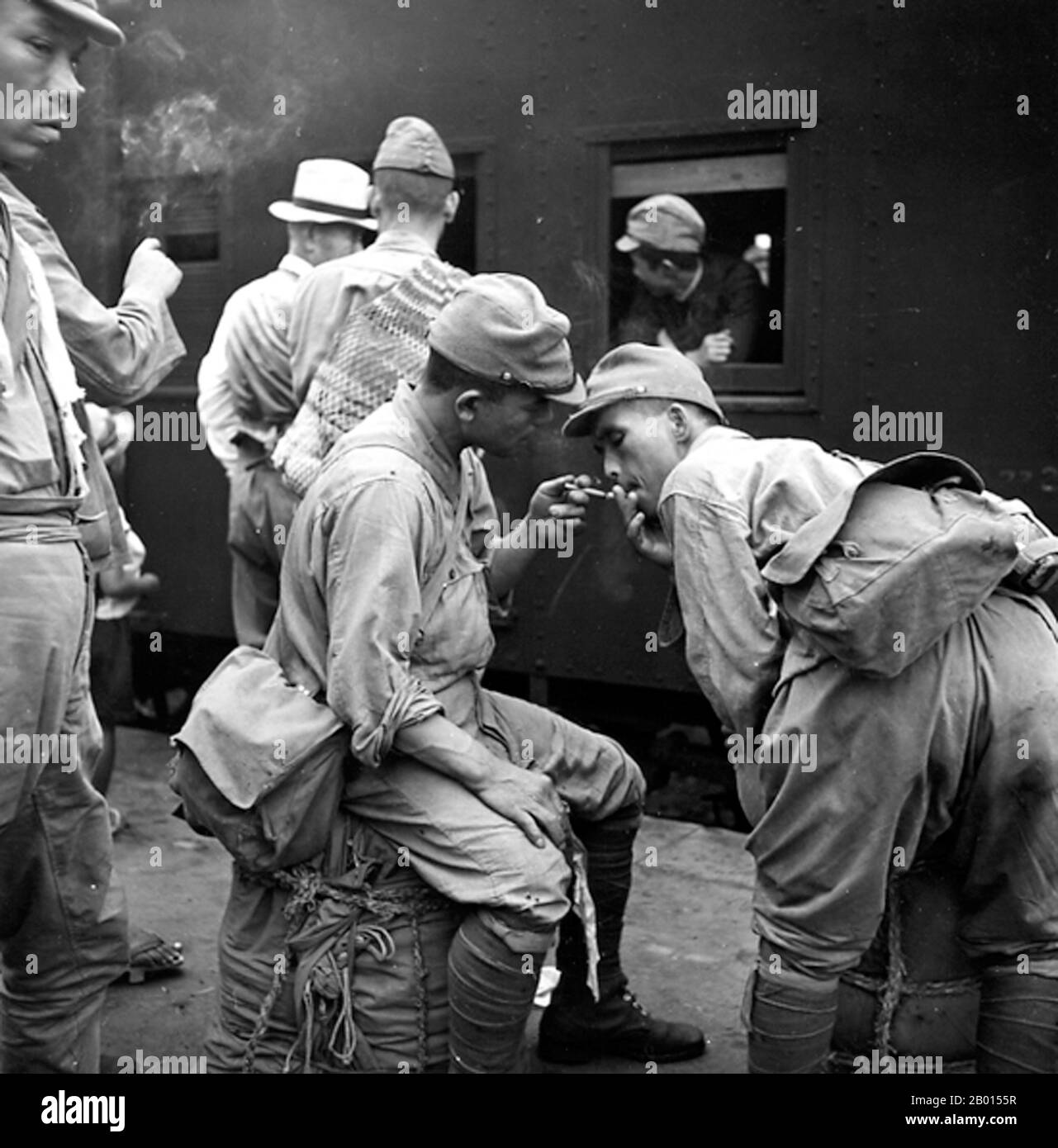 China: Japanese troops waiting for a troop train to depart. Second Sino-Japanese War (July 7, 1937 – September 9, 1945). The Second Sino-Japanese War was a military conflict fought primarily between the Republic of China and the Empire of Japan. After the Japanese attack on Pearl Harbor, the war merged into the greater conflict of World War II as a major front of what is broadly known as the Pacific War. Although the two countries had fought intermittently since 1931, total war started in earnest in 1937 and ended only with the surrender of Japan in 1945. Stock Photohttps://www.alamy.com/image-license-details/?v=1https://www.alamy.com/china-japanese-troops-waiting-for-a-troop-train-to-depart-second-sino-japanese-war-july-7-1937-september-9-1945-the-second-sino-japanese-war-was-a-military-conflict-fought-primarily-between-the-republic-of-china-and-the-empire-of-japan-after-the-japanese-attack-on-pearl-harbor-the-war-merged-into-the-greater-conflict-of-world-war-ii-as-a-major-front-of-what-is-broadly-known-as-the-pacific-war-although-the-two-countries-had-fought-intermittently-since-1931-total-war-started-in-earnest-in-1937-and-ended-only-with-the-surrender-of-japan-in-1945-image344233395.html
China: Japanese troops waiting for a troop train to depart. Second Sino-Japanese War (July 7, 1937 – September 9, 1945). The Second Sino-Japanese War was a military conflict fought primarily between the Republic of China and the Empire of Japan. After the Japanese attack on Pearl Harbor, the war merged into the greater conflict of World War II as a major front of what is broadly known as the Pacific War. Although the two countries had fought intermittently since 1931, total war started in earnest in 1937 and ended only with the surrender of Japan in 1945. Stock Photohttps://www.alamy.com/image-license-details/?v=1https://www.alamy.com/china-japanese-troops-waiting-for-a-troop-train-to-depart-second-sino-japanese-war-july-7-1937-september-9-1945-the-second-sino-japanese-war-was-a-military-conflict-fought-primarily-between-the-republic-of-china-and-the-empire-of-japan-after-the-japanese-attack-on-pearl-harbor-the-war-merged-into-the-greater-conflict-of-world-war-ii-as-a-major-front-of-what-is-broadly-known-as-the-pacific-war-although-the-two-countries-had-fought-intermittently-since-1931-total-war-started-in-earnest-in-1937-and-ended-only-with-the-surrender-of-japan-in-1945-image344233395.htmlRM2B0155R–China: Japanese troops waiting for a troop train to depart. Second Sino-Japanese War (July 7, 1937 – September 9, 1945). The Second Sino-Japanese War was a military conflict fought primarily between the Republic of China and the Empire of Japan. After the Japanese attack on Pearl Harbor, the war merged into the greater conflict of World War II as a major front of what is broadly known as the Pacific War. Although the two countries had fought intermittently since 1931, total war started in earnest in 1937 and ended only with the surrender of Japan in 1945.
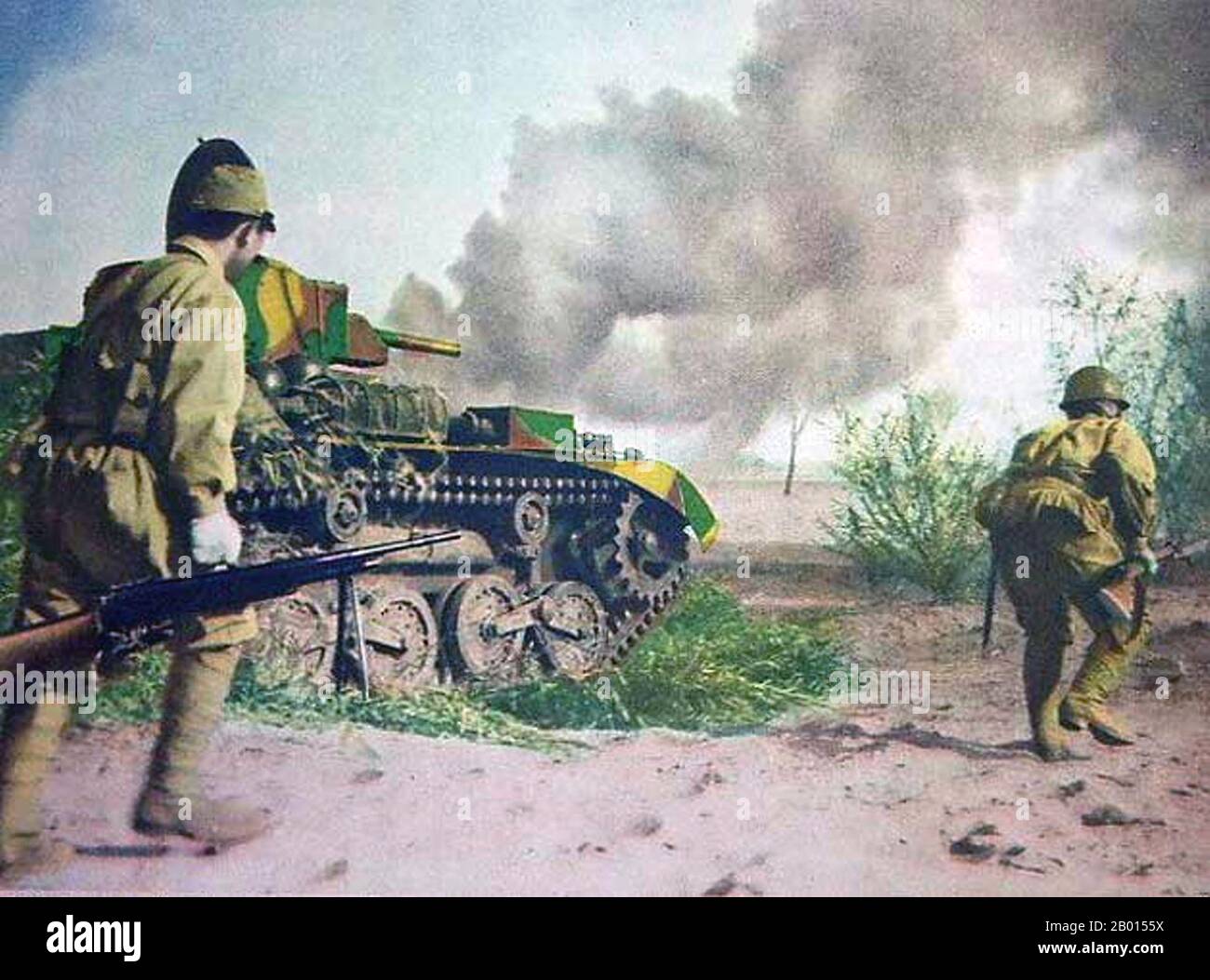 China: Japanese infantry and tank move into action, 1939. Second Sino-Japanese War (July 7, 1937 – September 9, 1945). The Second Sino-Japanese War was a military conflict fought primarily between the Republic of China and the Empire of Japan. After the Japanese attack on Pearl Harbor, the war merged into the greater conflict of World War II as a major front of what is broadly known as the Pacific War. Although the two countries had fought intermittently since 1931, total war started in earnest in 1937 and ended only with the surrender of Japan in 1945. Stock Photohttps://www.alamy.com/image-license-details/?v=1https://www.alamy.com/china-japanese-infantry-and-tank-move-into-action-1939-second-sino-japanese-war-july-7-1937-september-9-1945-the-second-sino-japanese-war-was-a-military-conflict-fought-primarily-between-the-republic-of-china-and-the-empire-of-japan-after-the-japanese-attack-on-pearl-harbor-the-war-merged-into-the-greater-conflict-of-world-war-ii-as-a-major-front-of-what-is-broadly-known-as-the-pacific-war-although-the-two-countries-had-fought-intermittently-since-1931-total-war-started-in-earnest-in-1937-and-ended-only-with-the-surrender-of-japan-in-1945-image344233398.html
China: Japanese infantry and tank move into action, 1939. Second Sino-Japanese War (July 7, 1937 – September 9, 1945). The Second Sino-Japanese War was a military conflict fought primarily between the Republic of China and the Empire of Japan. After the Japanese attack on Pearl Harbor, the war merged into the greater conflict of World War II as a major front of what is broadly known as the Pacific War. Although the two countries had fought intermittently since 1931, total war started in earnest in 1937 and ended only with the surrender of Japan in 1945. Stock Photohttps://www.alamy.com/image-license-details/?v=1https://www.alamy.com/china-japanese-infantry-and-tank-move-into-action-1939-second-sino-japanese-war-july-7-1937-september-9-1945-the-second-sino-japanese-war-was-a-military-conflict-fought-primarily-between-the-republic-of-china-and-the-empire-of-japan-after-the-japanese-attack-on-pearl-harbor-the-war-merged-into-the-greater-conflict-of-world-war-ii-as-a-major-front-of-what-is-broadly-known-as-the-pacific-war-although-the-two-countries-had-fought-intermittently-since-1931-total-war-started-in-earnest-in-1937-and-ended-only-with-the-surrender-of-japan-in-1945-image344233398.htmlRM2B0155X–China: Japanese infantry and tank move into action, 1939. Second Sino-Japanese War (July 7, 1937 – September 9, 1945). The Second Sino-Japanese War was a military conflict fought primarily between the Republic of China and the Empire of Japan. After the Japanese attack on Pearl Harbor, the war merged into the greater conflict of World War II as a major front of what is broadly known as the Pacific War. Although the two countries had fought intermittently since 1931, total war started in earnest in 1937 and ended only with the surrender of Japan in 1945.
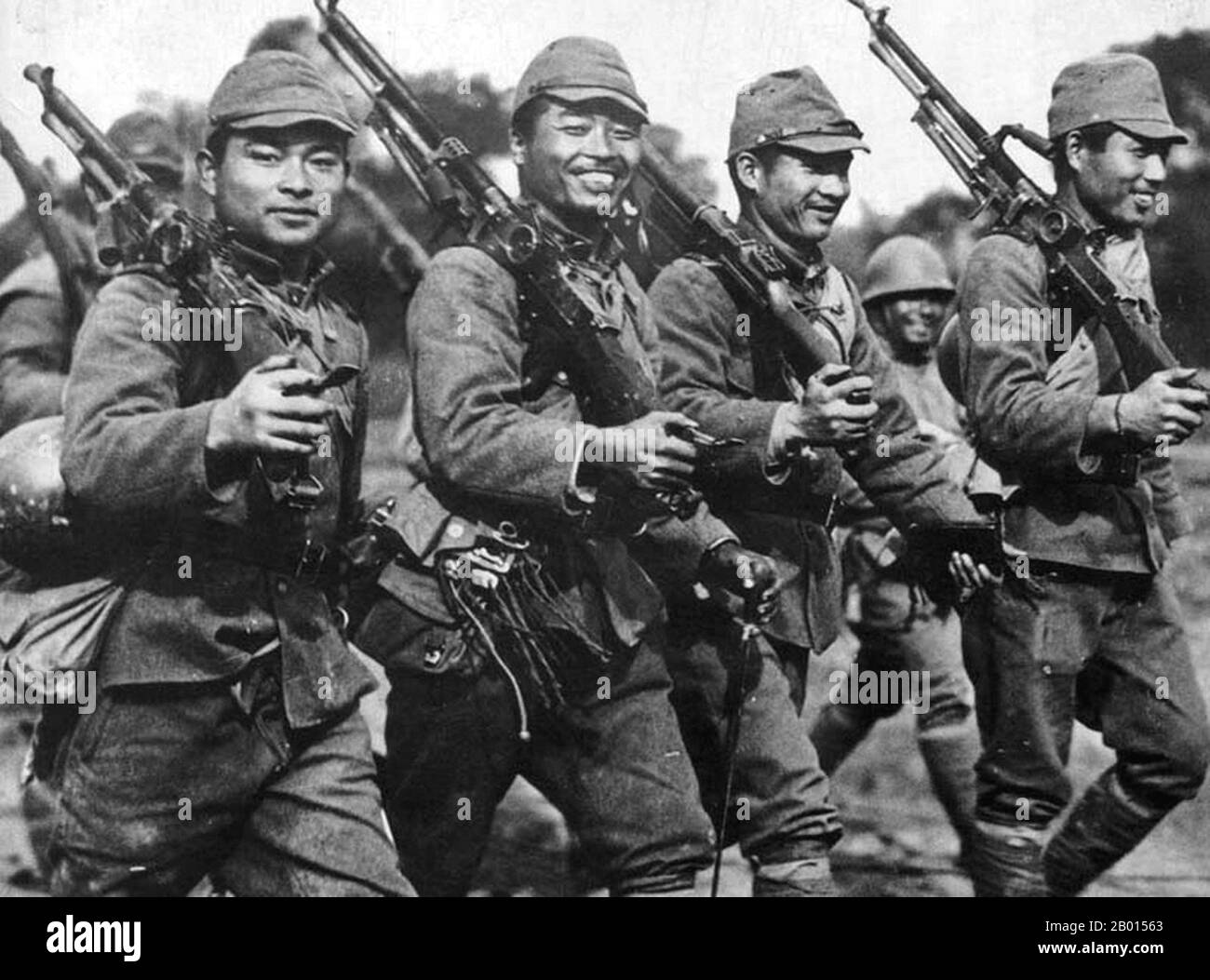 China: Smiling Japanese troops, 1937. Second Sino-Japanese War (July 7, 1937 – September 9, 1945). The Second Sino-Japanese War was a military conflict fought primarily between the Republic of China and the Empire of Japan. After the Japanese attack on Pearl Harbor, the war merged into the greater conflict of World War II as a major front of what is broadly known as the Pacific War. Although the two countries had fought intermittently since 1931, total war started in earnest in 1937 and ended only with the surrender of Japan in 1945. Stock Photohttps://www.alamy.com/image-license-details/?v=1https://www.alamy.com/china-smiling-japanese-troops-1937-second-sino-japanese-war-july-7-1937-september-9-1945-the-second-sino-japanese-war-was-a-military-conflict-fought-primarily-between-the-republic-of-china-and-the-empire-of-japan-after-the-japanese-attack-on-pearl-harbor-the-war-merged-into-the-greater-conflict-of-world-war-ii-as-a-major-front-of-what-is-broadly-known-as-the-pacific-war-although-the-two-countries-had-fought-intermittently-since-1931-total-war-started-in-earnest-in-1937-and-ended-only-with-the-surrender-of-japan-in-1945-image344233403.html
China: Smiling Japanese troops, 1937. Second Sino-Japanese War (July 7, 1937 – September 9, 1945). The Second Sino-Japanese War was a military conflict fought primarily between the Republic of China and the Empire of Japan. After the Japanese attack on Pearl Harbor, the war merged into the greater conflict of World War II as a major front of what is broadly known as the Pacific War. Although the two countries had fought intermittently since 1931, total war started in earnest in 1937 and ended only with the surrender of Japan in 1945. Stock Photohttps://www.alamy.com/image-license-details/?v=1https://www.alamy.com/china-smiling-japanese-troops-1937-second-sino-japanese-war-july-7-1937-september-9-1945-the-second-sino-japanese-war-was-a-military-conflict-fought-primarily-between-the-republic-of-china-and-the-empire-of-japan-after-the-japanese-attack-on-pearl-harbor-the-war-merged-into-the-greater-conflict-of-world-war-ii-as-a-major-front-of-what-is-broadly-known-as-the-pacific-war-although-the-two-countries-had-fought-intermittently-since-1931-total-war-started-in-earnest-in-1937-and-ended-only-with-the-surrender-of-japan-in-1945-image344233403.htmlRM2B01563–China: Smiling Japanese troops, 1937. Second Sino-Japanese War (July 7, 1937 – September 9, 1945). The Second Sino-Japanese War was a military conflict fought primarily between the Republic of China and the Empire of Japan. After the Japanese attack on Pearl Harbor, the war merged into the greater conflict of World War II as a major front of what is broadly known as the Pacific War. Although the two countries had fought intermittently since 1931, total war started in earnest in 1937 and ended only with the surrender of Japan in 1945.
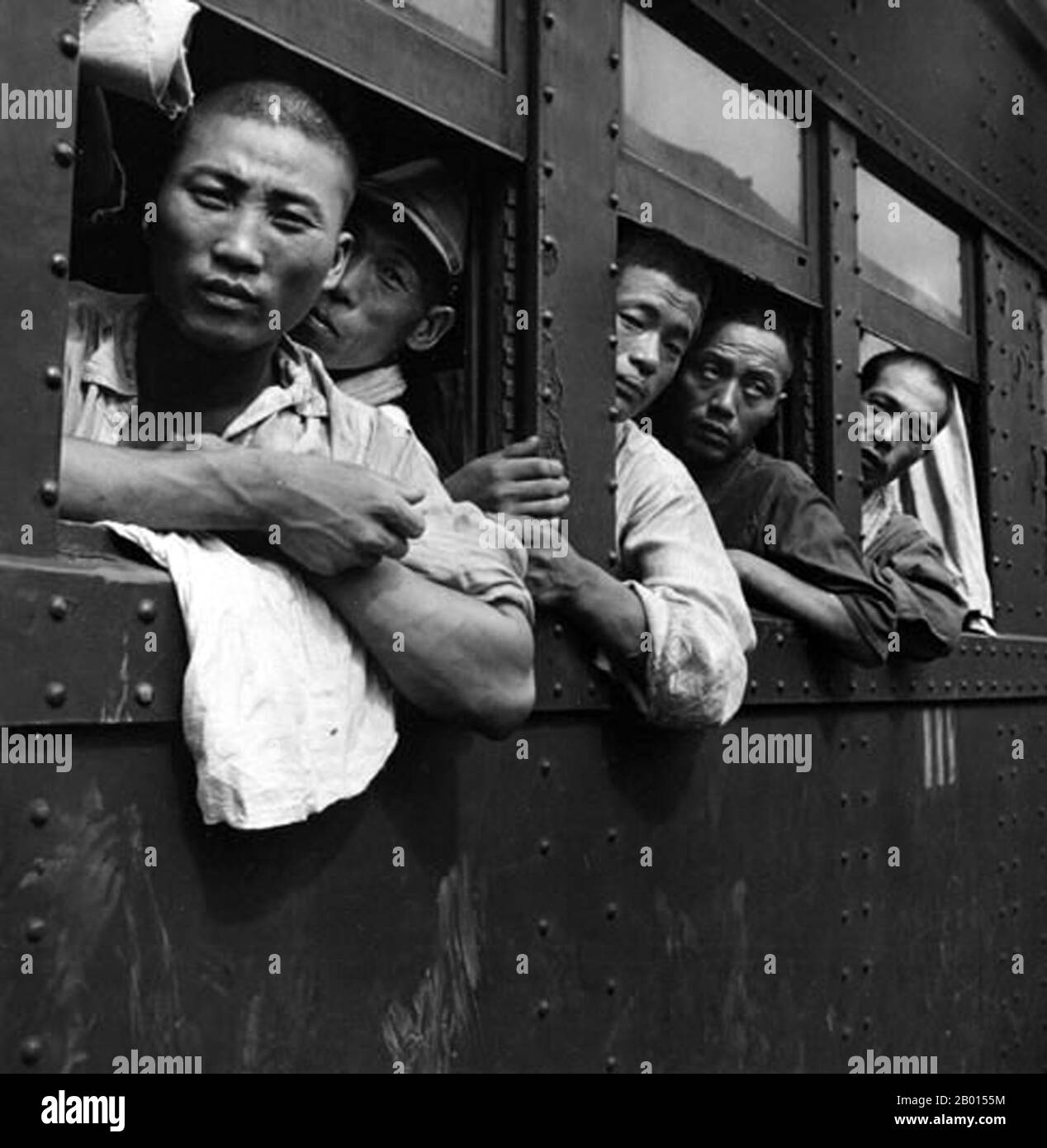 China: Japanese troops on a troop train in north China. Second Sino-Japanese War (July 7, 1937 – September 9, 1945). The Second Sino-Japanese War was a military conflict fought primarily between the Republic of China and the Empire of Japan. After the Japanese attack on Pearl Harbor, the war merged into the greater conflict of World War II as a major front of what is broadly known as the Pacific War. Although the two countries had fought intermittently since 1931, total war started in earnest in 1937 and ended only with the surrender of Japan in 1945. Stock Photohttps://www.alamy.com/image-license-details/?v=1https://www.alamy.com/china-japanese-troops-on-a-troop-train-in-north-china-second-sino-japanese-war-july-7-1937-september-9-1945-the-second-sino-japanese-war-was-a-military-conflict-fought-primarily-between-the-republic-of-china-and-the-empire-of-japan-after-the-japanese-attack-on-pearl-harbor-the-war-merged-into-the-greater-conflict-of-world-war-ii-as-a-major-front-of-what-is-broadly-known-as-the-pacific-war-although-the-two-countries-had-fought-intermittently-since-1931-total-war-started-in-earnest-in-1937-and-ended-only-with-the-surrender-of-japan-in-1945-image344233392.html
China: Japanese troops on a troop train in north China. Second Sino-Japanese War (July 7, 1937 – September 9, 1945). The Second Sino-Japanese War was a military conflict fought primarily between the Republic of China and the Empire of Japan. After the Japanese attack on Pearl Harbor, the war merged into the greater conflict of World War II as a major front of what is broadly known as the Pacific War. Although the two countries had fought intermittently since 1931, total war started in earnest in 1937 and ended only with the surrender of Japan in 1945. Stock Photohttps://www.alamy.com/image-license-details/?v=1https://www.alamy.com/china-japanese-troops-on-a-troop-train-in-north-china-second-sino-japanese-war-july-7-1937-september-9-1945-the-second-sino-japanese-war-was-a-military-conflict-fought-primarily-between-the-republic-of-china-and-the-empire-of-japan-after-the-japanese-attack-on-pearl-harbor-the-war-merged-into-the-greater-conflict-of-world-war-ii-as-a-major-front-of-what-is-broadly-known-as-the-pacific-war-although-the-two-countries-had-fought-intermittently-since-1931-total-war-started-in-earnest-in-1937-and-ended-only-with-the-surrender-of-japan-in-1945-image344233392.htmlRM2B0155M–China: Japanese troops on a troop train in north China. Second Sino-Japanese War (July 7, 1937 – September 9, 1945). The Second Sino-Japanese War was a military conflict fought primarily between the Republic of China and the Empire of Japan. After the Japanese attack on Pearl Harbor, the war merged into the greater conflict of World War II as a major front of what is broadly known as the Pacific War. Although the two countries had fought intermittently since 1931, total war started in earnest in 1937 and ended only with the surrender of Japan in 1945.
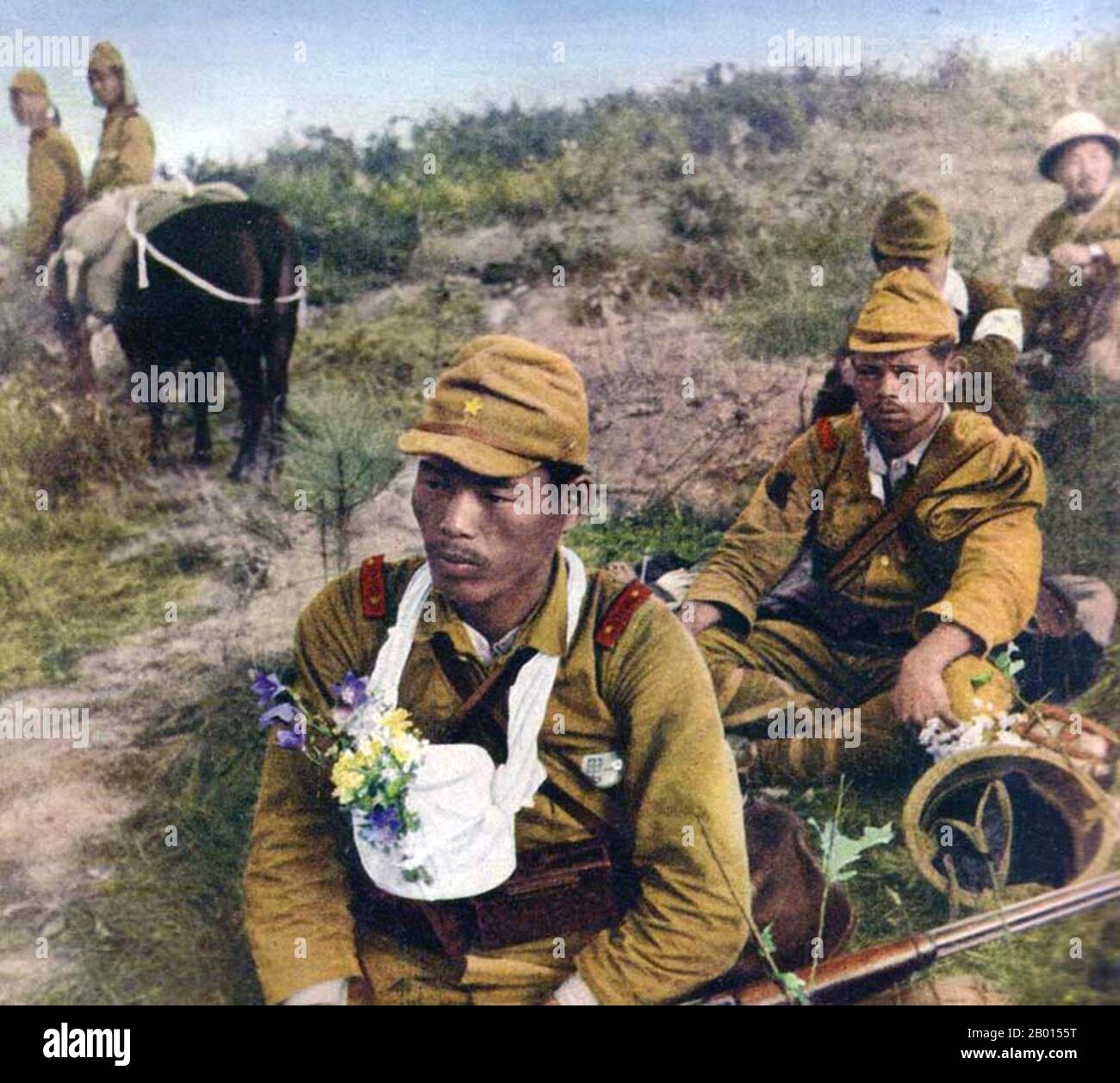 China: A Japanese soldier carries the ashes of a fallen comrade, north China, 1938. Second Sino-Japanese War (July 7, 1937 – September 9, 1945). The Second Sino-Japanese War was a military conflict fought primarily between the Republic of China and the Empire of Japan. After the Japanese attack on Pearl Harbor, the war merged into the greater conflict of World War II as a major front of what is broadly known as the Pacific War. Although the two countries had fought intermittently since 1931, total war started in earnest in 1937 and ended only with the surrender of Japan in 1945. Stock Photohttps://www.alamy.com/image-license-details/?v=1https://www.alamy.com/china-a-japanese-soldier-carries-the-ashes-of-a-fallen-comrade-north-china-1938-second-sino-japanese-war-july-7-1937-september-9-1945-the-second-sino-japanese-war-was-a-military-conflict-fought-primarily-between-the-republic-of-china-and-the-empire-of-japan-after-the-japanese-attack-on-pearl-harbor-the-war-merged-into-the-greater-conflict-of-world-war-ii-as-a-major-front-of-what-is-broadly-known-as-the-pacific-war-although-the-two-countries-had-fought-intermittently-since-1931-total-war-started-in-earnest-in-1937-and-ended-only-with-the-surrender-of-japan-in-1945-image344233396.html
China: A Japanese soldier carries the ashes of a fallen comrade, north China, 1938. Second Sino-Japanese War (July 7, 1937 – September 9, 1945). The Second Sino-Japanese War was a military conflict fought primarily between the Republic of China and the Empire of Japan. After the Japanese attack on Pearl Harbor, the war merged into the greater conflict of World War II as a major front of what is broadly known as the Pacific War. Although the two countries had fought intermittently since 1931, total war started in earnest in 1937 and ended only with the surrender of Japan in 1945. Stock Photohttps://www.alamy.com/image-license-details/?v=1https://www.alamy.com/china-a-japanese-soldier-carries-the-ashes-of-a-fallen-comrade-north-china-1938-second-sino-japanese-war-july-7-1937-september-9-1945-the-second-sino-japanese-war-was-a-military-conflict-fought-primarily-between-the-republic-of-china-and-the-empire-of-japan-after-the-japanese-attack-on-pearl-harbor-the-war-merged-into-the-greater-conflict-of-world-war-ii-as-a-major-front-of-what-is-broadly-known-as-the-pacific-war-although-the-two-countries-had-fought-intermittently-since-1931-total-war-started-in-earnest-in-1937-and-ended-only-with-the-surrender-of-japan-in-1945-image344233396.htmlRM2B0155T–China: A Japanese soldier carries the ashes of a fallen comrade, north China, 1938. Second Sino-Japanese War (July 7, 1937 – September 9, 1945). The Second Sino-Japanese War was a military conflict fought primarily between the Republic of China and the Empire of Japan. After the Japanese attack on Pearl Harbor, the war merged into the greater conflict of World War II as a major front of what is broadly known as the Pacific War. Although the two countries had fought intermittently since 1931, total war started in earnest in 1937 and ended only with the surrender of Japan in 1945.
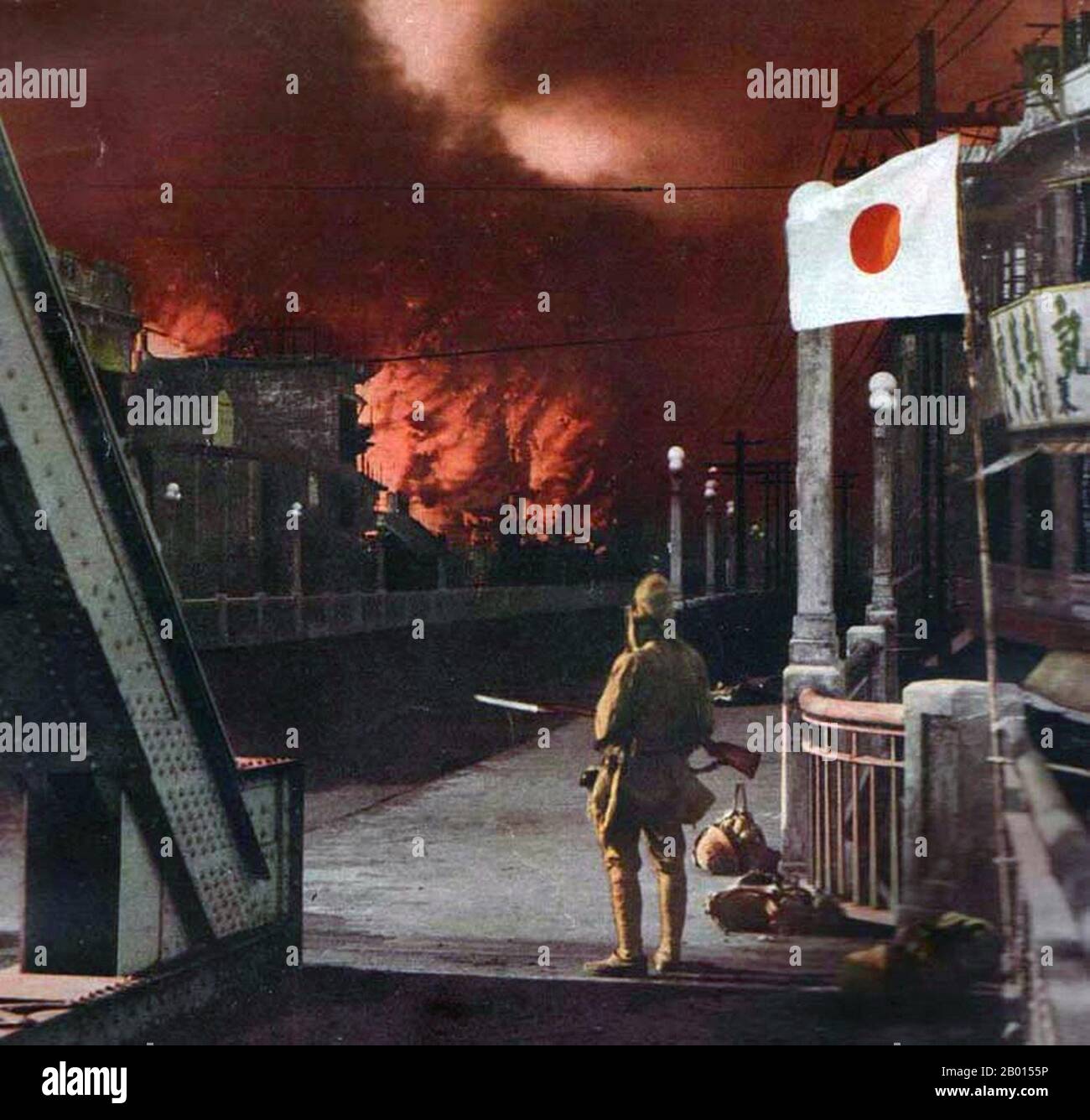 China: Shanghai suburbs ablaze as a Japanese soldier looks on. Second Sino-Japanese War (July 7, 1937 – September 9, 1945). The Second Sino-Japanese War was a military conflict fought primarily between the Republic of China and the Empire of Japan. After the Japanese attack on Pearl Harbor, the war merged into the greater conflict of World War II as a major front of what is broadly known as the Pacific War. Although the two countries had fought intermittently since 1931, total war started in earnest in 1937 and ended only with the surrender of Japan in 1945. Stock Photohttps://www.alamy.com/image-license-details/?v=1https://www.alamy.com/china-shanghai-suburbs-ablaze-as-a-japanese-soldier-looks-on-second-sino-japanese-war-july-7-1937-september-9-1945-the-second-sino-japanese-war-was-a-military-conflict-fought-primarily-between-the-republic-of-china-and-the-empire-of-japan-after-the-japanese-attack-on-pearl-harbor-the-war-merged-into-the-greater-conflict-of-world-war-ii-as-a-major-front-of-what-is-broadly-known-as-the-pacific-war-although-the-two-countries-had-fought-intermittently-since-1931-total-war-started-in-earnest-in-1937-and-ended-only-with-the-surrender-of-japan-in-1945-image344233394.html
China: Shanghai suburbs ablaze as a Japanese soldier looks on. Second Sino-Japanese War (July 7, 1937 – September 9, 1945). The Second Sino-Japanese War was a military conflict fought primarily between the Republic of China and the Empire of Japan. After the Japanese attack on Pearl Harbor, the war merged into the greater conflict of World War II as a major front of what is broadly known as the Pacific War. Although the two countries had fought intermittently since 1931, total war started in earnest in 1937 and ended only with the surrender of Japan in 1945. Stock Photohttps://www.alamy.com/image-license-details/?v=1https://www.alamy.com/china-shanghai-suburbs-ablaze-as-a-japanese-soldier-looks-on-second-sino-japanese-war-july-7-1937-september-9-1945-the-second-sino-japanese-war-was-a-military-conflict-fought-primarily-between-the-republic-of-china-and-the-empire-of-japan-after-the-japanese-attack-on-pearl-harbor-the-war-merged-into-the-greater-conflict-of-world-war-ii-as-a-major-front-of-what-is-broadly-known-as-the-pacific-war-although-the-two-countries-had-fought-intermittently-since-1931-total-war-started-in-earnest-in-1937-and-ended-only-with-the-surrender-of-japan-in-1945-image344233394.htmlRM2B0155P–China: Shanghai suburbs ablaze as a Japanese soldier looks on. Second Sino-Japanese War (July 7, 1937 – September 9, 1945). The Second Sino-Japanese War was a military conflict fought primarily between the Republic of China and the Empire of Japan. After the Japanese attack on Pearl Harbor, the war merged into the greater conflict of World War II as a major front of what is broadly known as the Pacific War. Although the two countries had fought intermittently since 1931, total war started in earnest in 1937 and ended only with the surrender of Japan in 1945.
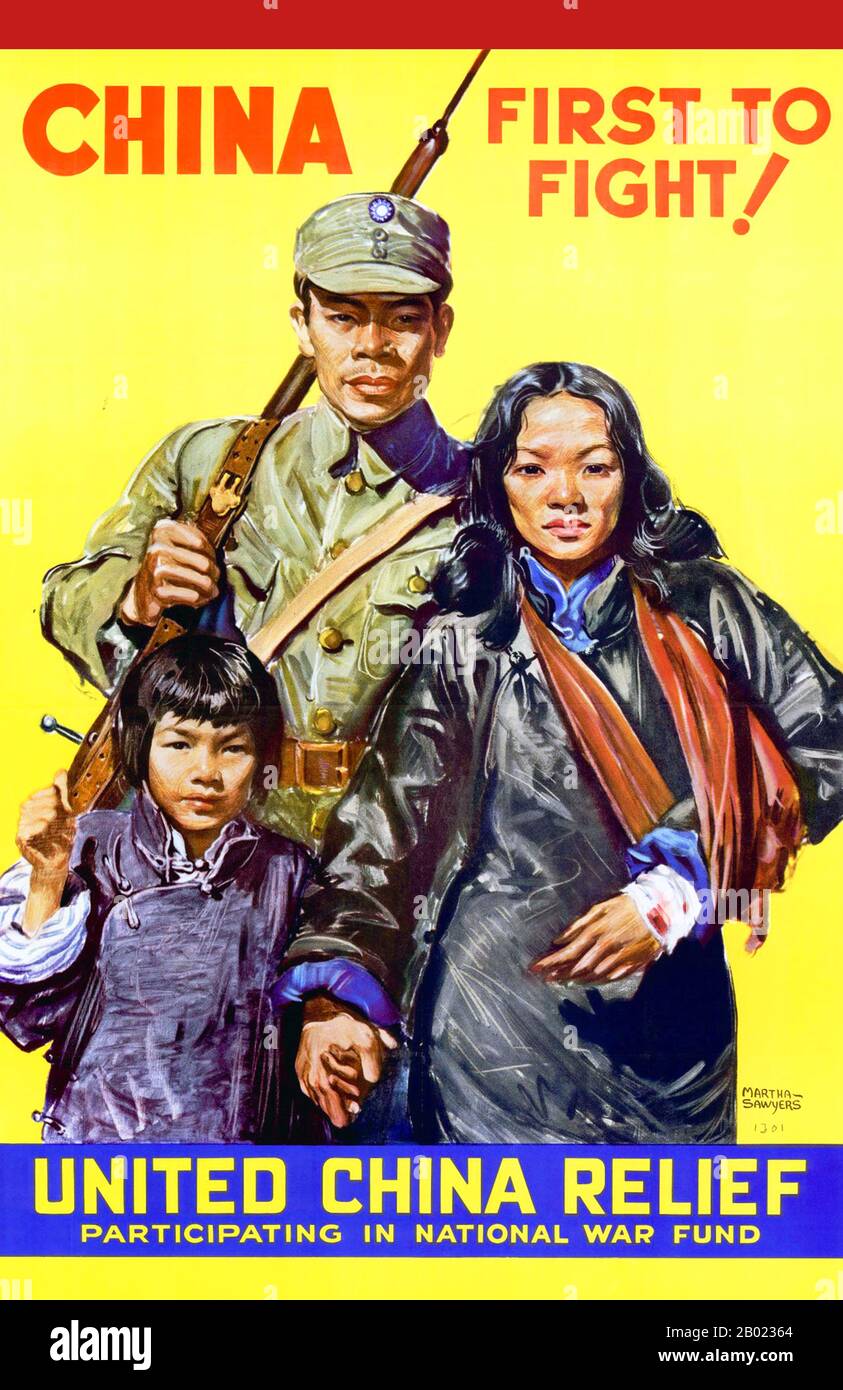 USA/China: United States propagaganda poster supporting China in World War II. Poster by Martha Sawyers (1902-1986) c. 1941-1945. The Second Sino-Japanese War (7 July 7 1937 - 2 September 1945), called so after the First Sino-Japanese War of 1894-1895, was a military conflict fought primarily between the Republic of China and the Empire of Japan from 1937 to 1941. China fought Japan with some economic help from Germany (until 1941), the Soviet Union (1937-1940) and the United States. After the Japanese attack on Pearl Harbor in 1941, the war merged into the greater conflict of World War II. Stock Photohttps://www.alamy.com/image-license-details/?v=1https://www.alamy.com/usachina-united-states-propagaganda-poster-supporting-china-in-world-war-ii-poster-by-martha-sawyers-1902-1986-c-1941-1945-the-second-sino-japanese-war-7-july-7-1937-2-september-1945-called-so-after-the-first-sino-japanese-war-of-1894-1895-was-a-military-conflict-fought-primarily-between-the-republic-of-china-and-the-empire-of-japan-from-1937-to-1941-china-fought-japan-with-some-economic-help-from-germany-until-1941-the-soviet-union-1937-1940-and-the-united-states-after-the-japanese-attack-on-pearl-harbor-in-1941-the-war-merged-into-the-greater-conflict-of-world-war-ii-image344253788.html
USA/China: United States propagaganda poster supporting China in World War II. Poster by Martha Sawyers (1902-1986) c. 1941-1945. The Second Sino-Japanese War (7 July 7 1937 - 2 September 1945), called so after the First Sino-Japanese War of 1894-1895, was a military conflict fought primarily between the Republic of China and the Empire of Japan from 1937 to 1941. China fought Japan with some economic help from Germany (until 1941), the Soviet Union (1937-1940) and the United States. After the Japanese attack on Pearl Harbor in 1941, the war merged into the greater conflict of World War II. Stock Photohttps://www.alamy.com/image-license-details/?v=1https://www.alamy.com/usachina-united-states-propagaganda-poster-supporting-china-in-world-war-ii-poster-by-martha-sawyers-1902-1986-c-1941-1945-the-second-sino-japanese-war-7-july-7-1937-2-september-1945-called-so-after-the-first-sino-japanese-war-of-1894-1895-was-a-military-conflict-fought-primarily-between-the-republic-of-china-and-the-empire-of-japan-from-1937-to-1941-china-fought-japan-with-some-economic-help-from-germany-until-1941-the-soviet-union-1937-1940-and-the-united-states-after-the-japanese-attack-on-pearl-harbor-in-1941-the-war-merged-into-the-greater-conflict-of-world-war-ii-image344253788.htmlRM2B02364–USA/China: United States propagaganda poster supporting China in World War II. Poster by Martha Sawyers (1902-1986) c. 1941-1945. The Second Sino-Japanese War (7 July 7 1937 - 2 September 1945), called so after the First Sino-Japanese War of 1894-1895, was a military conflict fought primarily between the Republic of China and the Empire of Japan from 1937 to 1941. China fought Japan with some economic help from Germany (until 1941), the Soviet Union (1937-1940) and the United States. After the Japanese attack on Pearl Harbor in 1941, the war merged into the greater conflict of World War II.
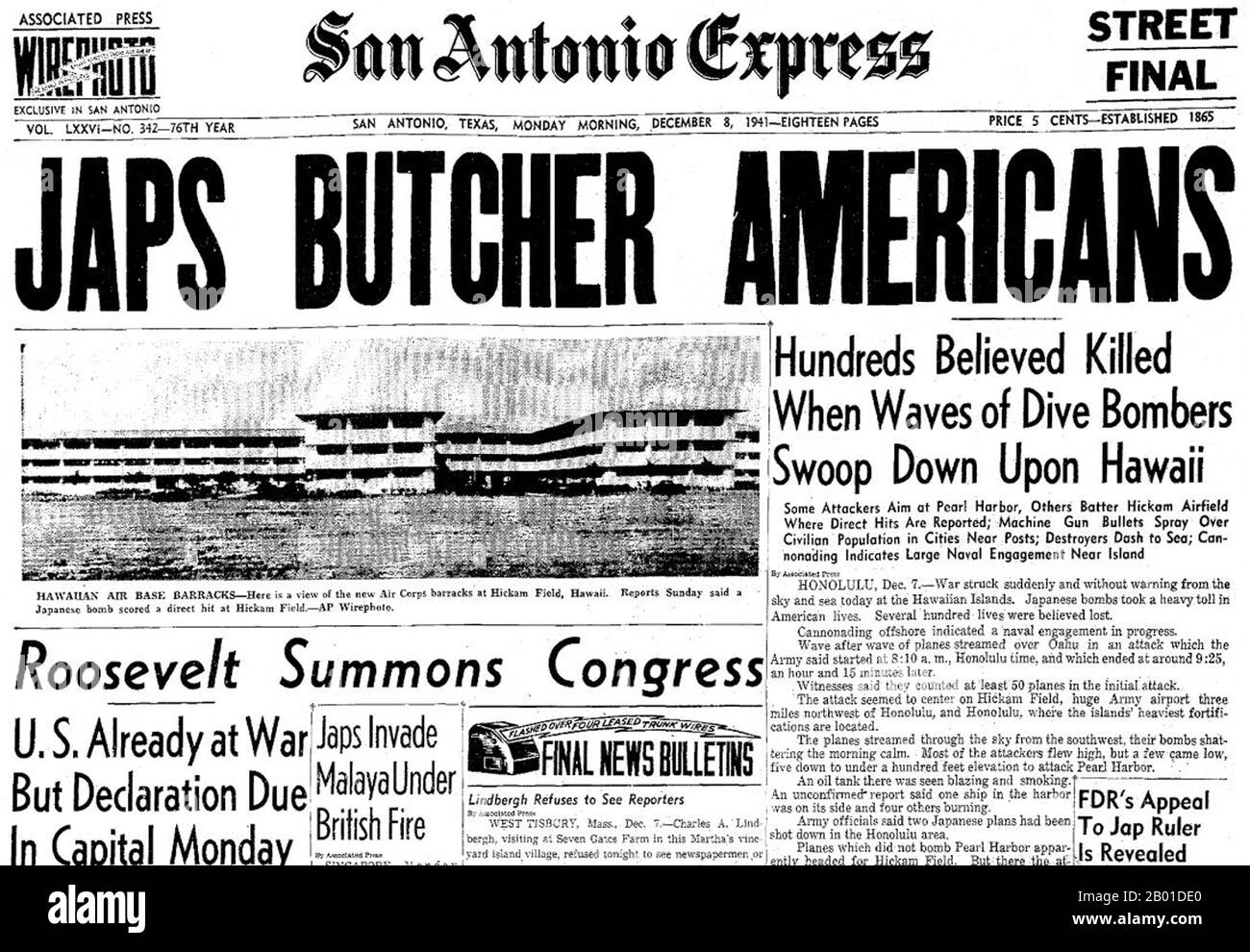 USA/Japan: Headline of the San Antonio Express (Texas) on 8 December, 1941, the day after the Japanese attack on Pearl Harbour. The attack on Pearl Harbor was a surprise military strike conducted by the Imperial Japanese Navy against the United States naval base at Pearl Harbor, Hawaii, on the morning of December 7, 1941 (December 8 in Japan). The attack was intended as a preventive action in order to keep the U.S. Pacific Fleet from interfering with military actions the Empire of Japan was planning in Southeast Asia. Stock Photohttps://www.alamy.com/image-license-details/?v=1https://www.alamy.com/usajapan-headline-of-the-san-antonio-express-texas-on-8-december-1941-the-day-after-the-japanese-attack-on-pearl-harbour-the-attack-on-pearl-harbor-was-a-surprise-military-strike-conducted-by-the-imperial-japanese-navy-against-the-united-states-naval-base-at-pearl-harbor-hawaii-on-the-morning-of-december-7-1941-december-8-in-japan-the-attack-was-intended-as-a-preventive-action-in-order-to-keep-the-us-pacific-fleet-from-interfering-with-military-actions-the-empire-of-japan-was-planning-in-southeast-asia-image344239896.html
USA/Japan: Headline of the San Antonio Express (Texas) on 8 December, 1941, the day after the Japanese attack on Pearl Harbour. The attack on Pearl Harbor was a surprise military strike conducted by the Imperial Japanese Navy against the United States naval base at Pearl Harbor, Hawaii, on the morning of December 7, 1941 (December 8 in Japan). The attack was intended as a preventive action in order to keep the U.S. Pacific Fleet from interfering with military actions the Empire of Japan was planning in Southeast Asia. Stock Photohttps://www.alamy.com/image-license-details/?v=1https://www.alamy.com/usajapan-headline-of-the-san-antonio-express-texas-on-8-december-1941-the-day-after-the-japanese-attack-on-pearl-harbour-the-attack-on-pearl-harbor-was-a-surprise-military-strike-conducted-by-the-imperial-japanese-navy-against-the-united-states-naval-base-at-pearl-harbor-hawaii-on-the-morning-of-december-7-1941-december-8-in-japan-the-attack-was-intended-as-a-preventive-action-in-order-to-keep-the-us-pacific-fleet-from-interfering-with-military-actions-the-empire-of-japan-was-planning-in-southeast-asia-image344239896.htmlRM2B01DE0–USA/Japan: Headline of the San Antonio Express (Texas) on 8 December, 1941, the day after the Japanese attack on Pearl Harbour. The attack on Pearl Harbor was a surprise military strike conducted by the Imperial Japanese Navy against the United States naval base at Pearl Harbor, Hawaii, on the morning of December 7, 1941 (December 8 in Japan). The attack was intended as a preventive action in order to keep the U.S. Pacific Fleet from interfering with military actions the Empire of Japan was planning in Southeast Asia.
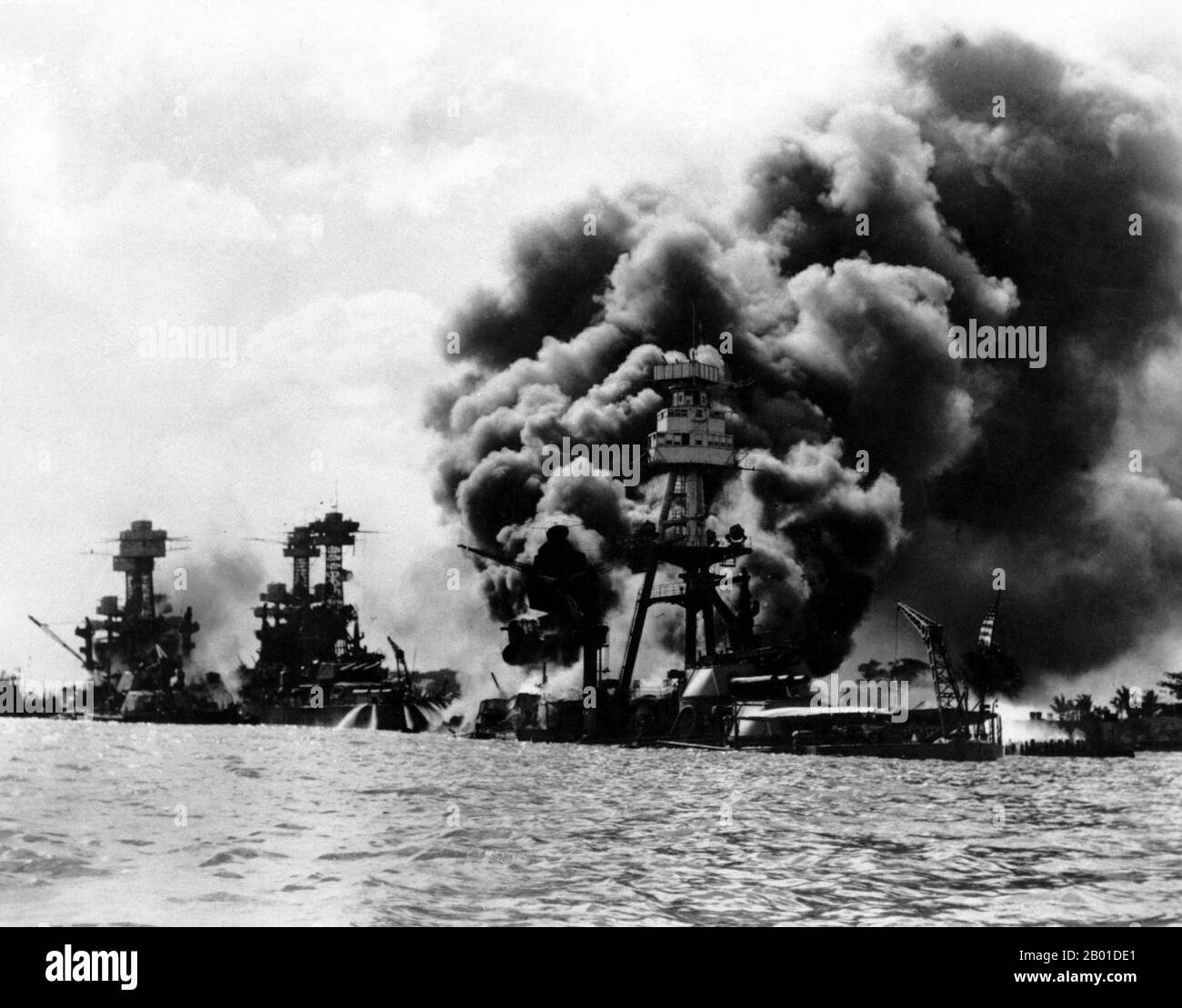 USA/Japan: The USS Tennessee and USS West Virginia (left) and the wreck of the USS Arizona, after the Japanese attack on Pearl Harbour, December 7, 1941. The attack on Pearl Harbor was a surprise military strike conducted by the Imperial Japanese Navy against the United States naval base at Pearl Harbor, Hawaii, on the morning of December 7, 1941 (December 8 in Japan). The attack was intended as a preventive action in order to keep the U.S. Pacific Fleet from interfering with military actions the Empire of Japan was planning in Southeast Asia. Stock Photohttps://www.alamy.com/image-license-details/?v=1https://www.alamy.com/usajapan-the-uss-tennessee-and-uss-west-virginia-left-and-the-wreck-of-the-uss-arizona-after-the-japanese-attack-on-pearl-harbour-december-7-1941-the-attack-on-pearl-harbor-was-a-surprise-military-strike-conducted-by-the-imperial-japanese-navy-against-the-united-states-naval-base-at-pearl-harbor-hawaii-on-the-morning-of-december-7-1941-december-8-in-japan-the-attack-was-intended-as-a-preventive-action-in-order-to-keep-the-us-pacific-fleet-from-interfering-with-military-actions-the-empire-of-japan-was-planning-in-southeast-asia-image344239897.html
USA/Japan: The USS Tennessee and USS West Virginia (left) and the wreck of the USS Arizona, after the Japanese attack on Pearl Harbour, December 7, 1941. The attack on Pearl Harbor was a surprise military strike conducted by the Imperial Japanese Navy against the United States naval base at Pearl Harbor, Hawaii, on the morning of December 7, 1941 (December 8 in Japan). The attack was intended as a preventive action in order to keep the U.S. Pacific Fleet from interfering with military actions the Empire of Japan was planning in Southeast Asia. Stock Photohttps://www.alamy.com/image-license-details/?v=1https://www.alamy.com/usajapan-the-uss-tennessee-and-uss-west-virginia-left-and-the-wreck-of-the-uss-arizona-after-the-japanese-attack-on-pearl-harbour-december-7-1941-the-attack-on-pearl-harbor-was-a-surprise-military-strike-conducted-by-the-imperial-japanese-navy-against-the-united-states-naval-base-at-pearl-harbor-hawaii-on-the-morning-of-december-7-1941-december-8-in-japan-the-attack-was-intended-as-a-preventive-action-in-order-to-keep-the-us-pacific-fleet-from-interfering-with-military-actions-the-empire-of-japan-was-planning-in-southeast-asia-image344239897.htmlRM2B01DE1–USA/Japan: The USS Tennessee and USS West Virginia (left) and the wreck of the USS Arizona, after the Japanese attack on Pearl Harbour, December 7, 1941. The attack on Pearl Harbor was a surprise military strike conducted by the Imperial Japanese Navy against the United States naval base at Pearl Harbor, Hawaii, on the morning of December 7, 1941 (December 8 in Japan). The attack was intended as a preventive action in order to keep the U.S. Pacific Fleet from interfering with military actions the Empire of Japan was planning in Southeast Asia.
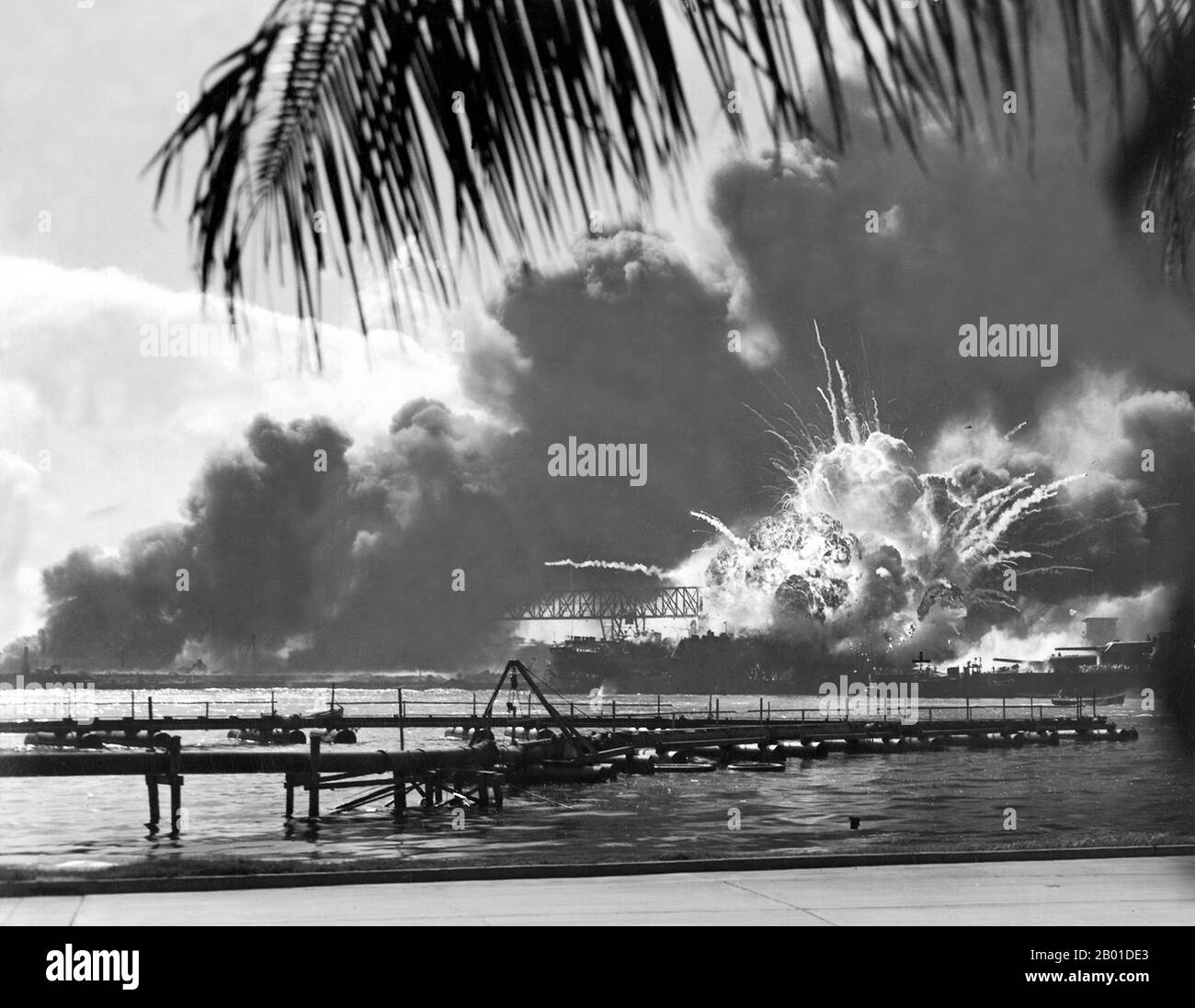 USA/Japan: The USS Shaw exploding during the Japanese attack on Pearl Harbour, December 7, 1941. The attack on Pearl Harbor was a surprise military strike conducted by the Imperial Japanese Navy against the United States naval base at Pearl Harbor, Hawaii, on the morning of December 7, 1941 (December 8 in Japan). The attack was intended as a preventive action in order to keep the U.S. Pacific Fleet from interfering with military actions the Empire of Japan was planning in Southeast Asia against overseas territories of the United Kingdom, the Netherlands, and the United States. Stock Photohttps://www.alamy.com/image-license-details/?v=1https://www.alamy.com/usajapan-the-uss-shaw-exploding-during-the-japanese-attack-on-pearl-harbour-december-7-1941-the-attack-on-pearl-harbor-was-a-surprise-military-strike-conducted-by-the-imperial-japanese-navy-against-the-united-states-naval-base-at-pearl-harbor-hawaii-on-the-morning-of-december-7-1941-december-8-in-japan-the-attack-was-intended-as-a-preventive-action-in-order-to-keep-the-us-pacific-fleet-from-interfering-with-military-actions-the-empire-of-japan-was-planning-in-southeast-asia-against-overseas-territories-of-the-united-kingdom-the-netherlands-and-the-united-states-image344239899.html
USA/Japan: The USS Shaw exploding during the Japanese attack on Pearl Harbour, December 7, 1941. The attack on Pearl Harbor was a surprise military strike conducted by the Imperial Japanese Navy against the United States naval base at Pearl Harbor, Hawaii, on the morning of December 7, 1941 (December 8 in Japan). The attack was intended as a preventive action in order to keep the U.S. Pacific Fleet from interfering with military actions the Empire of Japan was planning in Southeast Asia against overseas territories of the United Kingdom, the Netherlands, and the United States. Stock Photohttps://www.alamy.com/image-license-details/?v=1https://www.alamy.com/usajapan-the-uss-shaw-exploding-during-the-japanese-attack-on-pearl-harbour-december-7-1941-the-attack-on-pearl-harbor-was-a-surprise-military-strike-conducted-by-the-imperial-japanese-navy-against-the-united-states-naval-base-at-pearl-harbor-hawaii-on-the-morning-of-december-7-1941-december-8-in-japan-the-attack-was-intended-as-a-preventive-action-in-order-to-keep-the-us-pacific-fleet-from-interfering-with-military-actions-the-empire-of-japan-was-planning-in-southeast-asia-against-overseas-territories-of-the-united-kingdom-the-netherlands-and-the-united-states-image344239899.htmlRM2B01DE3–USA/Japan: The USS Shaw exploding during the Japanese attack on Pearl Harbour, December 7, 1941. The attack on Pearl Harbor was a surprise military strike conducted by the Imperial Japanese Navy against the United States naval base at Pearl Harbor, Hawaii, on the morning of December 7, 1941 (December 8 in Japan). The attack was intended as a preventive action in order to keep the U.S. Pacific Fleet from interfering with military actions the Empire of Japan was planning in Southeast Asia against overseas territories of the United Kingdom, the Netherlands, and the United States.
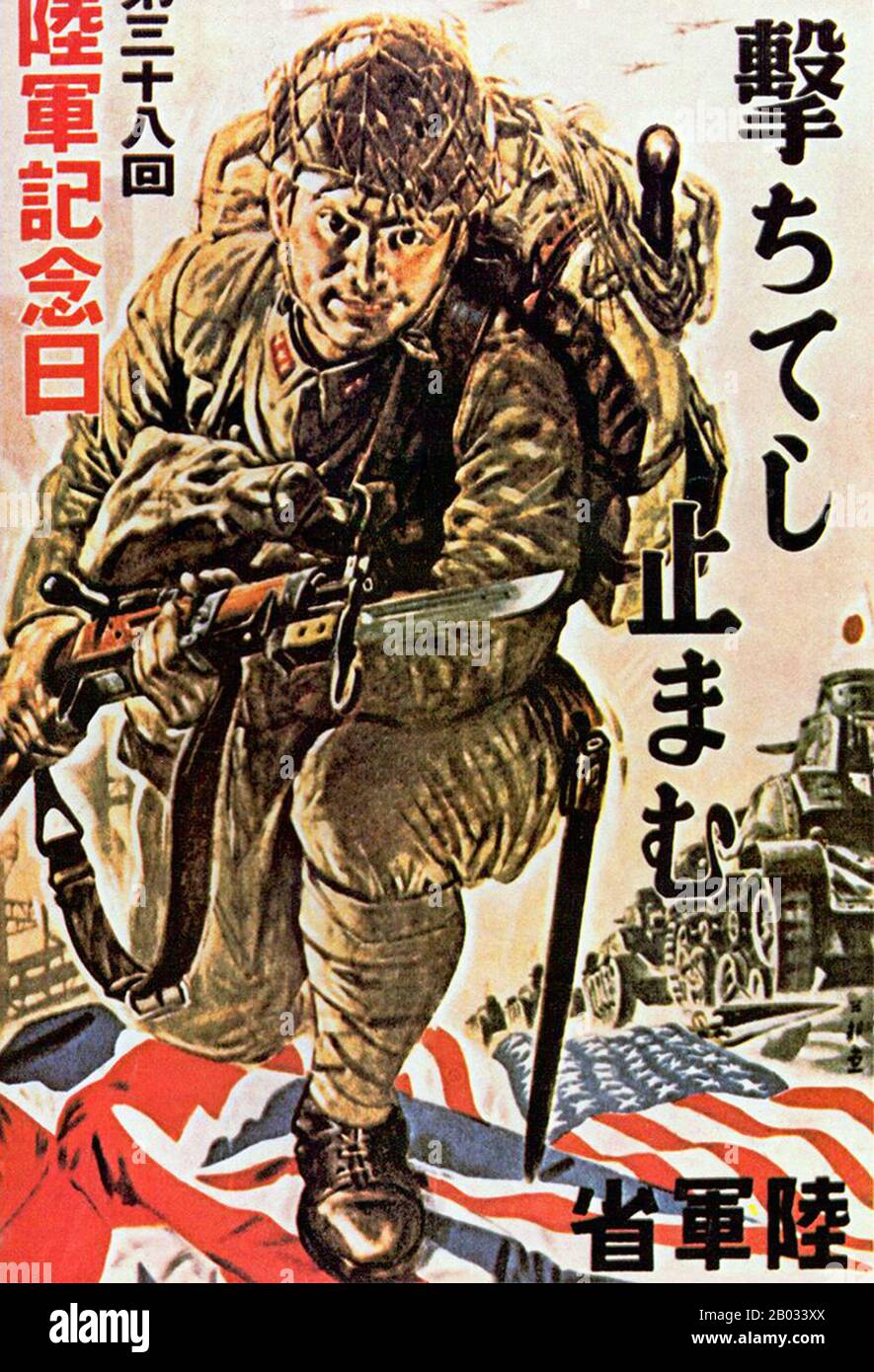 The Pacific War, also sometimes called the Asia-Pacific War, refers broadly to the parts of World War II that took place in the Pacific Ocean, its islands, and in the Far East. The term Pacific War is used to encompass the Pacific Ocean theatre, the South West Pacific theatre, the South-East Asian theatre and the Second Sino-Japanese War, also including the 1945 Soviet-Japanese conflict. It is generally considered that the Pacific War began on 7/8 December 1941 with the Japanese invasion of Thailand for the invasion of British Malaya, and the attack on Pearl Harbor in the United States' Terri Stock Photohttps://www.alamy.com/image-license-details/?v=1https://www.alamy.com/the-pacific-war-also-sometimes-called-the-asia-pacific-war-refers-broadly-to-the-parts-of-world-war-ii-that-took-place-in-the-pacific-ocean-its-islands-and-in-the-far-east-the-term-pacific-war-is-used-to-encompass-the-pacific-ocean-theatre-the-south-west-pacific-theatre-the-south-east-asian-theatre-and-the-second-sino-japanese-war-also-including-the-1945-soviet-japanese-conflict-it-is-generally-considered-that-the-pacific-war-began-on-78-december-1941-with-the-japanese-invasion-of-thailand-for-the-invasion-of-british-malaya-and-the-attack-on-pearl-harbor-in-the-united-states-terri-image344276322.html
The Pacific War, also sometimes called the Asia-Pacific War, refers broadly to the parts of World War II that took place in the Pacific Ocean, its islands, and in the Far East. The term Pacific War is used to encompass the Pacific Ocean theatre, the South West Pacific theatre, the South-East Asian theatre and the Second Sino-Japanese War, also including the 1945 Soviet-Japanese conflict. It is generally considered that the Pacific War began on 7/8 December 1941 with the Japanese invasion of Thailand for the invasion of British Malaya, and the attack on Pearl Harbor in the United States' Terri Stock Photohttps://www.alamy.com/image-license-details/?v=1https://www.alamy.com/the-pacific-war-also-sometimes-called-the-asia-pacific-war-refers-broadly-to-the-parts-of-world-war-ii-that-took-place-in-the-pacific-ocean-its-islands-and-in-the-far-east-the-term-pacific-war-is-used-to-encompass-the-pacific-ocean-theatre-the-south-west-pacific-theatre-the-south-east-asian-theatre-and-the-second-sino-japanese-war-also-including-the-1945-soviet-japanese-conflict-it-is-generally-considered-that-the-pacific-war-began-on-78-december-1941-with-the-japanese-invasion-of-thailand-for-the-invasion-of-british-malaya-and-the-attack-on-pearl-harbor-in-the-united-states-terri-image344276322.htmlRM2B033XX–The Pacific War, also sometimes called the Asia-Pacific War, refers broadly to the parts of World War II that took place in the Pacific Ocean, its islands, and in the Far East. The term Pacific War is used to encompass the Pacific Ocean theatre, the South West Pacific theatre, the South-East Asian theatre and the Second Sino-Japanese War, also including the 1945 Soviet-Japanese conflict. It is generally considered that the Pacific War began on 7/8 December 1941 with the Japanese invasion of Thailand for the invasion of British Malaya, and the attack on Pearl Harbor in the United States' Terri
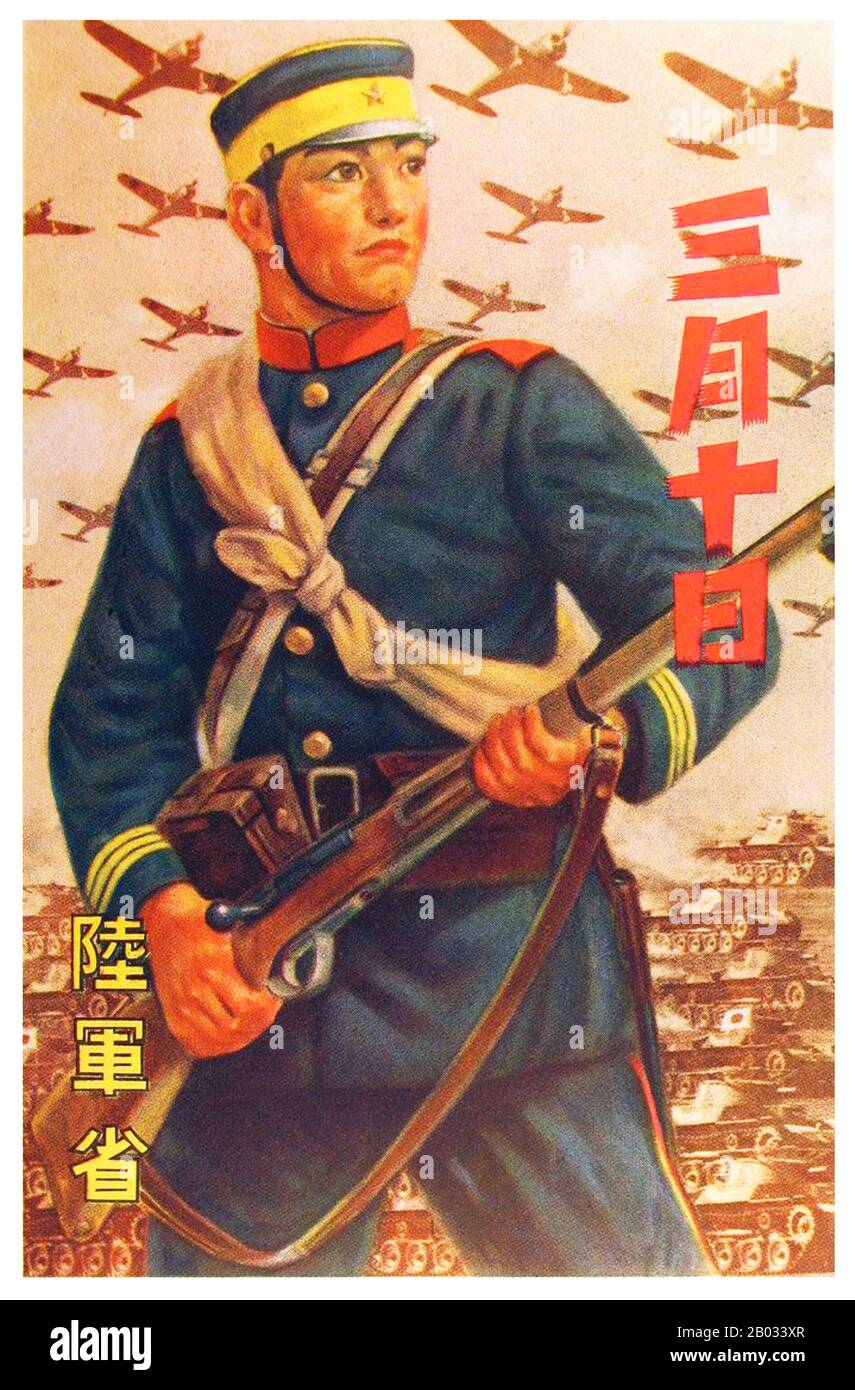 The Pacific War, also sometimes called the Asia-Pacific War, refers broadly to the parts of World War II that took place in the Pacific Ocean, its islands, and in the Far East. The term Pacific War is used to encompass the Pacific Ocean theatre, the South West Pacific theatre, the South-East Asian theatre and the Second Sino-Japanese War, also including the 1945 Soviet-Japanese conflict. It is generally considered that the Pacific War began on 7/8 December 1941 with the Japanese invasion of Thailand for the invasion of British Malaya, and the attack on Pearl Harbor in the United States' Terri Stock Photohttps://www.alamy.com/image-license-details/?v=1https://www.alamy.com/the-pacific-war-also-sometimes-called-the-asia-pacific-war-refers-broadly-to-the-parts-of-world-war-ii-that-took-place-in-the-pacific-ocean-its-islands-and-in-the-far-east-the-term-pacific-war-is-used-to-encompass-the-pacific-ocean-theatre-the-south-west-pacific-theatre-the-south-east-asian-theatre-and-the-second-sino-japanese-war-also-including-the-1945-soviet-japanese-conflict-it-is-generally-considered-that-the-pacific-war-began-on-78-december-1941-with-the-japanese-invasion-of-thailand-for-the-invasion-of-british-malaya-and-the-attack-on-pearl-harbor-in-the-united-states-terri-image344276319.html
The Pacific War, also sometimes called the Asia-Pacific War, refers broadly to the parts of World War II that took place in the Pacific Ocean, its islands, and in the Far East. The term Pacific War is used to encompass the Pacific Ocean theatre, the South West Pacific theatre, the South-East Asian theatre and the Second Sino-Japanese War, also including the 1945 Soviet-Japanese conflict. It is generally considered that the Pacific War began on 7/8 December 1941 with the Japanese invasion of Thailand for the invasion of British Malaya, and the attack on Pearl Harbor in the United States' Terri Stock Photohttps://www.alamy.com/image-license-details/?v=1https://www.alamy.com/the-pacific-war-also-sometimes-called-the-asia-pacific-war-refers-broadly-to-the-parts-of-world-war-ii-that-took-place-in-the-pacific-ocean-its-islands-and-in-the-far-east-the-term-pacific-war-is-used-to-encompass-the-pacific-ocean-theatre-the-south-west-pacific-theatre-the-south-east-asian-theatre-and-the-second-sino-japanese-war-also-including-the-1945-soviet-japanese-conflict-it-is-generally-considered-that-the-pacific-war-began-on-78-december-1941-with-the-japanese-invasion-of-thailand-for-the-invasion-of-british-malaya-and-the-attack-on-pearl-harbor-in-the-united-states-terri-image344276319.htmlRM2B033XR–The Pacific War, also sometimes called the Asia-Pacific War, refers broadly to the parts of World War II that took place in the Pacific Ocean, its islands, and in the Far East. The term Pacific War is used to encompass the Pacific Ocean theatre, the South West Pacific theatre, the South-East Asian theatre and the Second Sino-Japanese War, also including the 1945 Soviet-Japanese conflict. It is generally considered that the Pacific War began on 7/8 December 1941 with the Japanese invasion of Thailand for the invasion of British Malaya, and the attack on Pearl Harbor in the United States' Terri
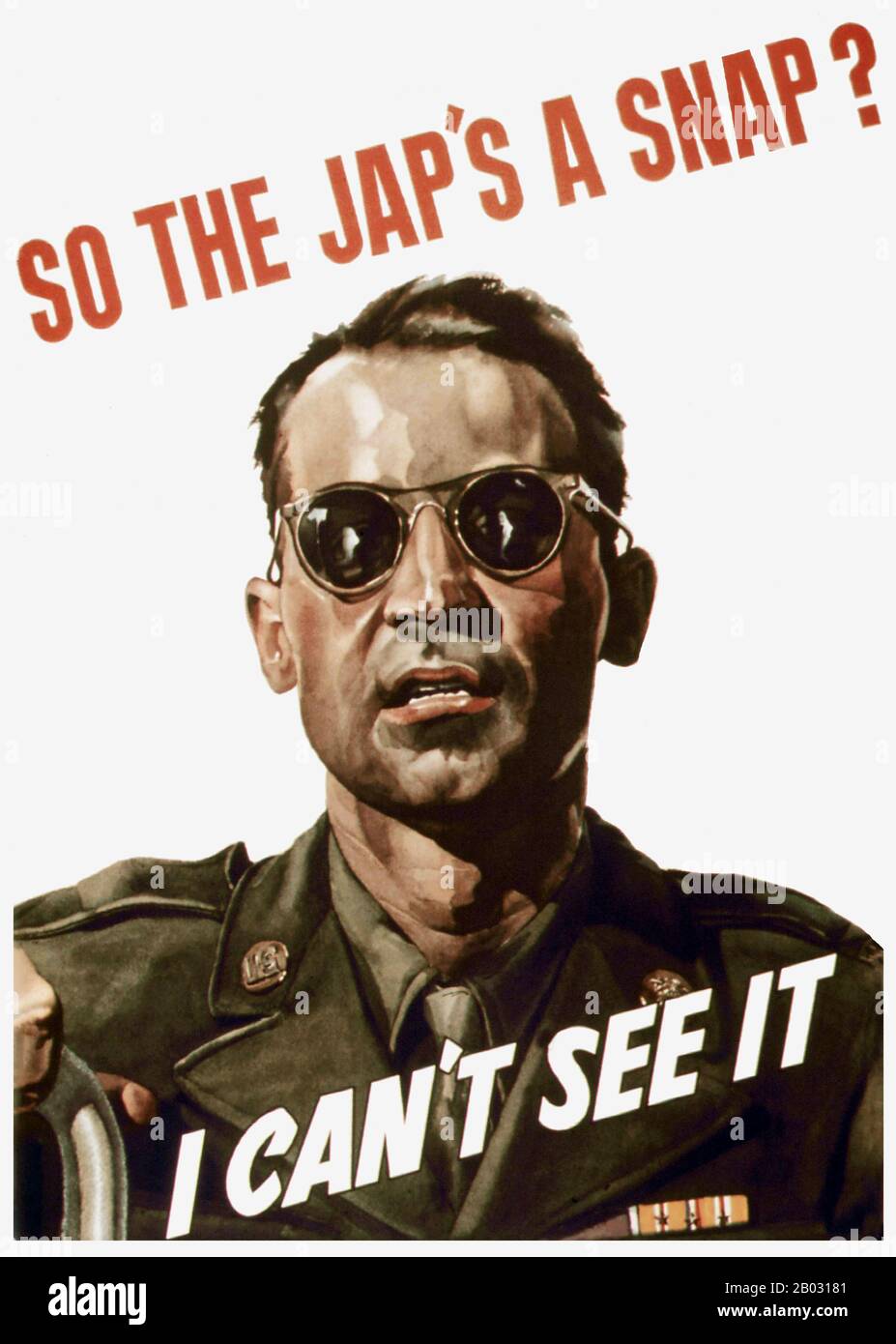 The Pacific War, also sometimes called the Asia-Pacific War, refers broadly to the parts of World War II that took place in the Pacific Ocean, its islands, and in the Far East. The term Pacific War is used to encompass the Pacific Ocean theatre, the South West Pacific theatre, the South-East Asian theatre and the Second Sino-Japanese War, also including the 1945 Soviet-Japanese conflict. It is generally considered that the Pacific War began on 7/8 December 1941 with the Japanese invasion of Thailand for the invasion of British Malaya, and the attack on Pearl Harbor in the United States' Terri Stock Photohttps://www.alamy.com/image-license-details/?v=1https://www.alamy.com/the-pacific-war-also-sometimes-called-the-asia-pacific-war-refers-broadly-to-the-parts-of-world-war-ii-that-took-place-in-the-pacific-ocean-its-islands-and-in-the-far-east-the-term-pacific-war-is-used-to-encompass-the-pacific-ocean-theatre-the-south-west-pacific-theatre-the-south-east-asian-theatre-and-the-second-sino-japanese-war-also-including-the-1945-soviet-japanese-conflict-it-is-generally-considered-that-the-pacific-war-began-on-78-december-1941-with-the-japanese-invasion-of-thailand-for-the-invasion-of-british-malaya-and-the-attack-on-pearl-harbor-in-the-united-states-terri-image344274225.html
The Pacific War, also sometimes called the Asia-Pacific War, refers broadly to the parts of World War II that took place in the Pacific Ocean, its islands, and in the Far East. The term Pacific War is used to encompass the Pacific Ocean theatre, the South West Pacific theatre, the South-East Asian theatre and the Second Sino-Japanese War, also including the 1945 Soviet-Japanese conflict. It is generally considered that the Pacific War began on 7/8 December 1941 with the Japanese invasion of Thailand for the invasion of British Malaya, and the attack on Pearl Harbor in the United States' Terri Stock Photohttps://www.alamy.com/image-license-details/?v=1https://www.alamy.com/the-pacific-war-also-sometimes-called-the-asia-pacific-war-refers-broadly-to-the-parts-of-world-war-ii-that-took-place-in-the-pacific-ocean-its-islands-and-in-the-far-east-the-term-pacific-war-is-used-to-encompass-the-pacific-ocean-theatre-the-south-west-pacific-theatre-the-south-east-asian-theatre-and-the-second-sino-japanese-war-also-including-the-1945-soviet-japanese-conflict-it-is-generally-considered-that-the-pacific-war-began-on-78-december-1941-with-the-japanese-invasion-of-thailand-for-the-invasion-of-british-malaya-and-the-attack-on-pearl-harbor-in-the-united-states-terri-image344274225.htmlRM2B03181–The Pacific War, also sometimes called the Asia-Pacific War, refers broadly to the parts of World War II that took place in the Pacific Ocean, its islands, and in the Far East. The term Pacific War is used to encompass the Pacific Ocean theatre, the South West Pacific theatre, the South-East Asian theatre and the Second Sino-Japanese War, also including the 1945 Soviet-Japanese conflict. It is generally considered that the Pacific War began on 7/8 December 1941 with the Japanese invasion of Thailand for the invasion of British Malaya, and the attack on Pearl Harbor in the United States' Terri
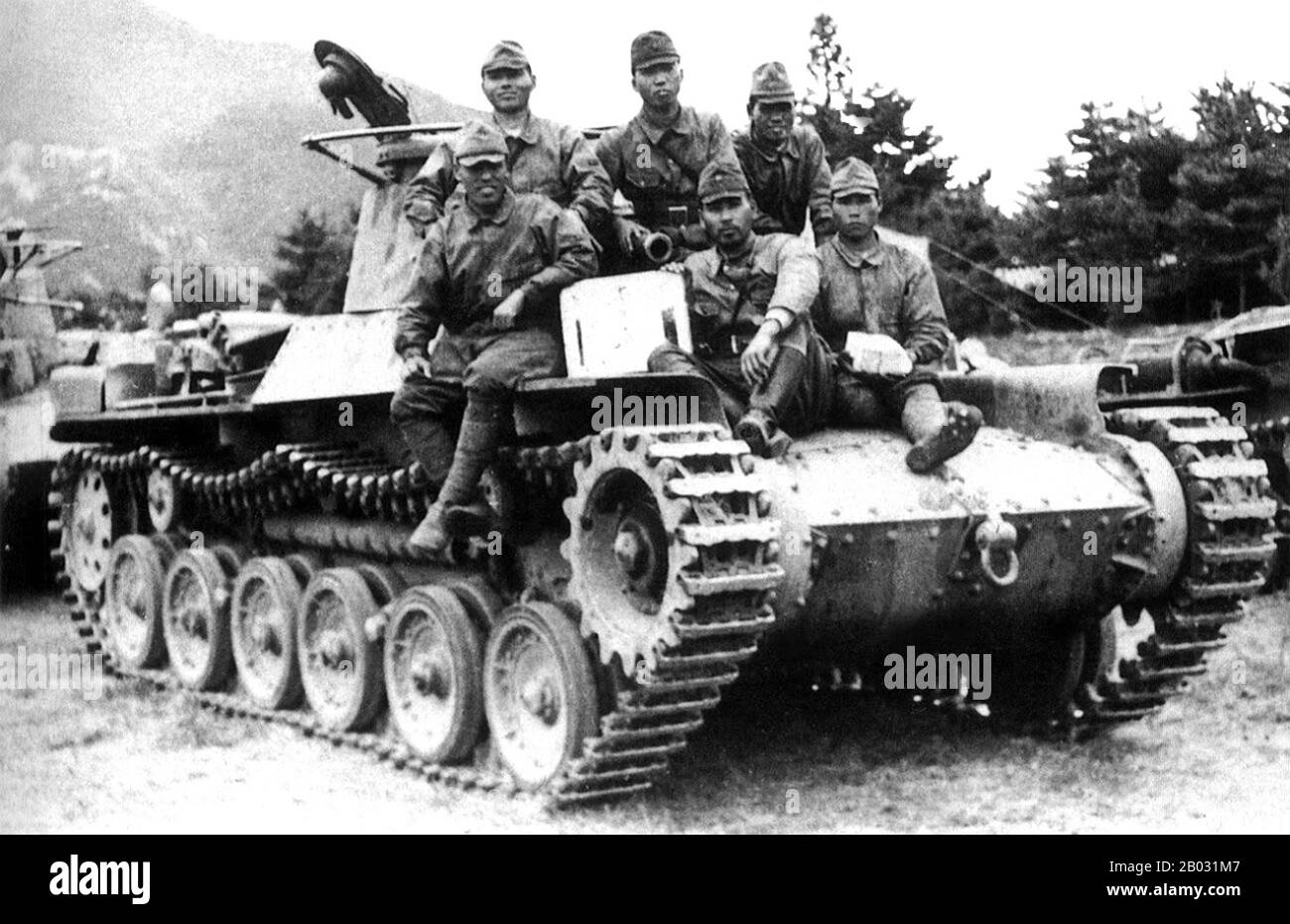 The Second Sino-Japanese War (July 7, 1937 – September 9, 1945) was a military conflict fought primarily between the Republic of China and the Empire of Japan. After the Japanese attack on Pearl Harbor, the war merged into the greater conflict of World War II as a major front of what is broadly known as the Pacific War. Although the two countries had fought intermittently since 1931, total war started in earnest in 1937 and ended only with the surrender of Japan in 1945. The war was the result of a decades-long Japanese imperialist policy aiming to dominate China politically and militarily a Stock Photohttps://www.alamy.com/image-license-details/?v=1https://www.alamy.com/the-second-sino-japanese-war-july-7-1937-september-9-1945-was-a-military-conflict-fought-primarily-between-the-republic-of-china-and-the-empire-of-japan-after-the-japanese-attack-on-pearl-harbor-the-war-merged-into-the-greater-conflict-of-world-war-ii-as-a-major-front-of-what-is-broadly-known-as-the-pacific-war-although-the-two-countries-had-fought-intermittently-since-1931-total-war-started-in-earnest-in-1937-and-ended-only-with-the-surrender-of-japan-in-1945-the-war-was-the-result-of-a-decades-long-japanese-imperialist-policy-aiming-to-dominate-china-politically-and-militarily-a-image344274567.html
The Second Sino-Japanese War (July 7, 1937 – September 9, 1945) was a military conflict fought primarily between the Republic of China and the Empire of Japan. After the Japanese attack on Pearl Harbor, the war merged into the greater conflict of World War II as a major front of what is broadly known as the Pacific War. Although the two countries had fought intermittently since 1931, total war started in earnest in 1937 and ended only with the surrender of Japan in 1945. The war was the result of a decades-long Japanese imperialist policy aiming to dominate China politically and militarily a Stock Photohttps://www.alamy.com/image-license-details/?v=1https://www.alamy.com/the-second-sino-japanese-war-july-7-1937-september-9-1945-was-a-military-conflict-fought-primarily-between-the-republic-of-china-and-the-empire-of-japan-after-the-japanese-attack-on-pearl-harbor-the-war-merged-into-the-greater-conflict-of-world-war-ii-as-a-major-front-of-what-is-broadly-known-as-the-pacific-war-although-the-two-countries-had-fought-intermittently-since-1931-total-war-started-in-earnest-in-1937-and-ended-only-with-the-surrender-of-japan-in-1945-the-war-was-the-result-of-a-decades-long-japanese-imperialist-policy-aiming-to-dominate-china-politically-and-militarily-a-image344274567.htmlRM2B031M7–The Second Sino-Japanese War (July 7, 1937 – September 9, 1945) was a military conflict fought primarily between the Republic of China and the Empire of Japan. After the Japanese attack on Pearl Harbor, the war merged into the greater conflict of World War II as a major front of what is broadly known as the Pacific War. Although the two countries had fought intermittently since 1931, total war started in earnest in 1937 and ended only with the surrender of Japan in 1945. The war was the result of a decades-long Japanese imperialist policy aiming to dominate China politically and militarily a
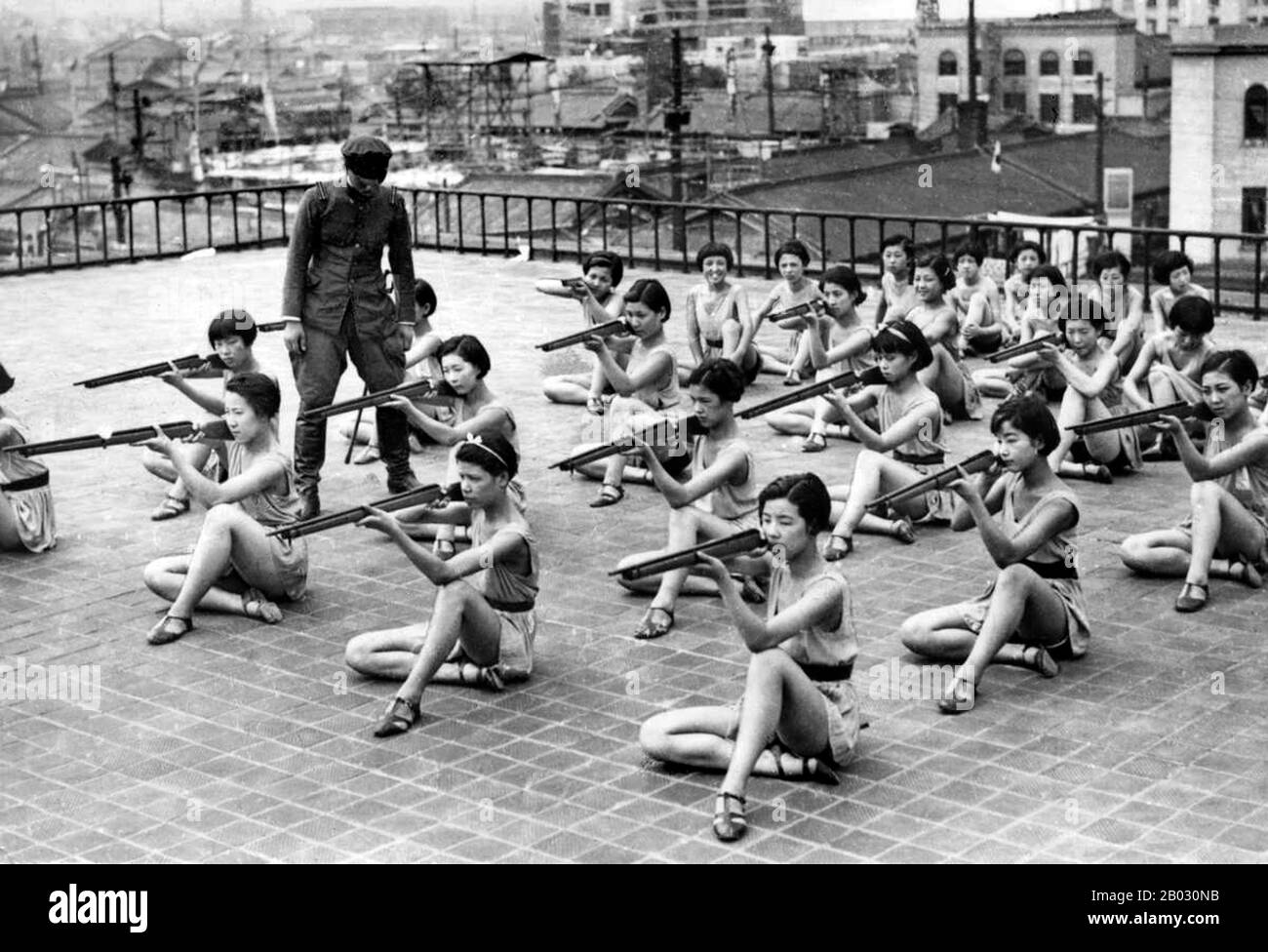 The Second Sino-Japanese War (July 7, 1937 – September 9, 1945) was a military conflict fought primarily between the Republic of China and the Empire of Japan. After the Japanese attack on Pearl Harbor, the war merged into the greater conflict of World War II as a major front of what is broadly known as the Pacific War. Although the two countries had fought intermittently since 1931, total war started in earnest in 1937 and ended only with the surrender of Japan in 1945. The war was the result of a decades-long Japanese imperialist policy aiming to dominate China politically and militarily an Stock Photohttps://www.alamy.com/image-license-details/?v=1https://www.alamy.com/the-second-sino-japanese-war-july-7-1937-september-9-1945-was-a-military-conflict-fought-primarily-between-the-republic-of-china-and-the-empire-of-japan-after-the-japanese-attack-on-pearl-harbor-the-war-merged-into-the-greater-conflict-of-world-war-ii-as-a-major-front-of-what-is-broadly-known-as-the-pacific-war-although-the-two-countries-had-fought-intermittently-since-1931-total-war-started-in-earnest-in-1937-and-ended-only-with-the-surrender-of-japan-in-1945-the-war-was-the-result-of-a-decades-long-japanese-imperialist-policy-aiming-to-dominate-china-politically-and-militarily-an-image344273815.html
The Second Sino-Japanese War (July 7, 1937 – September 9, 1945) was a military conflict fought primarily between the Republic of China and the Empire of Japan. After the Japanese attack on Pearl Harbor, the war merged into the greater conflict of World War II as a major front of what is broadly known as the Pacific War. Although the two countries had fought intermittently since 1931, total war started in earnest in 1937 and ended only with the surrender of Japan in 1945. The war was the result of a decades-long Japanese imperialist policy aiming to dominate China politically and militarily an Stock Photohttps://www.alamy.com/image-license-details/?v=1https://www.alamy.com/the-second-sino-japanese-war-july-7-1937-september-9-1945-was-a-military-conflict-fought-primarily-between-the-republic-of-china-and-the-empire-of-japan-after-the-japanese-attack-on-pearl-harbor-the-war-merged-into-the-greater-conflict-of-world-war-ii-as-a-major-front-of-what-is-broadly-known-as-the-pacific-war-although-the-two-countries-had-fought-intermittently-since-1931-total-war-started-in-earnest-in-1937-and-ended-only-with-the-surrender-of-japan-in-1945-the-war-was-the-result-of-a-decades-long-japanese-imperialist-policy-aiming-to-dominate-china-politically-and-militarily-an-image344273815.htmlRM2B030NB–The Second Sino-Japanese War (July 7, 1937 – September 9, 1945) was a military conflict fought primarily between the Republic of China and the Empire of Japan. After the Japanese attack on Pearl Harbor, the war merged into the greater conflict of World War II as a major front of what is broadly known as the Pacific War. Although the two countries had fought intermittently since 1931, total war started in earnest in 1937 and ended only with the surrender of Japan in 1945. The war was the result of a decades-long Japanese imperialist policy aiming to dominate China politically and militarily an
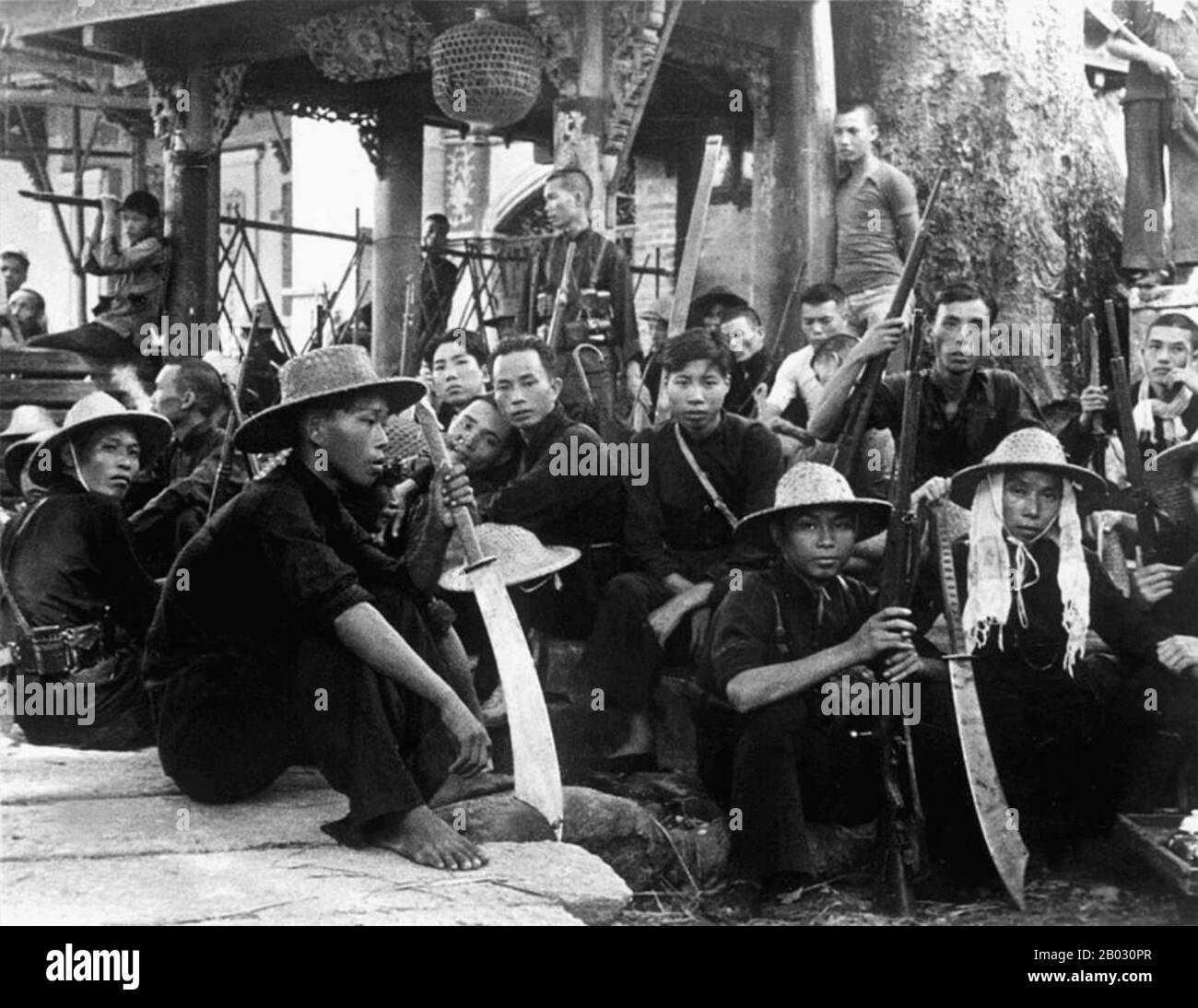 The Second Sino-Japanese War (July 7, 1937 – September 9, 1945) was a military conflict fought primarily between the Republic of China and the Empire of Japan. After the Japanese attack on Pearl Harbor, the war merged into the greater conflict of World War II as a major front of what is broadly known as the Pacific War. Although the two countries had fought intermittently since 1931, total war started in earnest in 1937 and ended only with the surrender of Japan in 1945. The war was the result of a decades-long Japanese imperialist policy aiming to dominate China politically and militarily an Stock Photohttps://www.alamy.com/image-license-details/?v=1https://www.alamy.com/the-second-sino-japanese-war-july-7-1937-september-9-1945-was-a-military-conflict-fought-primarily-between-the-republic-of-china-and-the-empire-of-japan-after-the-japanese-attack-on-pearl-harbor-the-war-merged-into-the-greater-conflict-of-world-war-ii-as-a-major-front-of-what-is-broadly-known-as-the-pacific-war-although-the-two-countries-had-fought-intermittently-since-1931-total-war-started-in-earnest-in-1937-and-ended-only-with-the-surrender-of-japan-in-1945-the-war-was-the-result-of-a-decades-long-japanese-imperialist-policy-aiming-to-dominate-china-politically-and-militarily-an-image344273855.html
The Second Sino-Japanese War (July 7, 1937 – September 9, 1945) was a military conflict fought primarily between the Republic of China and the Empire of Japan. After the Japanese attack on Pearl Harbor, the war merged into the greater conflict of World War II as a major front of what is broadly known as the Pacific War. Although the two countries had fought intermittently since 1931, total war started in earnest in 1937 and ended only with the surrender of Japan in 1945. The war was the result of a decades-long Japanese imperialist policy aiming to dominate China politically and militarily an Stock Photohttps://www.alamy.com/image-license-details/?v=1https://www.alamy.com/the-second-sino-japanese-war-july-7-1937-september-9-1945-was-a-military-conflict-fought-primarily-between-the-republic-of-china-and-the-empire-of-japan-after-the-japanese-attack-on-pearl-harbor-the-war-merged-into-the-greater-conflict-of-world-war-ii-as-a-major-front-of-what-is-broadly-known-as-the-pacific-war-although-the-two-countries-had-fought-intermittently-since-1931-total-war-started-in-earnest-in-1937-and-ended-only-with-the-surrender-of-japan-in-1945-the-war-was-the-result-of-a-decades-long-japanese-imperialist-policy-aiming-to-dominate-china-politically-and-militarily-an-image344273855.htmlRM2B030PR–The Second Sino-Japanese War (July 7, 1937 – September 9, 1945) was a military conflict fought primarily between the Republic of China and the Empire of Japan. After the Japanese attack on Pearl Harbor, the war merged into the greater conflict of World War II as a major front of what is broadly known as the Pacific War. Although the two countries had fought intermittently since 1931, total war started in earnest in 1937 and ended only with the surrender of Japan in 1945. The war was the result of a decades-long Japanese imperialist policy aiming to dominate China politically and militarily an
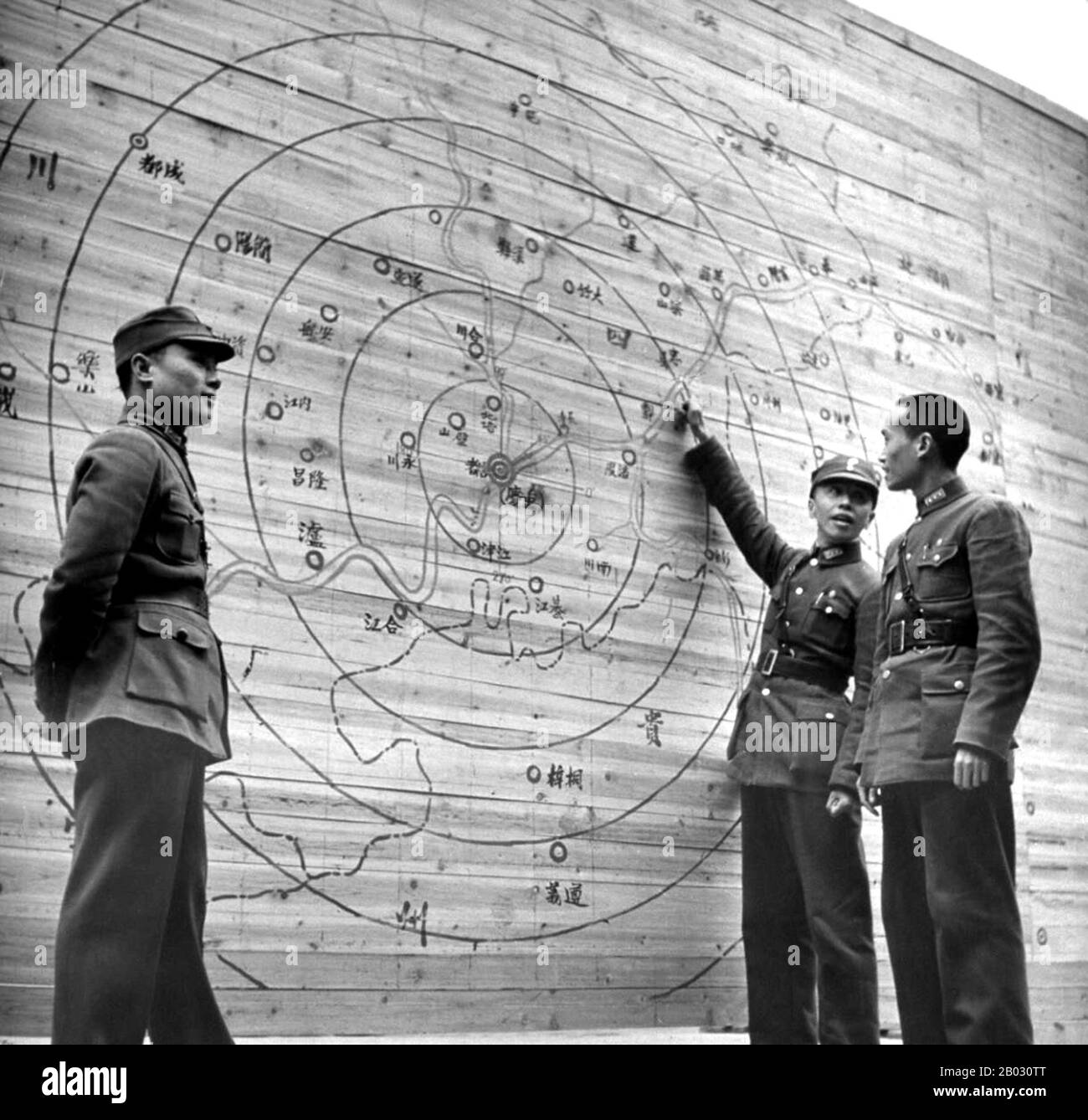 The Second Sino-Japanese War (July 7, 1937 – September 9, 1945) was a military conflict fought primarily between the Republic of China and the Empire of Japan. After the Japanese attack on Pearl Harbor, the war merged into the greater conflict of World War II as a major front of what is broadly known as the Pacific War. Although the two countries had fought intermittently since 1931, total war started in earnest in 1937 and ended only with the surrender of Japan in 1945. The war was the result of a decades-long Japanese imperialist policy aiming to dominate China politically and militarily an Stock Photohttps://www.alamy.com/image-license-details/?v=1https://www.alamy.com/the-second-sino-japanese-war-july-7-1937-september-9-1945-was-a-military-conflict-fought-primarily-between-the-republic-of-china-and-the-empire-of-japan-after-the-japanese-attack-on-pearl-harbor-the-war-merged-into-the-greater-conflict-of-world-war-ii-as-a-major-front-of-what-is-broadly-known-as-the-pacific-war-although-the-two-countries-had-fought-intermittently-since-1931-total-war-started-in-earnest-in-1937-and-ended-only-with-the-surrender-of-japan-in-1945-the-war-was-the-result-of-a-decades-long-japanese-imperialist-policy-aiming-to-dominate-china-politically-and-militarily-an-image344273912.html
The Second Sino-Japanese War (July 7, 1937 – September 9, 1945) was a military conflict fought primarily between the Republic of China and the Empire of Japan. After the Japanese attack on Pearl Harbor, the war merged into the greater conflict of World War II as a major front of what is broadly known as the Pacific War. Although the two countries had fought intermittently since 1931, total war started in earnest in 1937 and ended only with the surrender of Japan in 1945. The war was the result of a decades-long Japanese imperialist policy aiming to dominate China politically and militarily an Stock Photohttps://www.alamy.com/image-license-details/?v=1https://www.alamy.com/the-second-sino-japanese-war-july-7-1937-september-9-1945-was-a-military-conflict-fought-primarily-between-the-republic-of-china-and-the-empire-of-japan-after-the-japanese-attack-on-pearl-harbor-the-war-merged-into-the-greater-conflict-of-world-war-ii-as-a-major-front-of-what-is-broadly-known-as-the-pacific-war-although-the-two-countries-had-fought-intermittently-since-1931-total-war-started-in-earnest-in-1937-and-ended-only-with-the-surrender-of-japan-in-1945-the-war-was-the-result-of-a-decades-long-japanese-imperialist-policy-aiming-to-dominate-china-politically-and-militarily-an-image344273912.htmlRM2B030TT–The Second Sino-Japanese War (July 7, 1937 – September 9, 1945) was a military conflict fought primarily between the Republic of China and the Empire of Japan. After the Japanese attack on Pearl Harbor, the war merged into the greater conflict of World War II as a major front of what is broadly known as the Pacific War. Although the two countries had fought intermittently since 1931, total war started in earnest in 1937 and ended only with the surrender of Japan in 1945. The war was the result of a decades-long Japanese imperialist policy aiming to dominate China politically and militarily an
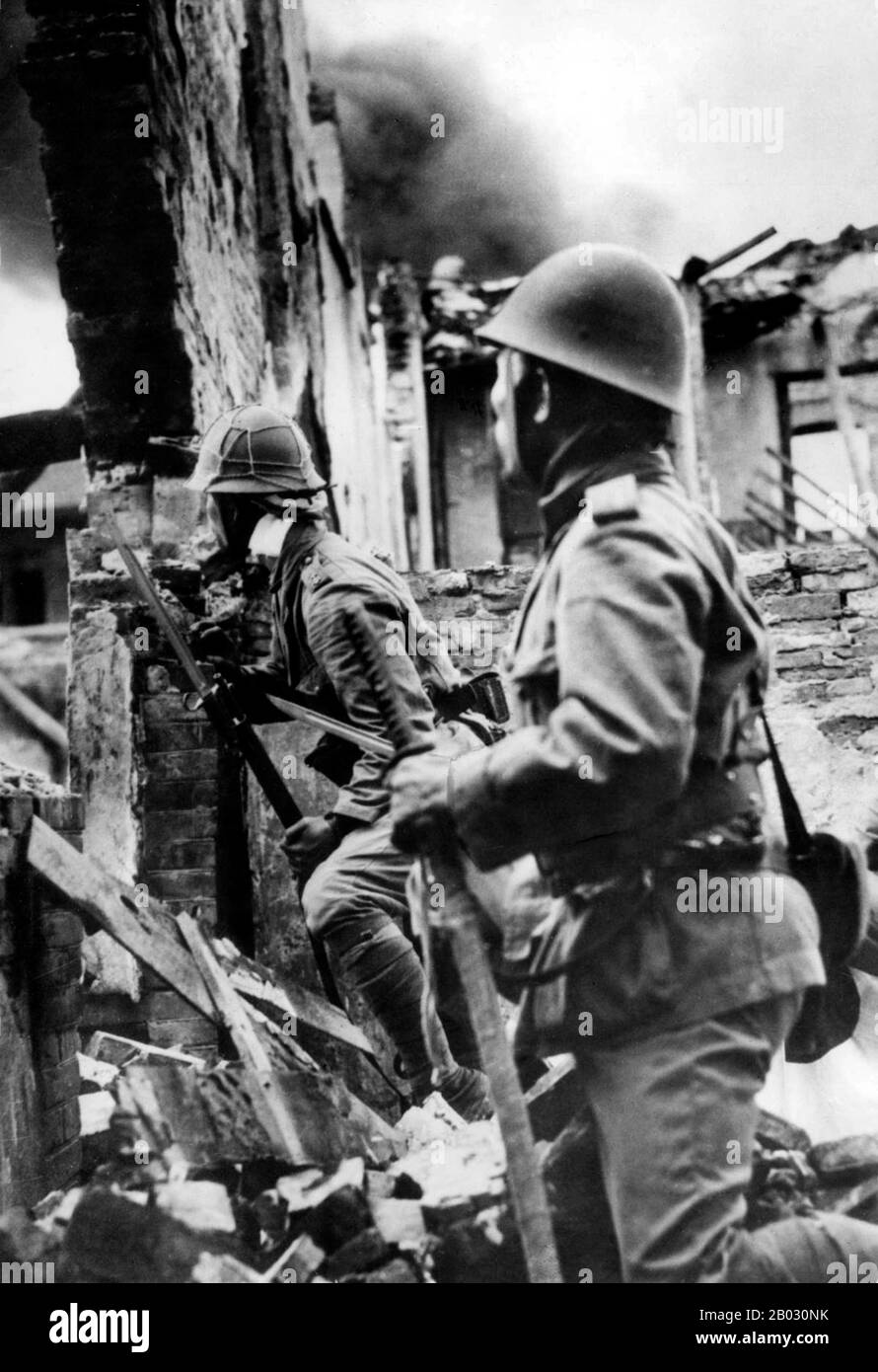 The Second Sino-Japanese War (July 7, 1937 – September 9, 1945) was a military conflict fought primarily between the Republic of China and the Empire of Japan. After the Japanese attack on Pearl Harbor, the war merged into the greater conflict of World War II as a major front of what is broadly known as the Pacific War. Although the two countries had fought intermittently since 1931, total war started in earnest in 1937 and ended only with the surrender of Japan in 1945. The war was the result of a decades-long Japanese imperialist policy aiming to dominate China politically and militarily an Stock Photohttps://www.alamy.com/image-license-details/?v=1https://www.alamy.com/the-second-sino-japanese-war-july-7-1937-september-9-1945-was-a-military-conflict-fought-primarily-between-the-republic-of-china-and-the-empire-of-japan-after-the-japanese-attack-on-pearl-harbor-the-war-merged-into-the-greater-conflict-of-world-war-ii-as-a-major-front-of-what-is-broadly-known-as-the-pacific-war-although-the-two-countries-had-fought-intermittently-since-1931-total-war-started-in-earnest-in-1937-and-ended-only-with-the-surrender-of-japan-in-1945-the-war-was-the-result-of-a-decades-long-japanese-imperialist-policy-aiming-to-dominate-china-politically-and-militarily-an-image344273823.html
The Second Sino-Japanese War (July 7, 1937 – September 9, 1945) was a military conflict fought primarily between the Republic of China and the Empire of Japan. After the Japanese attack on Pearl Harbor, the war merged into the greater conflict of World War II as a major front of what is broadly known as the Pacific War. Although the two countries had fought intermittently since 1931, total war started in earnest in 1937 and ended only with the surrender of Japan in 1945. The war was the result of a decades-long Japanese imperialist policy aiming to dominate China politically and militarily an Stock Photohttps://www.alamy.com/image-license-details/?v=1https://www.alamy.com/the-second-sino-japanese-war-july-7-1937-september-9-1945-was-a-military-conflict-fought-primarily-between-the-republic-of-china-and-the-empire-of-japan-after-the-japanese-attack-on-pearl-harbor-the-war-merged-into-the-greater-conflict-of-world-war-ii-as-a-major-front-of-what-is-broadly-known-as-the-pacific-war-although-the-two-countries-had-fought-intermittently-since-1931-total-war-started-in-earnest-in-1937-and-ended-only-with-the-surrender-of-japan-in-1945-the-war-was-the-result-of-a-decades-long-japanese-imperialist-policy-aiming-to-dominate-china-politically-and-militarily-an-image344273823.htmlRM2B030NK–The Second Sino-Japanese War (July 7, 1937 – September 9, 1945) was a military conflict fought primarily between the Republic of China and the Empire of Japan. After the Japanese attack on Pearl Harbor, the war merged into the greater conflict of World War II as a major front of what is broadly known as the Pacific War. Although the two countries had fought intermittently since 1931, total war started in earnest in 1937 and ended only with the surrender of Japan in 1945. The war was the result of a decades-long Japanese imperialist policy aiming to dominate China politically and militarily an
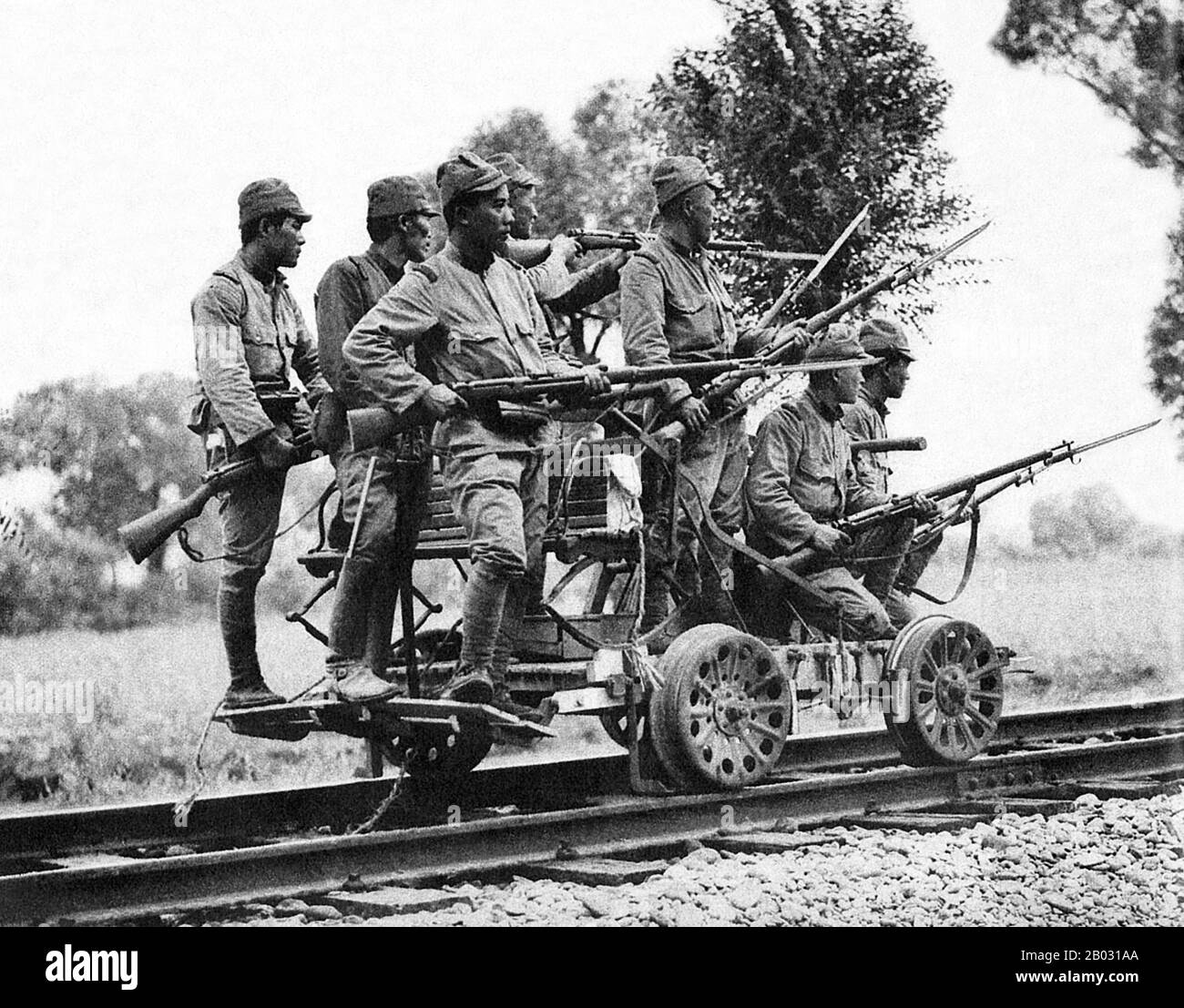 The Second Sino-Japanese War (July 7, 1937 – September 9, 1945) was a military conflict fought primarily between the Republic of China and the Empire of Japan. After the Japanese attack on Pearl Harbor, the war merged into the greater conflict of World War II as a major front of what is broadly known as the Pacific War. Although the two countries had fought intermittently since 1931, total war started in earnest in 1937 and ended only with the surrender of Japan in 1945. The war was the result of a decades-long Japanese imperialist policy aiming to dominate China politically and militarily an Stock Photohttps://www.alamy.com/image-license-details/?v=1https://www.alamy.com/the-second-sino-japanese-war-july-7-1937-september-9-1945-was-a-military-conflict-fought-primarily-between-the-republic-of-china-and-the-empire-of-japan-after-the-japanese-attack-on-pearl-harbor-the-war-merged-into-the-greater-conflict-of-world-war-ii-as-a-major-front-of-what-is-broadly-known-as-the-pacific-war-although-the-two-countries-had-fought-intermittently-since-1931-total-war-started-in-earnest-in-1937-and-ended-only-with-the-surrender-of-japan-in-1945-the-war-was-the-result-of-a-decades-long-japanese-imperialist-policy-aiming-to-dominate-china-politically-and-militarily-an-image344274290.html
The Second Sino-Japanese War (July 7, 1937 – September 9, 1945) was a military conflict fought primarily between the Republic of China and the Empire of Japan. After the Japanese attack on Pearl Harbor, the war merged into the greater conflict of World War II as a major front of what is broadly known as the Pacific War. Although the two countries had fought intermittently since 1931, total war started in earnest in 1937 and ended only with the surrender of Japan in 1945. The war was the result of a decades-long Japanese imperialist policy aiming to dominate China politically and militarily an Stock Photohttps://www.alamy.com/image-license-details/?v=1https://www.alamy.com/the-second-sino-japanese-war-july-7-1937-september-9-1945-was-a-military-conflict-fought-primarily-between-the-republic-of-china-and-the-empire-of-japan-after-the-japanese-attack-on-pearl-harbor-the-war-merged-into-the-greater-conflict-of-world-war-ii-as-a-major-front-of-what-is-broadly-known-as-the-pacific-war-although-the-two-countries-had-fought-intermittently-since-1931-total-war-started-in-earnest-in-1937-and-ended-only-with-the-surrender-of-japan-in-1945-the-war-was-the-result-of-a-decades-long-japanese-imperialist-policy-aiming-to-dominate-china-politically-and-militarily-an-image344274290.htmlRM2B031AA–The Second Sino-Japanese War (July 7, 1937 – September 9, 1945) was a military conflict fought primarily between the Republic of China and the Empire of Japan. After the Japanese attack on Pearl Harbor, the war merged into the greater conflict of World War II as a major front of what is broadly known as the Pacific War. Although the two countries had fought intermittently since 1931, total war started in earnest in 1937 and ended only with the surrender of Japan in 1945. The war was the result of a decades-long Japanese imperialist policy aiming to dominate China politically and militarily an
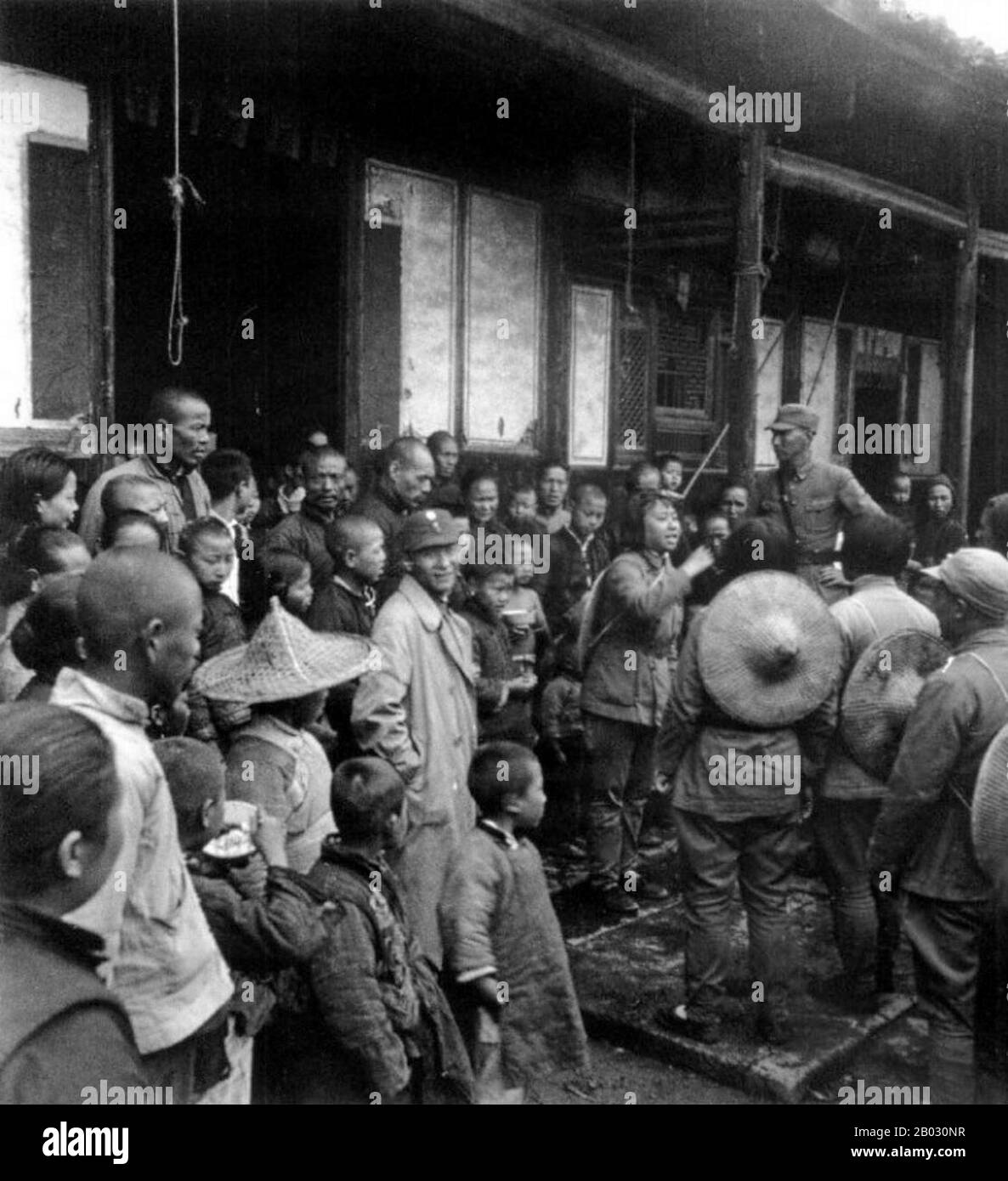 The Second Sino-Japanese War (July 7, 1937 – September 9, 1945) was a military conflict fought primarily between the Republic of China and the Empire of Japan. After the Japanese attack on Pearl Harbor, the war merged into the greater conflict of World War II as a major front of what is broadly known as the Pacific War. Although the two countries had fought intermittently since 1931, total war started in earnest in 1937 and ended only with the surrender of Japan in 1945. The war was the result of a decades-long Japanese imperialist policy aiming to dominate China politically and militarily an Stock Photohttps://www.alamy.com/image-license-details/?v=1https://www.alamy.com/the-second-sino-japanese-war-july-7-1937-september-9-1945-was-a-military-conflict-fought-primarily-between-the-republic-of-china-and-the-empire-of-japan-after-the-japanese-attack-on-pearl-harbor-the-war-merged-into-the-greater-conflict-of-world-war-ii-as-a-major-front-of-what-is-broadly-known-as-the-pacific-war-although-the-two-countries-had-fought-intermittently-since-1931-total-war-started-in-earnest-in-1937-and-ended-only-with-the-surrender-of-japan-in-1945-the-war-was-the-result-of-a-decades-long-japanese-imperialist-policy-aiming-to-dominate-china-politically-and-militarily-an-image344273827.html
The Second Sino-Japanese War (July 7, 1937 – September 9, 1945) was a military conflict fought primarily between the Republic of China and the Empire of Japan. After the Japanese attack on Pearl Harbor, the war merged into the greater conflict of World War II as a major front of what is broadly known as the Pacific War. Although the two countries had fought intermittently since 1931, total war started in earnest in 1937 and ended only with the surrender of Japan in 1945. The war was the result of a decades-long Japanese imperialist policy aiming to dominate China politically and militarily an Stock Photohttps://www.alamy.com/image-license-details/?v=1https://www.alamy.com/the-second-sino-japanese-war-july-7-1937-september-9-1945-was-a-military-conflict-fought-primarily-between-the-republic-of-china-and-the-empire-of-japan-after-the-japanese-attack-on-pearl-harbor-the-war-merged-into-the-greater-conflict-of-world-war-ii-as-a-major-front-of-what-is-broadly-known-as-the-pacific-war-although-the-two-countries-had-fought-intermittently-since-1931-total-war-started-in-earnest-in-1937-and-ended-only-with-the-surrender-of-japan-in-1945-the-war-was-the-result-of-a-decades-long-japanese-imperialist-policy-aiming-to-dominate-china-politically-and-militarily-an-image344273827.htmlRM2B030NR–The Second Sino-Japanese War (July 7, 1937 – September 9, 1945) was a military conflict fought primarily between the Republic of China and the Empire of Japan. After the Japanese attack on Pearl Harbor, the war merged into the greater conflict of World War II as a major front of what is broadly known as the Pacific War. Although the two countries had fought intermittently since 1931, total war started in earnest in 1937 and ended only with the surrender of Japan in 1945. The war was the result of a decades-long Japanese imperialist policy aiming to dominate China politically and militarily an
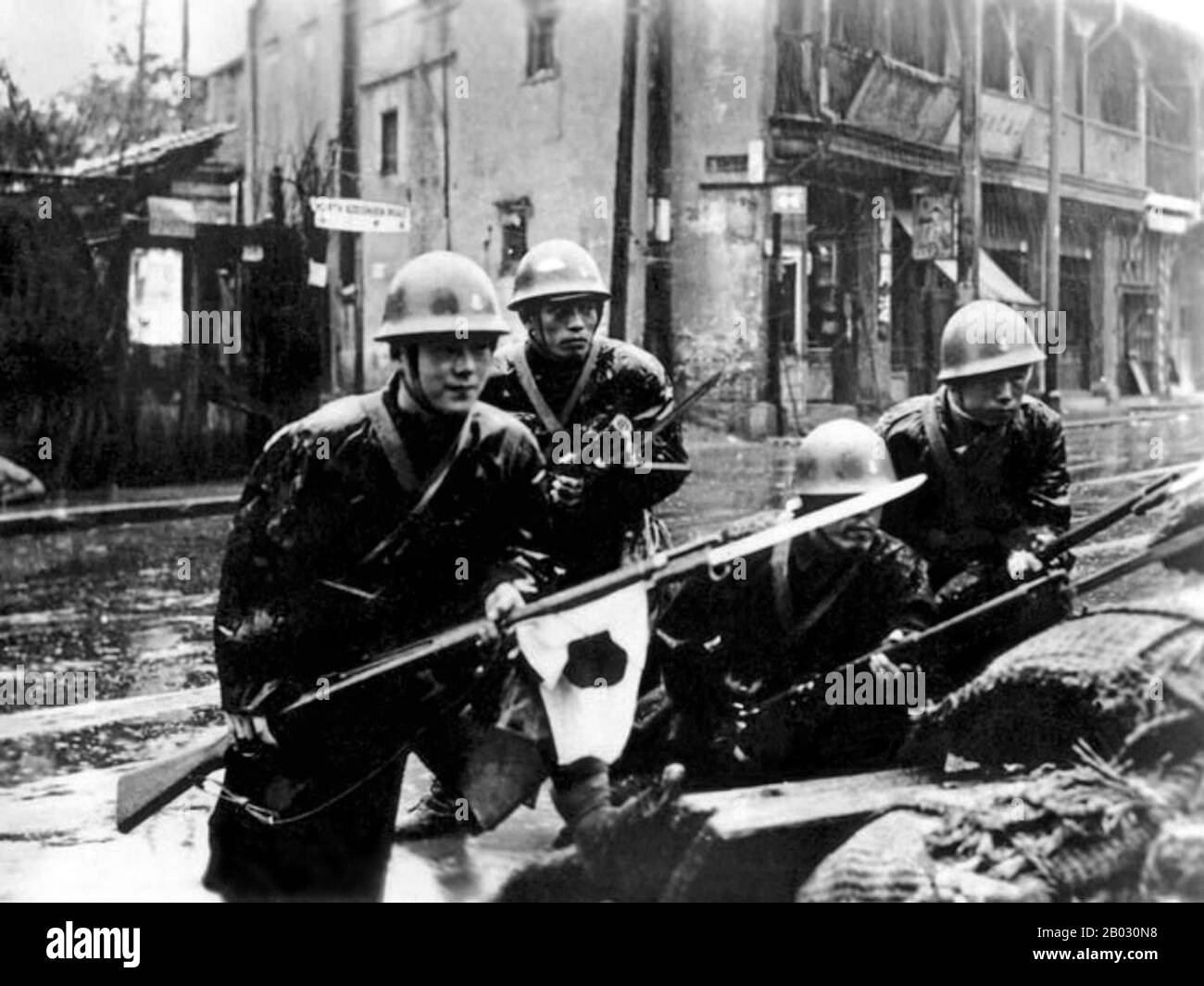 The Second Sino-Japanese War (July 7, 1937 – September 9, 1945) was a military conflict fought primarily between the Republic of China and the Empire of Japan. After the Japanese attack on Pearl Harbor, the war merged into the greater conflict of World War II as a major front of what is broadly known as the Pacific War. Although the two countries had fought intermittently since 1931, total war started in earnest in 1937 and ended only with the surrender of Japan in 1945. The war was the result of a decades-long Japanese imperialist policy aiming to dominate China politically and militarily an Stock Photohttps://www.alamy.com/image-license-details/?v=1https://www.alamy.com/the-second-sino-japanese-war-july-7-1937-september-9-1945-was-a-military-conflict-fought-primarily-between-the-republic-of-china-and-the-empire-of-japan-after-the-japanese-attack-on-pearl-harbor-the-war-merged-into-the-greater-conflict-of-world-war-ii-as-a-major-front-of-what-is-broadly-known-as-the-pacific-war-although-the-two-countries-had-fought-intermittently-since-1931-total-war-started-in-earnest-in-1937-and-ended-only-with-the-surrender-of-japan-in-1945-the-war-was-the-result-of-a-decades-long-japanese-imperialist-policy-aiming-to-dominate-china-politically-and-militarily-an-image344273812.html
The Second Sino-Japanese War (July 7, 1937 – September 9, 1945) was a military conflict fought primarily between the Republic of China and the Empire of Japan. After the Japanese attack on Pearl Harbor, the war merged into the greater conflict of World War II as a major front of what is broadly known as the Pacific War. Although the two countries had fought intermittently since 1931, total war started in earnest in 1937 and ended only with the surrender of Japan in 1945. The war was the result of a decades-long Japanese imperialist policy aiming to dominate China politically and militarily an Stock Photohttps://www.alamy.com/image-license-details/?v=1https://www.alamy.com/the-second-sino-japanese-war-july-7-1937-september-9-1945-was-a-military-conflict-fought-primarily-between-the-republic-of-china-and-the-empire-of-japan-after-the-japanese-attack-on-pearl-harbor-the-war-merged-into-the-greater-conflict-of-world-war-ii-as-a-major-front-of-what-is-broadly-known-as-the-pacific-war-although-the-two-countries-had-fought-intermittently-since-1931-total-war-started-in-earnest-in-1937-and-ended-only-with-the-surrender-of-japan-in-1945-the-war-was-the-result-of-a-decades-long-japanese-imperialist-policy-aiming-to-dominate-china-politically-and-militarily-an-image344273812.htmlRM2B030N8–The Second Sino-Japanese War (July 7, 1937 – September 9, 1945) was a military conflict fought primarily between the Republic of China and the Empire of Japan. After the Japanese attack on Pearl Harbor, the war merged into the greater conflict of World War II as a major front of what is broadly known as the Pacific War. Although the two countries had fought intermittently since 1931, total war started in earnest in 1937 and ended only with the surrender of Japan in 1945. The war was the result of a decades-long Japanese imperialist policy aiming to dominate China politically and militarily an
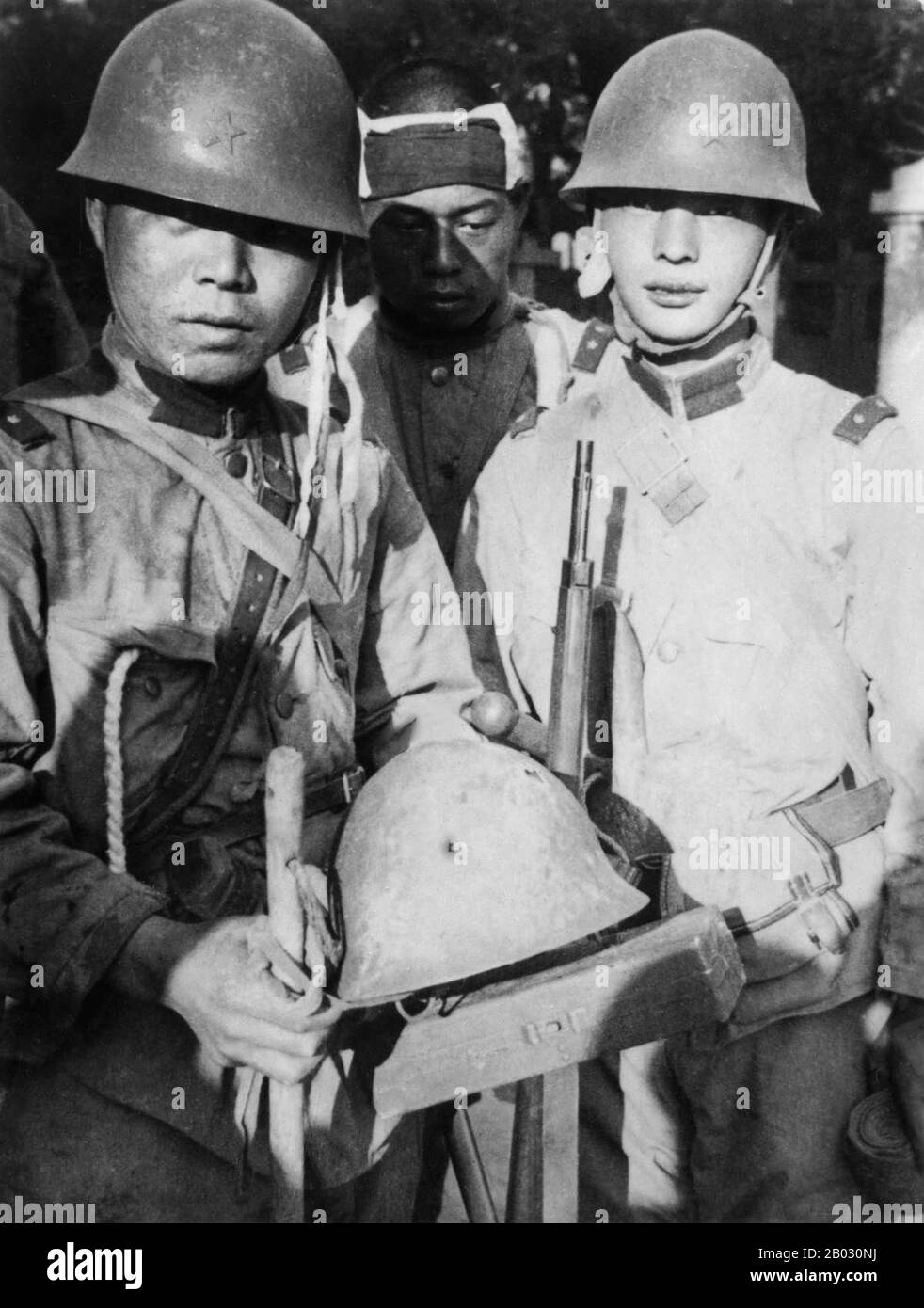 The Second Sino-Japanese War (July 7, 1937 – September 9, 1945) was a military conflict fought primarily between the Republic of China and the Empire of Japan. After the Japanese attack on Pearl Harbor, the war merged into the greater conflict of World War II as a major front of what is broadly known as the Pacific War. Although the two countries had fought intermittently since 1931, total war started in earnest in 1937 and ended only with the surrender of Japan in 1945. The war was the result of a decades-long Japanese imperialist policy aiming to dominate China politically and militarily an Stock Photohttps://www.alamy.com/image-license-details/?v=1https://www.alamy.com/the-second-sino-japanese-war-july-7-1937-september-9-1945-was-a-military-conflict-fought-primarily-between-the-republic-of-china-and-the-empire-of-japan-after-the-japanese-attack-on-pearl-harbor-the-war-merged-into-the-greater-conflict-of-world-war-ii-as-a-major-front-of-what-is-broadly-known-as-the-pacific-war-although-the-two-countries-had-fought-intermittently-since-1931-total-war-started-in-earnest-in-1937-and-ended-only-with-the-surrender-of-japan-in-1945-the-war-was-the-result-of-a-decades-long-japanese-imperialist-policy-aiming-to-dominate-china-politically-and-militarily-an-image344273822.html
The Second Sino-Japanese War (July 7, 1937 – September 9, 1945) was a military conflict fought primarily between the Republic of China and the Empire of Japan. After the Japanese attack on Pearl Harbor, the war merged into the greater conflict of World War II as a major front of what is broadly known as the Pacific War. Although the two countries had fought intermittently since 1931, total war started in earnest in 1937 and ended only with the surrender of Japan in 1945. The war was the result of a decades-long Japanese imperialist policy aiming to dominate China politically and militarily an Stock Photohttps://www.alamy.com/image-license-details/?v=1https://www.alamy.com/the-second-sino-japanese-war-july-7-1937-september-9-1945-was-a-military-conflict-fought-primarily-between-the-republic-of-china-and-the-empire-of-japan-after-the-japanese-attack-on-pearl-harbor-the-war-merged-into-the-greater-conflict-of-world-war-ii-as-a-major-front-of-what-is-broadly-known-as-the-pacific-war-although-the-two-countries-had-fought-intermittently-since-1931-total-war-started-in-earnest-in-1937-and-ended-only-with-the-surrender-of-japan-in-1945-the-war-was-the-result-of-a-decades-long-japanese-imperialist-policy-aiming-to-dominate-china-politically-and-militarily-an-image344273822.htmlRM2B030NJ–The Second Sino-Japanese War (July 7, 1937 – September 9, 1945) was a military conflict fought primarily between the Republic of China and the Empire of Japan. After the Japanese attack on Pearl Harbor, the war merged into the greater conflict of World War II as a major front of what is broadly known as the Pacific War. Although the two countries had fought intermittently since 1931, total war started in earnest in 1937 and ended only with the surrender of Japan in 1945. The war was the result of a decades-long Japanese imperialist policy aiming to dominate China politically and militarily an
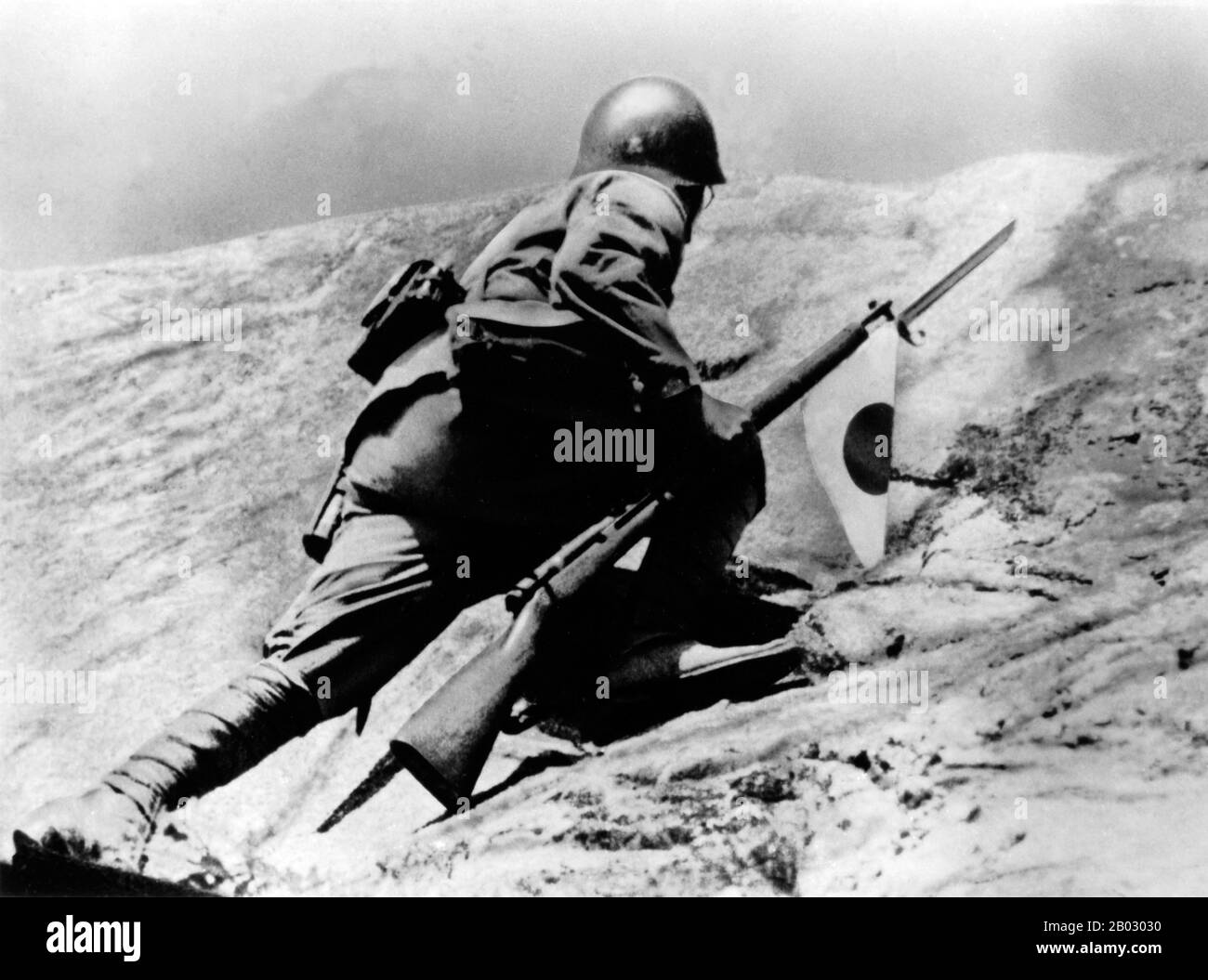 The Second Sino-Japanese War (July 7, 1937 – September 9, 1945) was a military conflict fought primarily between the Republic of China and the Empire of Japan. After the Japanese attack on Pearl Harbor, the war merged into the greater conflict of World War II as a major front of what is broadly known as the Pacific War. Although the two countries had fought intermittently since 1931, total war started in earnest in 1937 and ended only with the surrender of Japan in 1945. The war was the result of a decades-long Japanese imperialist policy aiming to dominate China politically and militarily an Stock Photohttps://www.alamy.com/image-license-details/?v=1https://www.alamy.com/the-second-sino-japanese-war-july-7-1937-september-9-1945-was-a-military-conflict-fought-primarily-between-the-republic-of-china-and-the-empire-of-japan-after-the-japanese-attack-on-pearl-harbor-the-war-merged-into-the-greater-conflict-of-world-war-ii-as-a-major-front-of-what-is-broadly-known-as-the-pacific-war-although-the-two-countries-had-fought-intermittently-since-1931-total-war-started-in-earnest-in-1937-and-ended-only-with-the-surrender-of-japan-in-1945-the-war-was-the-result-of-a-decades-long-japanese-imperialist-policy-aiming-to-dominate-china-politically-and-militarily-an-image344273300.html
The Second Sino-Japanese War (July 7, 1937 – September 9, 1945) was a military conflict fought primarily between the Republic of China and the Empire of Japan. After the Japanese attack on Pearl Harbor, the war merged into the greater conflict of World War II as a major front of what is broadly known as the Pacific War. Although the two countries had fought intermittently since 1931, total war started in earnest in 1937 and ended only with the surrender of Japan in 1945. The war was the result of a decades-long Japanese imperialist policy aiming to dominate China politically and militarily an Stock Photohttps://www.alamy.com/image-license-details/?v=1https://www.alamy.com/the-second-sino-japanese-war-july-7-1937-september-9-1945-was-a-military-conflict-fought-primarily-between-the-republic-of-china-and-the-empire-of-japan-after-the-japanese-attack-on-pearl-harbor-the-war-merged-into-the-greater-conflict-of-world-war-ii-as-a-major-front-of-what-is-broadly-known-as-the-pacific-war-although-the-two-countries-had-fought-intermittently-since-1931-total-war-started-in-earnest-in-1937-and-ended-only-with-the-surrender-of-japan-in-1945-the-war-was-the-result-of-a-decades-long-japanese-imperialist-policy-aiming-to-dominate-china-politically-and-militarily-an-image344273300.htmlRM2B03030–The Second Sino-Japanese War (July 7, 1937 – September 9, 1945) was a military conflict fought primarily between the Republic of China and the Empire of Japan. After the Japanese attack on Pearl Harbor, the war merged into the greater conflict of World War II as a major front of what is broadly known as the Pacific War. Although the two countries had fought intermittently since 1931, total war started in earnest in 1937 and ended only with the surrender of Japan in 1945. The war was the result of a decades-long Japanese imperialist policy aiming to dominate China politically and militarily an
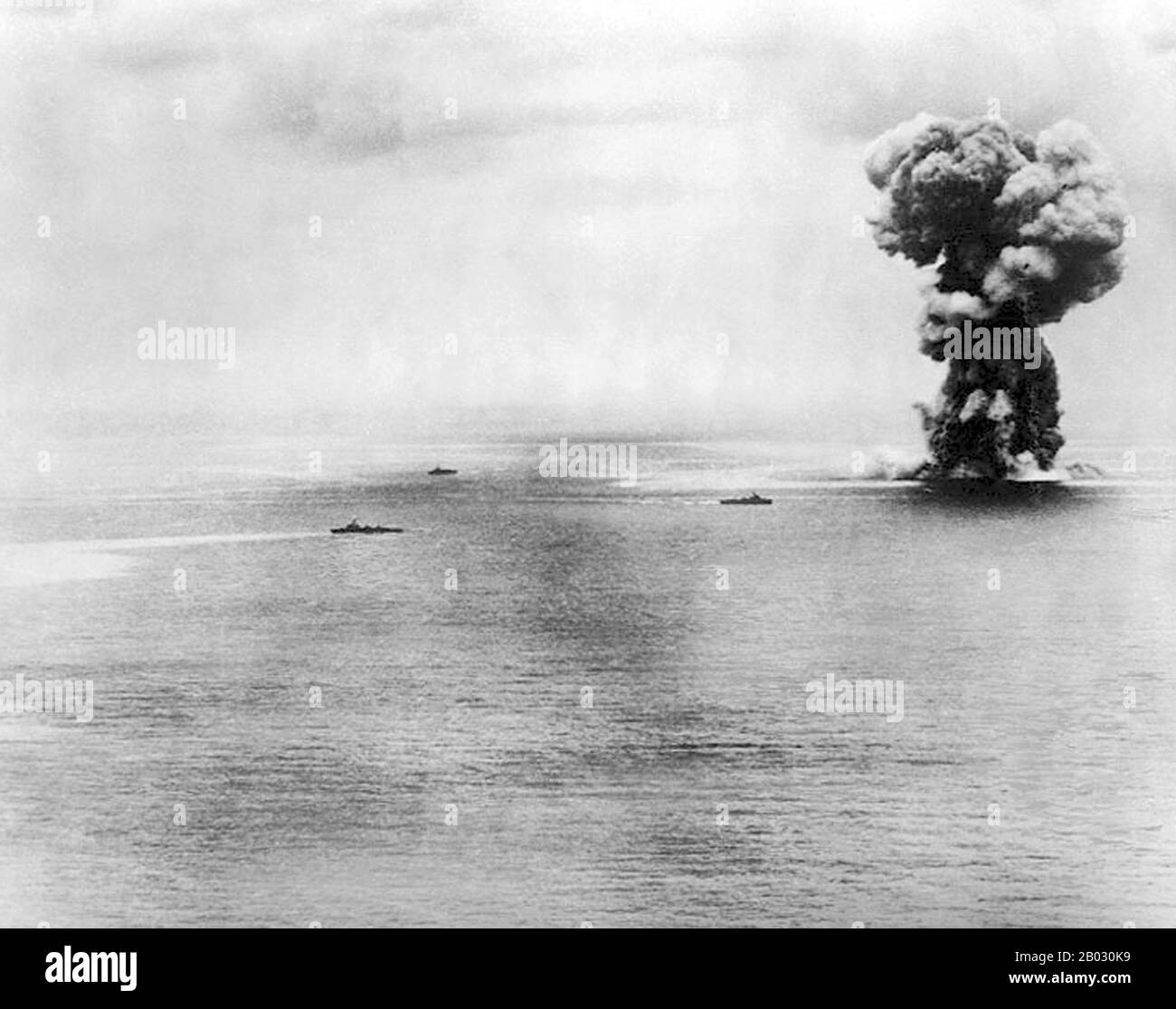 The Yamato, named after the ancient Japanese Yamato Province, was the lead ship of the Yamato class of battleships that served with the Imperial Japanese Navy during World War II. She and her sister ship, Musashi, were the heaviest and most powerfully armed battleships ever constructed, displacing 72,800 tonnes at full load and armed with nine 46 cm (18.1 inch) main guns. Neither ship survived the war. Laid down in 1937 and formally commissioned a week after the Pearl Harbor attack in late 1941, Yamato was designed to counter the numerically superior battleship fleet of the United States, Jap Stock Photohttps://www.alamy.com/image-license-details/?v=1https://www.alamy.com/the-yamato-named-after-the-ancient-japanese-yamato-province-was-the-lead-ship-of-the-yamato-class-of-battleships-that-served-with-the-imperial-japanese-navy-during-world-war-ii-she-and-her-sister-ship-musashi-were-the-heaviest-and-most-powerfully-armed-battleships-ever-constructed-displacing-72800-tonnes-at-full-load-and-armed-with-nine-46-cm-181-inch-main-guns-neither-ship-survived-the-war-laid-down-in-1937-and-formally-commissioned-a-week-after-the-pearl-harbor-attack-in-late-1941-yamato-was-designed-to-counter-the-numerically-superior-battleship-fleet-of-the-united-states-jap-image344273757.html
The Yamato, named after the ancient Japanese Yamato Province, was the lead ship of the Yamato class of battleships that served with the Imperial Japanese Navy during World War II. She and her sister ship, Musashi, were the heaviest and most powerfully armed battleships ever constructed, displacing 72,800 tonnes at full load and armed with nine 46 cm (18.1 inch) main guns. Neither ship survived the war. Laid down in 1937 and formally commissioned a week after the Pearl Harbor attack in late 1941, Yamato was designed to counter the numerically superior battleship fleet of the United States, Jap Stock Photohttps://www.alamy.com/image-license-details/?v=1https://www.alamy.com/the-yamato-named-after-the-ancient-japanese-yamato-province-was-the-lead-ship-of-the-yamato-class-of-battleships-that-served-with-the-imperial-japanese-navy-during-world-war-ii-she-and-her-sister-ship-musashi-were-the-heaviest-and-most-powerfully-armed-battleships-ever-constructed-displacing-72800-tonnes-at-full-load-and-armed-with-nine-46-cm-181-inch-main-guns-neither-ship-survived-the-war-laid-down-in-1937-and-formally-commissioned-a-week-after-the-pearl-harbor-attack-in-late-1941-yamato-was-designed-to-counter-the-numerically-superior-battleship-fleet-of-the-united-states-jap-image344273757.htmlRM2B030K9–The Yamato, named after the ancient Japanese Yamato Province, was the lead ship of the Yamato class of battleships that served with the Imperial Japanese Navy during World War II. She and her sister ship, Musashi, were the heaviest and most powerfully armed battleships ever constructed, displacing 72,800 tonnes at full load and armed with nine 46 cm (18.1 inch) main guns. Neither ship survived the war. Laid down in 1937 and formally commissioned a week after the Pearl Harbor attack in late 1941, Yamato was designed to counter the numerically superior battleship fleet of the United States, Jap
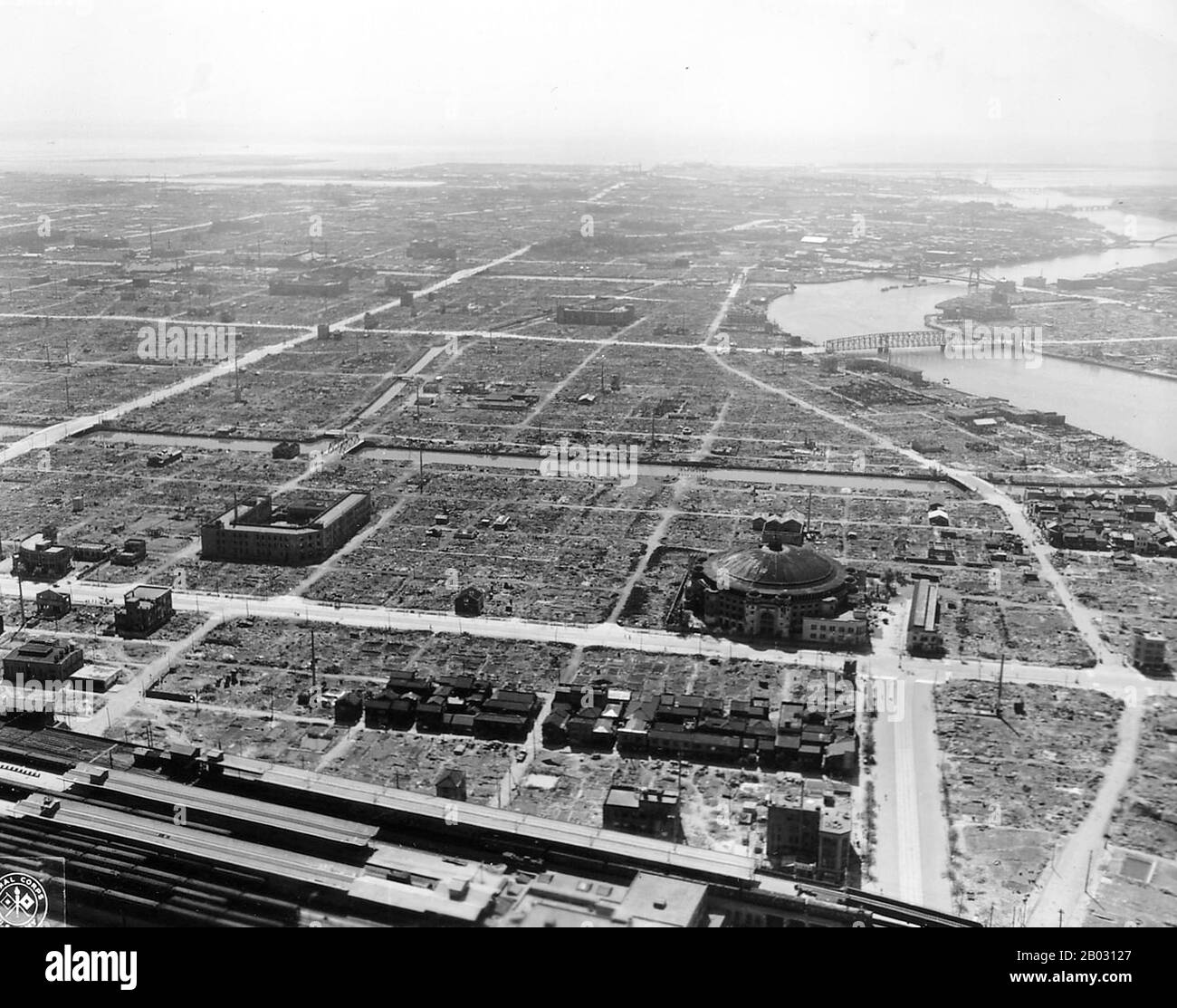 Allied forces conducted many air raids on Japan during World War II, causing extensive destruction to the country's cities and killing between 241,000 and 900,000 people. During the first years of the Pacific War, sparked by the Japanese attack on Pearl Harbor, these attacks were limited to the Doolittle Raid in April 1942 and small-scale raids on military positions in the Kuril Islands from mid-1943. Strategic bombing raids began in June 1944 and continued until the end of the war in August 1945. Allied naval and land-based tactical air units also attacked Japan during 1945. Stock Photohttps://www.alamy.com/image-license-details/?v=1https://www.alamy.com/allied-forces-conducted-many-air-raids-on-japan-during-world-war-ii-causing-extensive-destruction-to-the-countrys-cities-and-killing-between-241000-and-900000-people-during-the-first-years-of-the-pacific-war-sparked-by-the-japanese-attack-on-pearl-harbor-these-attacks-were-limited-to-the-doolittle-raid-in-april-1942-and-small-scale-raids-on-military-positions-in-the-kuril-islands-from-mid-1943-strategic-bombing-raids-began-in-june-1944-and-continued-until-the-end-of-the-war-in-august-1945-allied-naval-and-land-based-tactical-air-units-also-attacked-japan-during-1945-image344274063.html
Allied forces conducted many air raids on Japan during World War II, causing extensive destruction to the country's cities and killing between 241,000 and 900,000 people. During the first years of the Pacific War, sparked by the Japanese attack on Pearl Harbor, these attacks were limited to the Doolittle Raid in April 1942 and small-scale raids on military positions in the Kuril Islands from mid-1943. Strategic bombing raids began in June 1944 and continued until the end of the war in August 1945. Allied naval and land-based tactical air units also attacked Japan during 1945. Stock Photohttps://www.alamy.com/image-license-details/?v=1https://www.alamy.com/allied-forces-conducted-many-air-raids-on-japan-during-world-war-ii-causing-extensive-destruction-to-the-countrys-cities-and-killing-between-241000-and-900000-people-during-the-first-years-of-the-pacific-war-sparked-by-the-japanese-attack-on-pearl-harbor-these-attacks-were-limited-to-the-doolittle-raid-in-april-1942-and-small-scale-raids-on-military-positions-in-the-kuril-islands-from-mid-1943-strategic-bombing-raids-began-in-june-1944-and-continued-until-the-end-of-the-war-in-august-1945-allied-naval-and-land-based-tactical-air-units-also-attacked-japan-during-1945-image344274063.htmlRM2B03127–Allied forces conducted many air raids on Japan during World War II, causing extensive destruction to the country's cities and killing between 241,000 and 900,000 people. During the first years of the Pacific War, sparked by the Japanese attack on Pearl Harbor, these attacks were limited to the Doolittle Raid in April 1942 and small-scale raids on military positions in the Kuril Islands from mid-1943. Strategic bombing raids began in June 1944 and continued until the end of the war in August 1945. Allied naval and land-based tactical air units also attacked Japan during 1945.
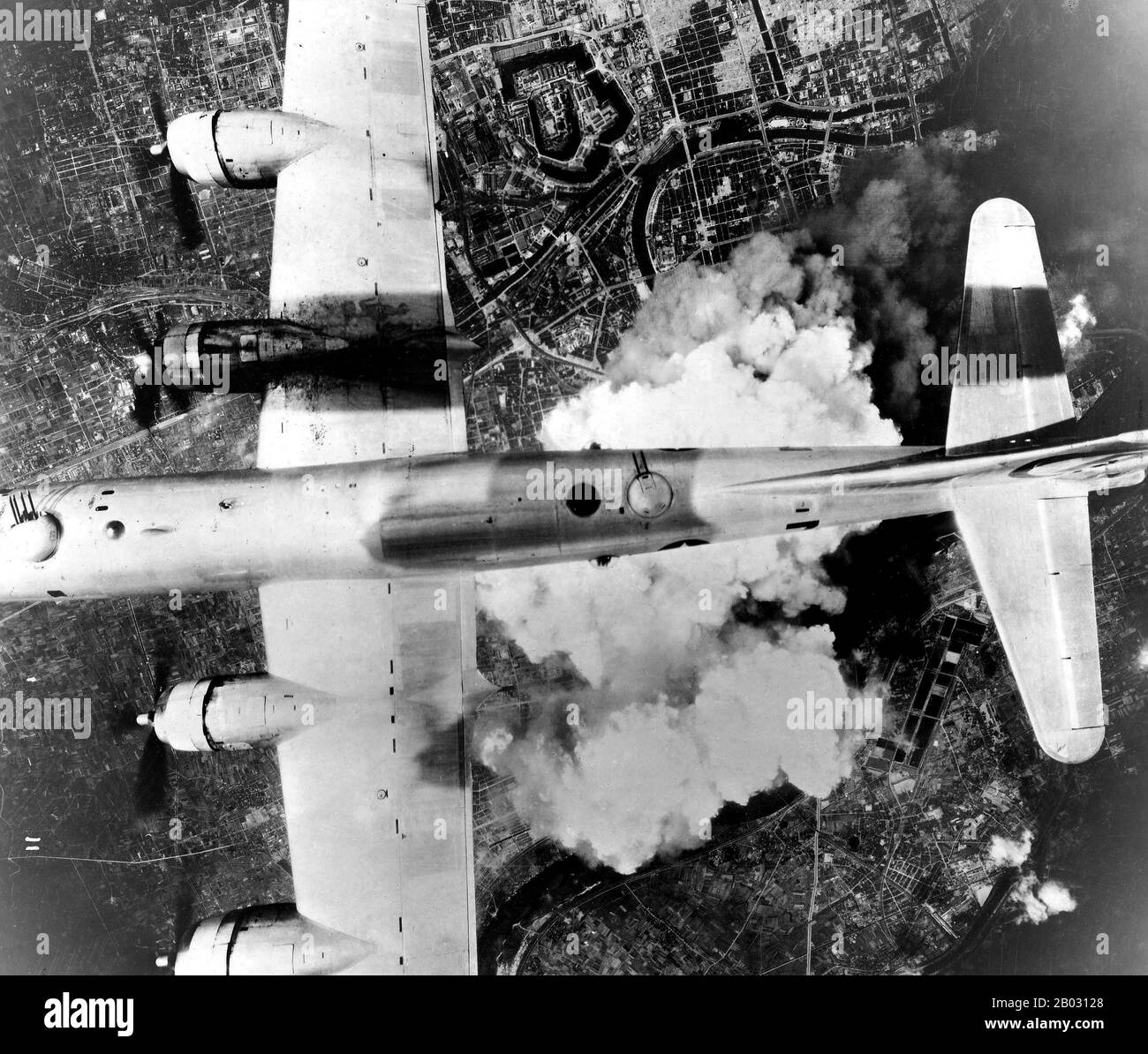 Allied forces conducted many air raids on Japan during World War II, causing extensive destruction to the country's cities and killing between 241,000 and 900,000 people. During the first years of the Pacific War, sparked by the Japanese attack on Pearl Harbor, these attacks were limited to the Doolittle Raid in April 1942 and small-scale raids on military positions in the Kuril Islands from mid-1943. Strategic bombing raids began in June 1944 and continued until the end of the war in August 1945. Allied naval and land-based tactical air units also attacked Japan during 1945. Stock Photohttps://www.alamy.com/image-license-details/?v=1https://www.alamy.com/allied-forces-conducted-many-air-raids-on-japan-during-world-war-ii-causing-extensive-destruction-to-the-countrys-cities-and-killing-between-241000-and-900000-people-during-the-first-years-of-the-pacific-war-sparked-by-the-japanese-attack-on-pearl-harbor-these-attacks-were-limited-to-the-doolittle-raid-in-april-1942-and-small-scale-raids-on-military-positions-in-the-kuril-islands-from-mid-1943-strategic-bombing-raids-began-in-june-1944-and-continued-until-the-end-of-the-war-in-august-1945-allied-naval-and-land-based-tactical-air-units-also-attacked-japan-during-1945-image344274064.html
Allied forces conducted many air raids on Japan during World War II, causing extensive destruction to the country's cities and killing between 241,000 and 900,000 people. During the first years of the Pacific War, sparked by the Japanese attack on Pearl Harbor, these attacks were limited to the Doolittle Raid in April 1942 and small-scale raids on military positions in the Kuril Islands from mid-1943. Strategic bombing raids began in June 1944 and continued until the end of the war in August 1945. Allied naval and land-based tactical air units also attacked Japan during 1945. Stock Photohttps://www.alamy.com/image-license-details/?v=1https://www.alamy.com/allied-forces-conducted-many-air-raids-on-japan-during-world-war-ii-causing-extensive-destruction-to-the-countrys-cities-and-killing-between-241000-and-900000-people-during-the-first-years-of-the-pacific-war-sparked-by-the-japanese-attack-on-pearl-harbor-these-attacks-were-limited-to-the-doolittle-raid-in-april-1942-and-small-scale-raids-on-military-positions-in-the-kuril-islands-from-mid-1943-strategic-bombing-raids-began-in-june-1944-and-continued-until-the-end-of-the-war-in-august-1945-allied-naval-and-land-based-tactical-air-units-also-attacked-japan-during-1945-image344274064.htmlRM2B03128–Allied forces conducted many air raids on Japan during World War II, causing extensive destruction to the country's cities and killing between 241,000 and 900,000 people. During the first years of the Pacific War, sparked by the Japanese attack on Pearl Harbor, these attacks were limited to the Doolittle Raid in April 1942 and small-scale raids on military positions in the Kuril Islands from mid-1943. Strategic bombing raids began in June 1944 and continued until the end of the war in August 1945. Allied naval and land-based tactical air units also attacked Japan during 1945.
 Allied forces conducted many air raids on Japan during World War II, causing extensive destruction to the country's cities and killing between 241,000 and 900,000 people. During the first years of the Pacific War, sparked by the Japanese attack on Pearl Harbor, these attacks were limited to the Doolittle Raid in April 1942 and small-scale raids on military positions in the Kuril Islands from mid-1943. Strategic bombing raids began in June 1944 and continued until the end of the war in August 1945. Allied naval and land-based tactical air units also attacked Japan during 1945. Stock Photohttps://www.alamy.com/image-license-details/?v=1https://www.alamy.com/allied-forces-conducted-many-air-raids-on-japan-during-world-war-ii-causing-extensive-destruction-to-the-countrys-cities-and-killing-between-241000-and-900000-people-during-the-first-years-of-the-pacific-war-sparked-by-the-japanese-attack-on-pearl-harbor-these-attacks-were-limited-to-the-doolittle-raid-in-april-1942-and-small-scale-raids-on-military-positions-in-the-kuril-islands-from-mid-1943-strategic-bombing-raids-began-in-june-1944-and-continued-until-the-end-of-the-war-in-august-1945-allied-naval-and-land-based-tactical-air-units-also-attacked-japan-during-1945-image344274065.html
Allied forces conducted many air raids on Japan during World War II, causing extensive destruction to the country's cities and killing between 241,000 and 900,000 people. During the first years of the Pacific War, sparked by the Japanese attack on Pearl Harbor, these attacks were limited to the Doolittle Raid in April 1942 and small-scale raids on military positions in the Kuril Islands from mid-1943. Strategic bombing raids began in June 1944 and continued until the end of the war in August 1945. Allied naval and land-based tactical air units also attacked Japan during 1945. Stock Photohttps://www.alamy.com/image-license-details/?v=1https://www.alamy.com/allied-forces-conducted-many-air-raids-on-japan-during-world-war-ii-causing-extensive-destruction-to-the-countrys-cities-and-killing-between-241000-and-900000-people-during-the-first-years-of-the-pacific-war-sparked-by-the-japanese-attack-on-pearl-harbor-these-attacks-were-limited-to-the-doolittle-raid-in-april-1942-and-small-scale-raids-on-military-positions-in-the-kuril-islands-from-mid-1943-strategic-bombing-raids-began-in-june-1944-and-continued-until-the-end-of-the-war-in-august-1945-allied-naval-and-land-based-tactical-air-units-also-attacked-japan-during-1945-image344274065.htmlRM2B03129–Allied forces conducted many air raids on Japan during World War II, causing extensive destruction to the country's cities and killing between 241,000 and 900,000 people. During the first years of the Pacific War, sparked by the Japanese attack on Pearl Harbor, these attacks were limited to the Doolittle Raid in April 1942 and small-scale raids on military positions in the Kuril Islands from mid-1943. Strategic bombing raids began in June 1944 and continued until the end of the war in August 1945. Allied naval and land-based tactical air units also attacked Japan during 1945.
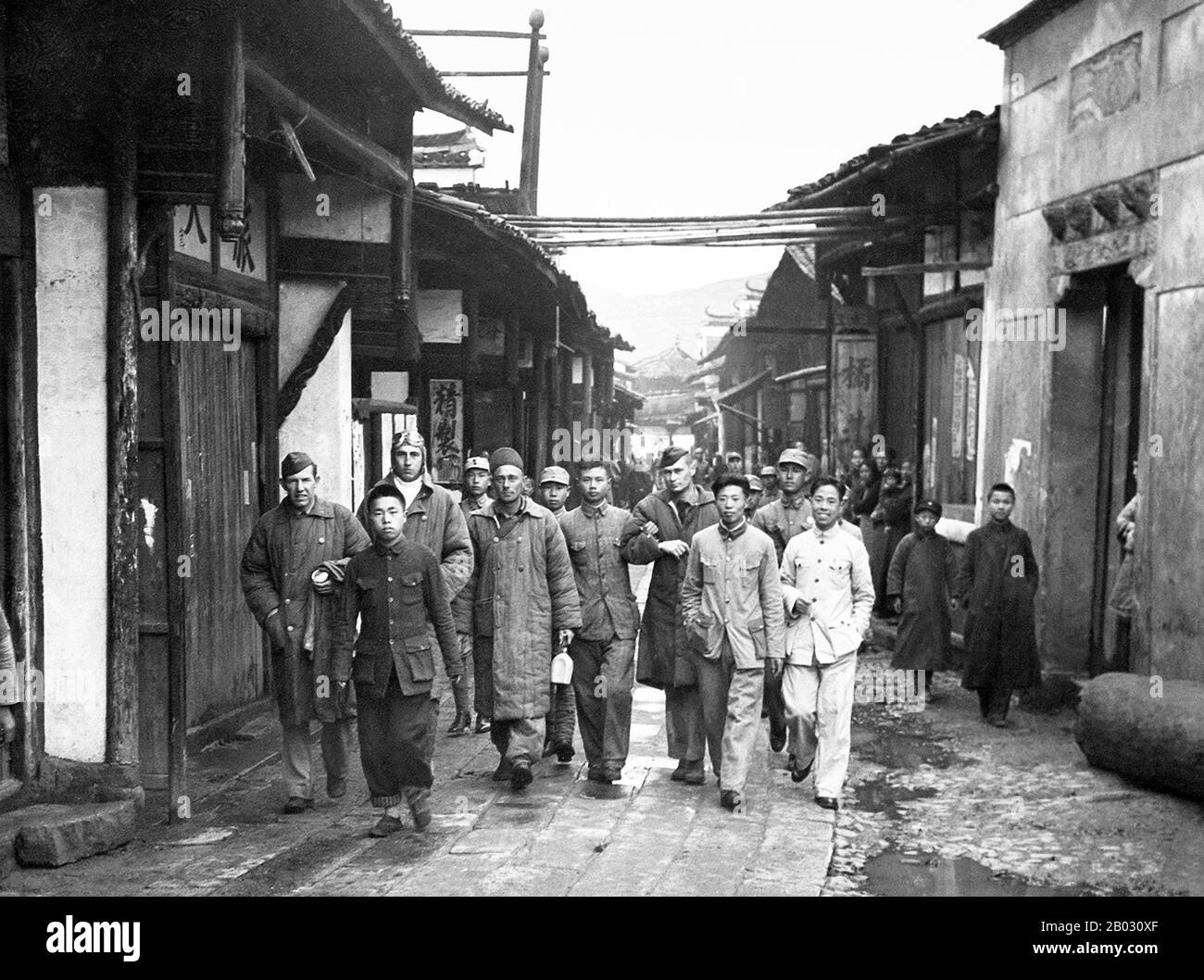 The Doolittle Raid, also known as the Tokyo Raid, on 18 April 1942, was an air raid by the United States on the Japanese capital Tokyo and other places on Honshu island during World War II, the first air raid to strike the Japanese Home Islands. It demonstrated that Japan itself was vulnerable to American air attack, served as retaliation for the Japanese attack on Pearl Harbor on 7 December 1941, and provided an important boost to U.S. morale while damaging Japanese morale. The raid was planned and led by Lieutenant Colonel James Doolittle. Sixteen U.S. Army Air Forces B-25B Mitchell medium Stock Photohttps://www.alamy.com/image-license-details/?v=1https://www.alamy.com/the-doolittle-raid-also-known-as-the-tokyo-raid-on-18-april-1942-was-an-air-raid-by-the-united-states-on-the-japanese-capital-tokyo-and-other-places-on-honshu-island-during-world-war-ii-the-first-air-raid-to-strike-the-japanese-home-islands-it-demonstrated-that-japan-itself-was-vulnerable-to-american-air-attack-served-as-retaliation-for-the-japanese-attack-on-pearl-harbor-on-7-december-1941-and-provided-an-important-boost-to-us-morale-while-damaging-japanese-morale-the-raid-was-planned-and-led-by-lieutenant-colonel-james-doolittle-sixteen-us-army-air-forces-b-25b-mitchell-medium-image344273959.html
The Doolittle Raid, also known as the Tokyo Raid, on 18 April 1942, was an air raid by the United States on the Japanese capital Tokyo and other places on Honshu island during World War II, the first air raid to strike the Japanese Home Islands. It demonstrated that Japan itself was vulnerable to American air attack, served as retaliation for the Japanese attack on Pearl Harbor on 7 December 1941, and provided an important boost to U.S. morale while damaging Japanese morale. The raid was planned and led by Lieutenant Colonel James Doolittle. Sixteen U.S. Army Air Forces B-25B Mitchell medium Stock Photohttps://www.alamy.com/image-license-details/?v=1https://www.alamy.com/the-doolittle-raid-also-known-as-the-tokyo-raid-on-18-april-1942-was-an-air-raid-by-the-united-states-on-the-japanese-capital-tokyo-and-other-places-on-honshu-island-during-world-war-ii-the-first-air-raid-to-strike-the-japanese-home-islands-it-demonstrated-that-japan-itself-was-vulnerable-to-american-air-attack-served-as-retaliation-for-the-japanese-attack-on-pearl-harbor-on-7-december-1941-and-provided-an-important-boost-to-us-morale-while-damaging-japanese-morale-the-raid-was-planned-and-led-by-lieutenant-colonel-james-doolittle-sixteen-us-army-air-forces-b-25b-mitchell-medium-image344273959.htmlRM2B030XF–The Doolittle Raid, also known as the Tokyo Raid, on 18 April 1942, was an air raid by the United States on the Japanese capital Tokyo and other places on Honshu island during World War II, the first air raid to strike the Japanese Home Islands. It demonstrated that Japan itself was vulnerable to American air attack, served as retaliation for the Japanese attack on Pearl Harbor on 7 December 1941, and provided an important boost to U.S. morale while damaging Japanese morale. The raid was planned and led by Lieutenant Colonel James Doolittle. Sixteen U.S. Army Air Forces B-25B Mitchell medium
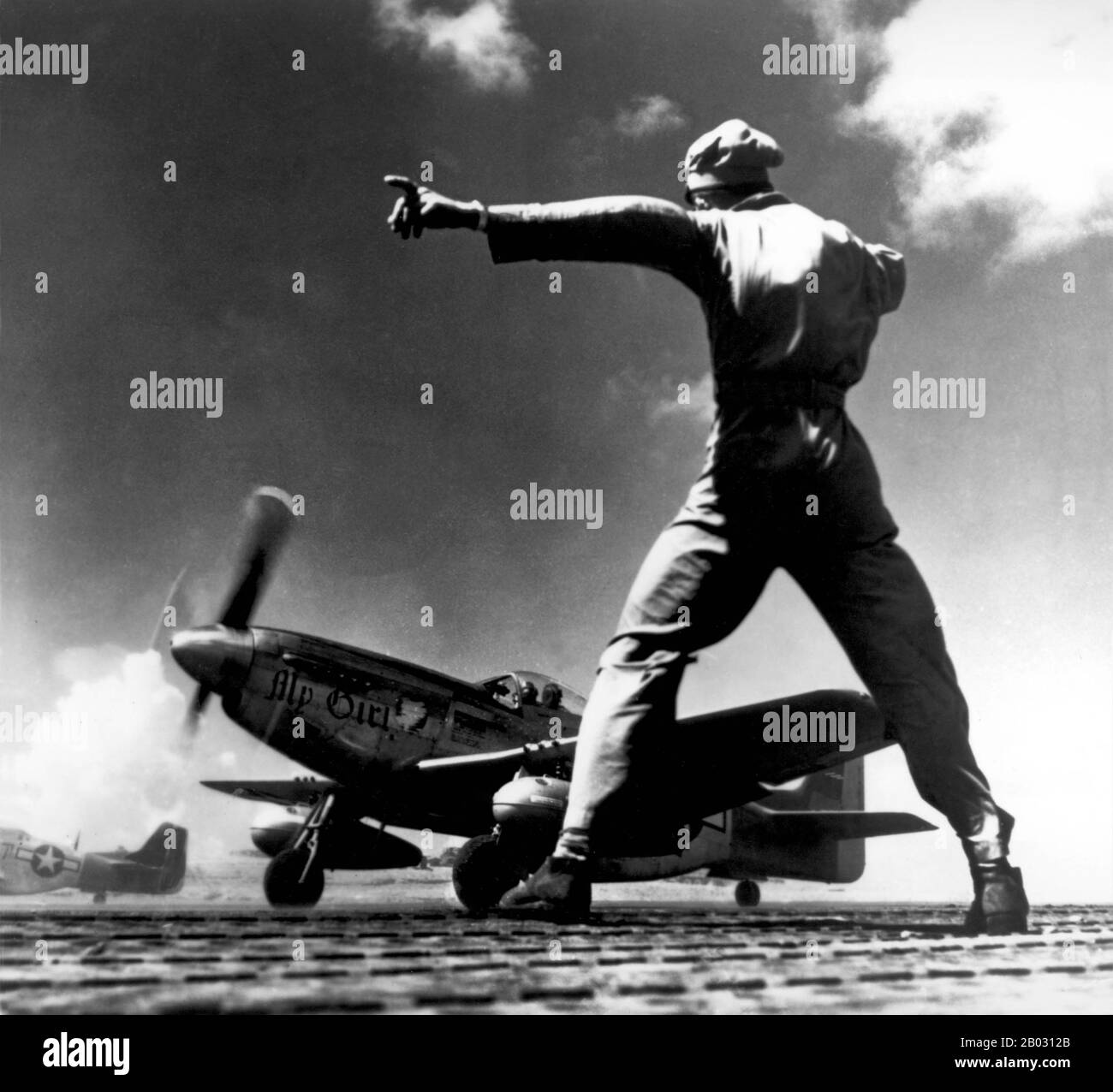 Allied forces conducted many air raids on Japan during World War II, causing extensive destruction to the country's cities and killing between 241,000 and 900,000 people. During the first years of the Pacific War, sparked by the Japanese attack on Pearl Harbor, these attacks were limited to the Doolittle Raid in April 1942 and small-scale raids on military positions in the Kuril Islands from mid-1943. Strategic bombing raids began in June 1944 and continued until the end of the war in August 1945. Allied naval and land-based tactical air units also attacked Japan during 1945. Stock Photohttps://www.alamy.com/image-license-details/?v=1https://www.alamy.com/allied-forces-conducted-many-air-raids-on-japan-during-world-war-ii-causing-extensive-destruction-to-the-countrys-cities-and-killing-between-241000-and-900000-people-during-the-first-years-of-the-pacific-war-sparked-by-the-japanese-attack-on-pearl-harbor-these-attacks-were-limited-to-the-doolittle-raid-in-april-1942-and-small-scale-raids-on-military-positions-in-the-kuril-islands-from-mid-1943-strategic-bombing-raids-began-in-june-1944-and-continued-until-the-end-of-the-war-in-august-1945-allied-naval-and-land-based-tactical-air-units-also-attacked-japan-during-1945-image344274067.html
Allied forces conducted many air raids on Japan during World War II, causing extensive destruction to the country's cities and killing between 241,000 and 900,000 people. During the first years of the Pacific War, sparked by the Japanese attack on Pearl Harbor, these attacks were limited to the Doolittle Raid in April 1942 and small-scale raids on military positions in the Kuril Islands from mid-1943. Strategic bombing raids began in June 1944 and continued until the end of the war in August 1945. Allied naval and land-based tactical air units also attacked Japan during 1945. Stock Photohttps://www.alamy.com/image-license-details/?v=1https://www.alamy.com/allied-forces-conducted-many-air-raids-on-japan-during-world-war-ii-causing-extensive-destruction-to-the-countrys-cities-and-killing-between-241000-and-900000-people-during-the-first-years-of-the-pacific-war-sparked-by-the-japanese-attack-on-pearl-harbor-these-attacks-were-limited-to-the-doolittle-raid-in-april-1942-and-small-scale-raids-on-military-positions-in-the-kuril-islands-from-mid-1943-strategic-bombing-raids-began-in-june-1944-and-continued-until-the-end-of-the-war-in-august-1945-allied-naval-and-land-based-tactical-air-units-also-attacked-japan-during-1945-image344274067.htmlRM2B0312B–Allied forces conducted many air raids on Japan during World War II, causing extensive destruction to the country's cities and killing between 241,000 and 900,000 people. During the first years of the Pacific War, sparked by the Japanese attack on Pearl Harbor, these attacks were limited to the Doolittle Raid in April 1942 and small-scale raids on military positions in the Kuril Islands from mid-1943. Strategic bombing raids began in June 1944 and continued until the end of the war in August 1945. Allied naval and land-based tactical air units also attacked Japan during 1945.
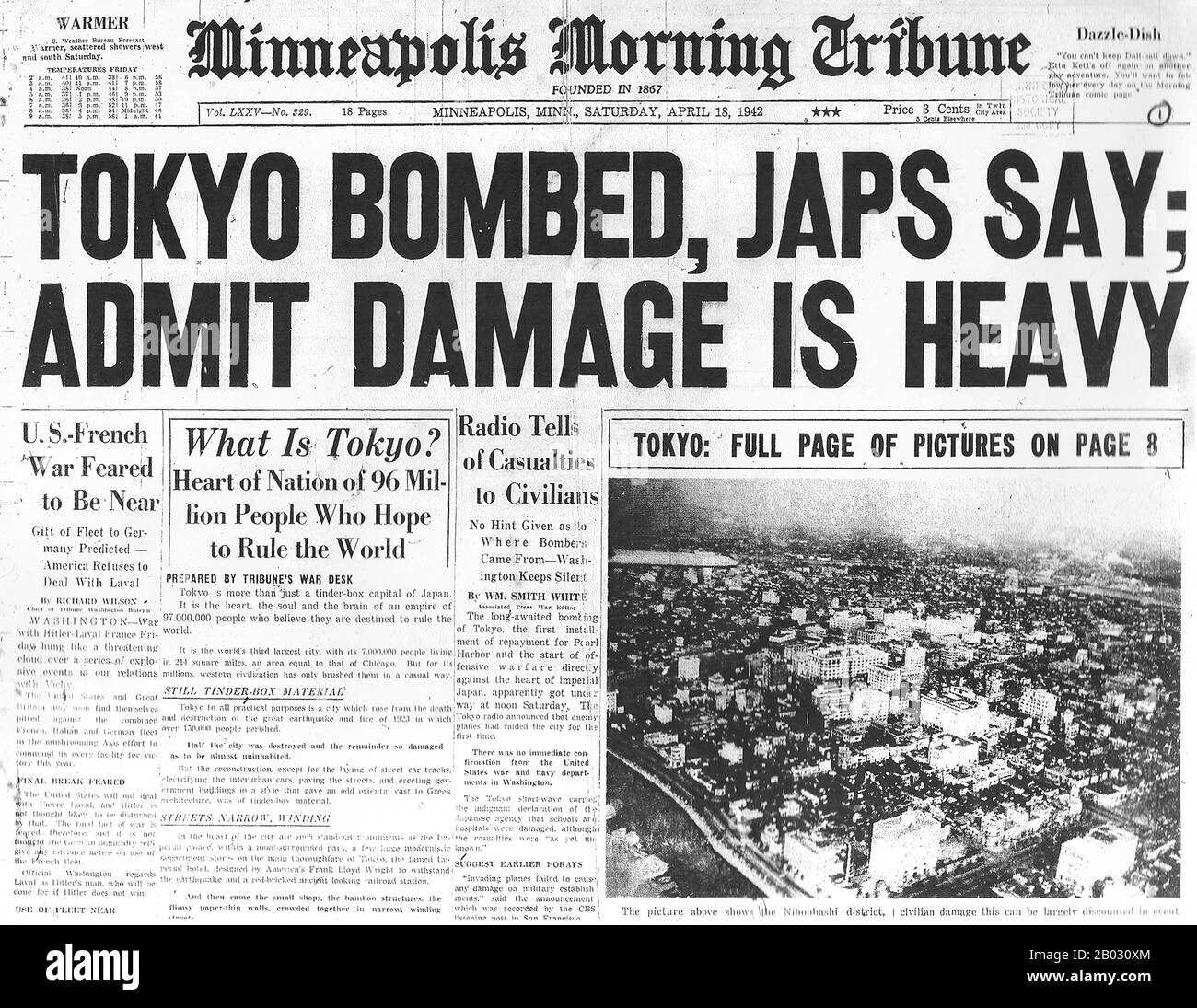 The Doolittle Raid, also known as the Tokyo Raid, on 18 April 1942, was an air raid by the United States on the Japanese capital Tokyo and other places on Honshu island during World War II, the first air raid to strike the Japanese Home Islands. It demonstrated that Japan itself was vulnerable to American air attack, served as retaliation for the Japanese attack on Pearl Harbor on 7 December 1941, and provided an important boost to U.S. morale while damaging Japanese morale. The raid was planned and led by Lieutenant Colonel James Doolittle. Sixteen U.S. Army Air Forces B-25B Mitchell medium Stock Photohttps://www.alamy.com/image-license-details/?v=1https://www.alamy.com/the-doolittle-raid-also-known-as-the-tokyo-raid-on-18-april-1942-was-an-air-raid-by-the-united-states-on-the-japanese-capital-tokyo-and-other-places-on-honshu-island-during-world-war-ii-the-first-air-raid-to-strike-the-japanese-home-islands-it-demonstrated-that-japan-itself-was-vulnerable-to-american-air-attack-served-as-retaliation-for-the-japanese-attack-on-pearl-harbor-on-7-december-1941-and-provided-an-important-boost-to-us-morale-while-damaging-japanese-morale-the-raid-was-planned-and-led-by-lieutenant-colonel-james-doolittle-sixteen-us-army-air-forces-b-25b-mitchell-medium-image344273964.html
The Doolittle Raid, also known as the Tokyo Raid, on 18 April 1942, was an air raid by the United States on the Japanese capital Tokyo and other places on Honshu island during World War II, the first air raid to strike the Japanese Home Islands. It demonstrated that Japan itself was vulnerable to American air attack, served as retaliation for the Japanese attack on Pearl Harbor on 7 December 1941, and provided an important boost to U.S. morale while damaging Japanese morale. The raid was planned and led by Lieutenant Colonel James Doolittle. Sixteen U.S. Army Air Forces B-25B Mitchell medium Stock Photohttps://www.alamy.com/image-license-details/?v=1https://www.alamy.com/the-doolittle-raid-also-known-as-the-tokyo-raid-on-18-april-1942-was-an-air-raid-by-the-united-states-on-the-japanese-capital-tokyo-and-other-places-on-honshu-island-during-world-war-ii-the-first-air-raid-to-strike-the-japanese-home-islands-it-demonstrated-that-japan-itself-was-vulnerable-to-american-air-attack-served-as-retaliation-for-the-japanese-attack-on-pearl-harbor-on-7-december-1941-and-provided-an-important-boost-to-us-morale-while-damaging-japanese-morale-the-raid-was-planned-and-led-by-lieutenant-colonel-james-doolittle-sixteen-us-army-air-forces-b-25b-mitchell-medium-image344273964.htmlRM2B030XM–The Doolittle Raid, also known as the Tokyo Raid, on 18 April 1942, was an air raid by the United States on the Japanese capital Tokyo and other places on Honshu island during World War II, the first air raid to strike the Japanese Home Islands. It demonstrated that Japan itself was vulnerable to American air attack, served as retaliation for the Japanese attack on Pearl Harbor on 7 December 1941, and provided an important boost to U.S. morale while damaging Japanese morale. The raid was planned and led by Lieutenant Colonel James Doolittle. Sixteen U.S. Army Air Forces B-25B Mitchell medium
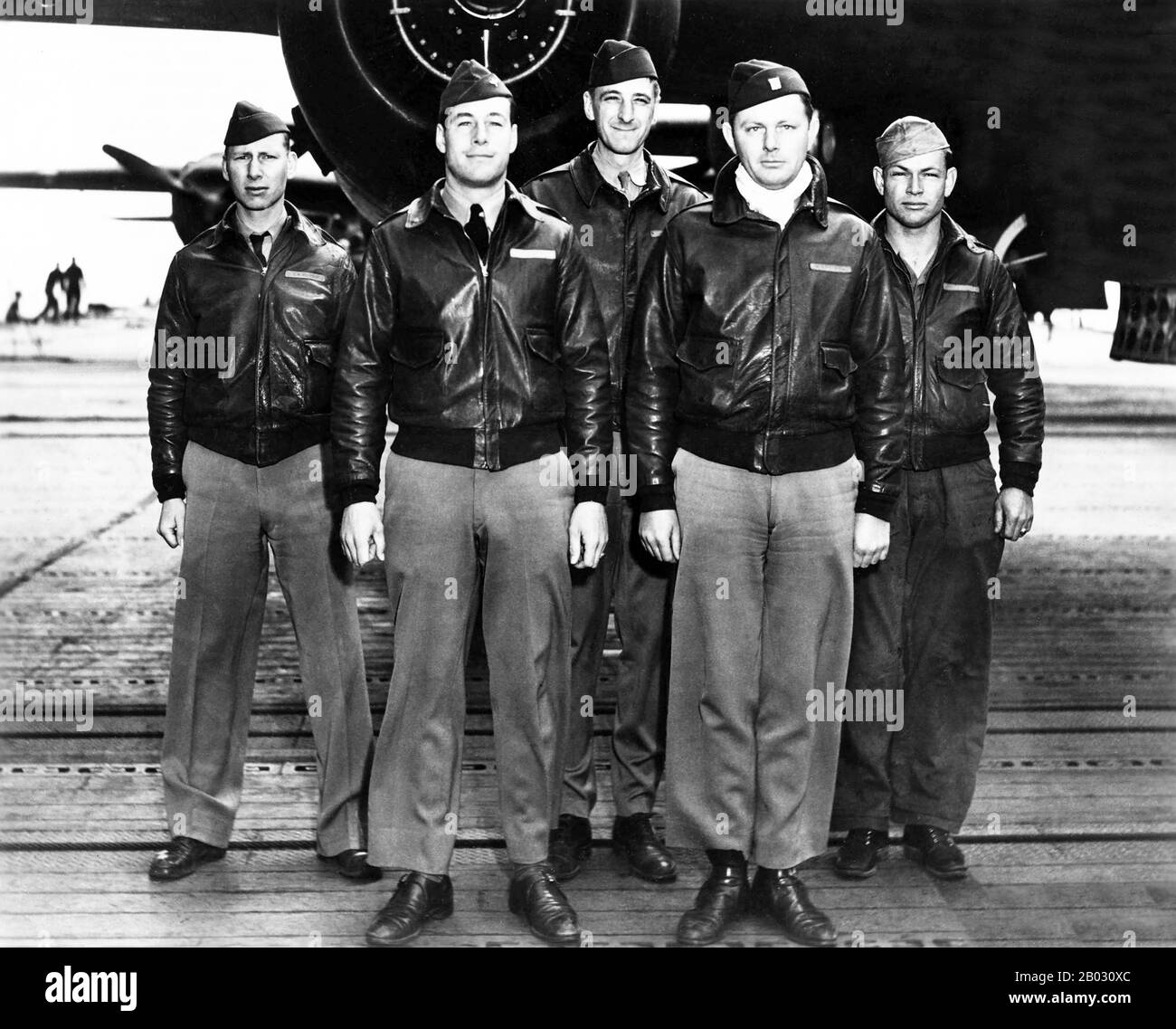 The Doolittle Raid, also known as the Tokyo Raid, on 18 April 1942, was an air raid by the United States on the Japanese capital Tokyo and other places on Honshu island during World War II, the first air raid to strike the Japanese Home Islands. It demonstrated that Japan itself was vulnerable to American air attack, served as retaliation for the Japanese attack on Pearl Harbor on 7 December 1941, and provided an important boost to U.S. morale while damaging Japanese morale. The raid was planned and led by Lieutenant Colonel James Doolittle. Sixteen U.S. Army Air Forces B-25B Mitchell medium Stock Photohttps://www.alamy.com/image-license-details/?v=1https://www.alamy.com/the-doolittle-raid-also-known-as-the-tokyo-raid-on-18-april-1942-was-an-air-raid-by-the-united-states-on-the-japanese-capital-tokyo-and-other-places-on-honshu-island-during-world-war-ii-the-first-air-raid-to-strike-the-japanese-home-islands-it-demonstrated-that-japan-itself-was-vulnerable-to-american-air-attack-served-as-retaliation-for-the-japanese-attack-on-pearl-harbor-on-7-december-1941-and-provided-an-important-boost-to-us-morale-while-damaging-japanese-morale-the-raid-was-planned-and-led-by-lieutenant-colonel-james-doolittle-sixteen-us-army-air-forces-b-25b-mitchell-medium-image344273956.html
The Doolittle Raid, also known as the Tokyo Raid, on 18 April 1942, was an air raid by the United States on the Japanese capital Tokyo and other places on Honshu island during World War II, the first air raid to strike the Japanese Home Islands. It demonstrated that Japan itself was vulnerable to American air attack, served as retaliation for the Japanese attack on Pearl Harbor on 7 December 1941, and provided an important boost to U.S. morale while damaging Japanese morale. The raid was planned and led by Lieutenant Colonel James Doolittle. Sixteen U.S. Army Air Forces B-25B Mitchell medium Stock Photohttps://www.alamy.com/image-license-details/?v=1https://www.alamy.com/the-doolittle-raid-also-known-as-the-tokyo-raid-on-18-april-1942-was-an-air-raid-by-the-united-states-on-the-japanese-capital-tokyo-and-other-places-on-honshu-island-during-world-war-ii-the-first-air-raid-to-strike-the-japanese-home-islands-it-demonstrated-that-japan-itself-was-vulnerable-to-american-air-attack-served-as-retaliation-for-the-japanese-attack-on-pearl-harbor-on-7-december-1941-and-provided-an-important-boost-to-us-morale-while-damaging-japanese-morale-the-raid-was-planned-and-led-by-lieutenant-colonel-james-doolittle-sixteen-us-army-air-forces-b-25b-mitchell-medium-image344273956.htmlRM2B030XC–The Doolittle Raid, also known as the Tokyo Raid, on 18 April 1942, was an air raid by the United States on the Japanese capital Tokyo and other places on Honshu island during World War II, the first air raid to strike the Japanese Home Islands. It demonstrated that Japan itself was vulnerable to American air attack, served as retaliation for the Japanese attack on Pearl Harbor on 7 December 1941, and provided an important boost to U.S. morale while damaging Japanese morale. The raid was planned and led by Lieutenant Colonel James Doolittle. Sixteen U.S. Army Air Forces B-25B Mitchell medium
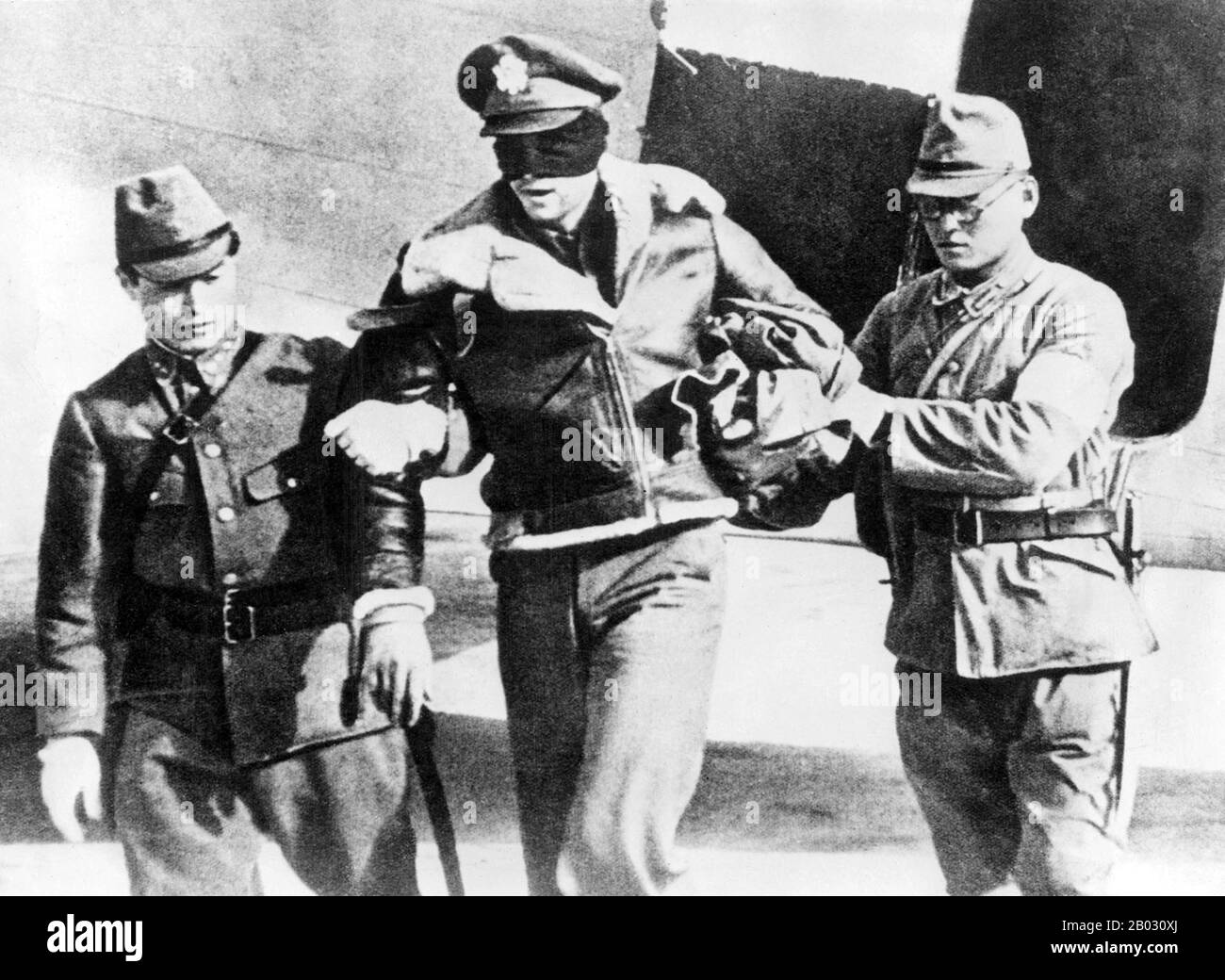 The Doolittle Raid, also known as the Tokyo Raid, on 18 April 1942, was an air raid by the United States on the Japanese capital Tokyo and other places on Honshu island during World War II, the first air raid to strike the Japanese Home Islands. It demonstrated that Japan itself was vulnerable to American air attack, served as retaliation for the Japanese attack on Pearl Harbor on 7 December 1941, and provided an important boost to U.S. morale while damaging Japanese morale. The raid was planned and led by Lieutenant Colonel James Doolittle. Sixteen U.S. Army Air Forces B-25B Mitchell medium Stock Photohttps://www.alamy.com/image-license-details/?v=1https://www.alamy.com/the-doolittle-raid-also-known-as-the-tokyo-raid-on-18-april-1942-was-an-air-raid-by-the-united-states-on-the-japanese-capital-tokyo-and-other-places-on-honshu-island-during-world-war-ii-the-first-air-raid-to-strike-the-japanese-home-islands-it-demonstrated-that-japan-itself-was-vulnerable-to-american-air-attack-served-as-retaliation-for-the-japanese-attack-on-pearl-harbor-on-7-december-1941-and-provided-an-important-boost-to-us-morale-while-damaging-japanese-morale-the-raid-was-planned-and-led-by-lieutenant-colonel-james-doolittle-sixteen-us-army-air-forces-b-25b-mitchell-medium-image344273962.html
The Doolittle Raid, also known as the Tokyo Raid, on 18 April 1942, was an air raid by the United States on the Japanese capital Tokyo and other places on Honshu island during World War II, the first air raid to strike the Japanese Home Islands. It demonstrated that Japan itself was vulnerable to American air attack, served as retaliation for the Japanese attack on Pearl Harbor on 7 December 1941, and provided an important boost to U.S. morale while damaging Japanese morale. The raid was planned and led by Lieutenant Colonel James Doolittle. Sixteen U.S. Army Air Forces B-25B Mitchell medium Stock Photohttps://www.alamy.com/image-license-details/?v=1https://www.alamy.com/the-doolittle-raid-also-known-as-the-tokyo-raid-on-18-april-1942-was-an-air-raid-by-the-united-states-on-the-japanese-capital-tokyo-and-other-places-on-honshu-island-during-world-war-ii-the-first-air-raid-to-strike-the-japanese-home-islands-it-demonstrated-that-japan-itself-was-vulnerable-to-american-air-attack-served-as-retaliation-for-the-japanese-attack-on-pearl-harbor-on-7-december-1941-and-provided-an-important-boost-to-us-morale-while-damaging-japanese-morale-the-raid-was-planned-and-led-by-lieutenant-colonel-james-doolittle-sixteen-us-army-air-forces-b-25b-mitchell-medium-image344273962.htmlRM2B030XJ–The Doolittle Raid, also known as the Tokyo Raid, on 18 April 1942, was an air raid by the United States on the Japanese capital Tokyo and other places on Honshu island during World War II, the first air raid to strike the Japanese Home Islands. It demonstrated that Japan itself was vulnerable to American air attack, served as retaliation for the Japanese attack on Pearl Harbor on 7 December 1941, and provided an important boost to U.S. morale while damaging Japanese morale. The raid was planned and led by Lieutenant Colonel James Doolittle. Sixteen U.S. Army Air Forces B-25B Mitchell medium
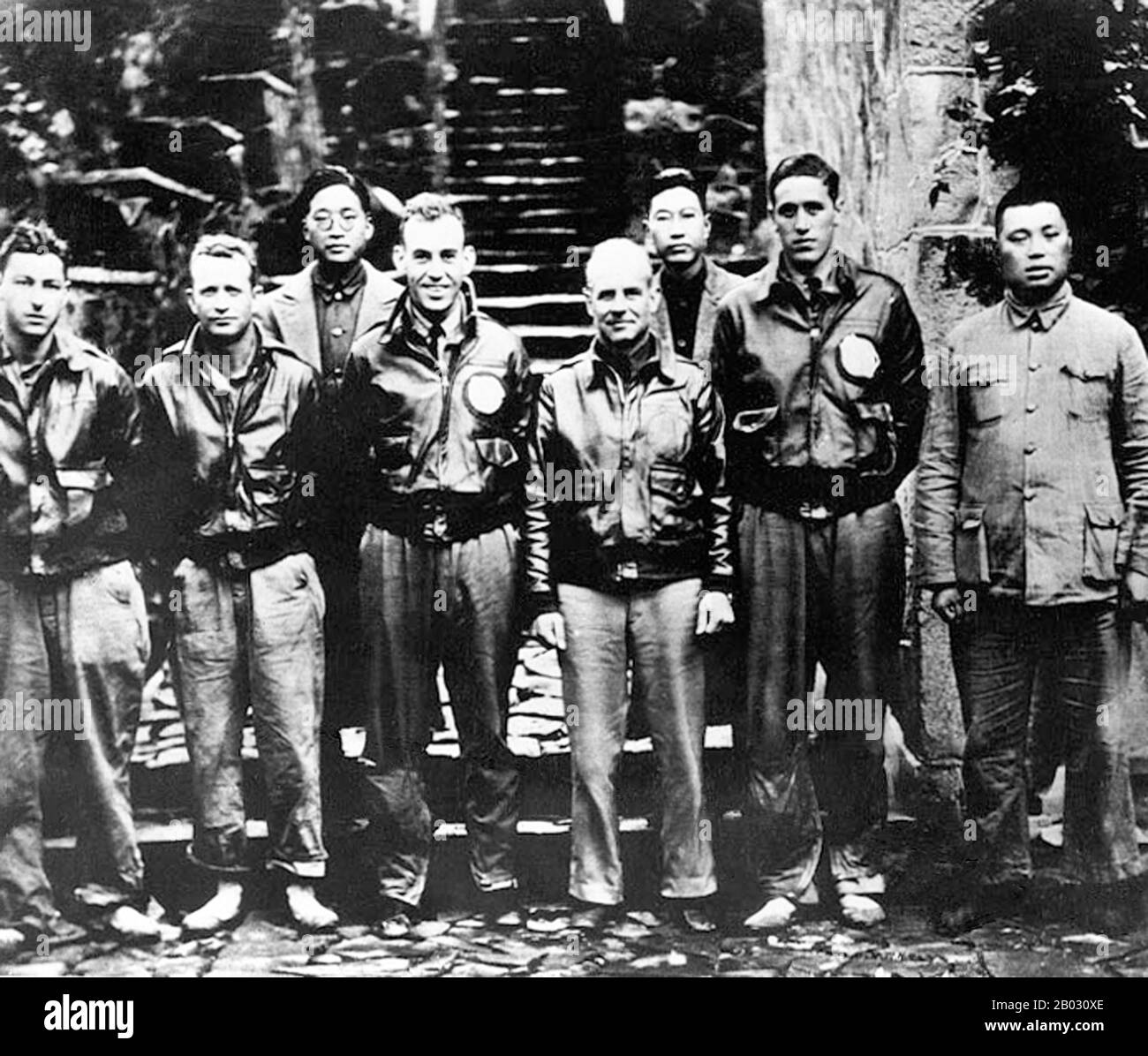 The Doolittle Raid, also known as the Tokyo Raid, on 18 April 1942, was an air raid by the United States on the Japanese capital Tokyo and other places on Honshu island during World War II, the first air raid to strike the Japanese Home Islands. It demonstrated that Japan itself was vulnerable to American air attack, served as retaliation for the Japanese attack on Pearl Harbor on 7 December 1941, and provided an important boost to U.S. morale while damaging Japanese morale. The raid was planned and led by Lieutenant Colonel James Doolittle. Sixteen U.S. Army Air Forces B-25B Mitchell medium Stock Photohttps://www.alamy.com/image-license-details/?v=1https://www.alamy.com/the-doolittle-raid-also-known-as-the-tokyo-raid-on-18-april-1942-was-an-air-raid-by-the-united-states-on-the-japanese-capital-tokyo-and-other-places-on-honshu-island-during-world-war-ii-the-first-air-raid-to-strike-the-japanese-home-islands-it-demonstrated-that-japan-itself-was-vulnerable-to-american-air-attack-served-as-retaliation-for-the-japanese-attack-on-pearl-harbor-on-7-december-1941-and-provided-an-important-boost-to-us-morale-while-damaging-japanese-morale-the-raid-was-planned-and-led-by-lieutenant-colonel-james-doolittle-sixteen-us-army-air-forces-b-25b-mitchell-medium-image344273958.html
The Doolittle Raid, also known as the Tokyo Raid, on 18 April 1942, was an air raid by the United States on the Japanese capital Tokyo and other places on Honshu island during World War II, the first air raid to strike the Japanese Home Islands. It demonstrated that Japan itself was vulnerable to American air attack, served as retaliation for the Japanese attack on Pearl Harbor on 7 December 1941, and provided an important boost to U.S. morale while damaging Japanese morale. The raid was planned and led by Lieutenant Colonel James Doolittle. Sixteen U.S. Army Air Forces B-25B Mitchell medium Stock Photohttps://www.alamy.com/image-license-details/?v=1https://www.alamy.com/the-doolittle-raid-also-known-as-the-tokyo-raid-on-18-april-1942-was-an-air-raid-by-the-united-states-on-the-japanese-capital-tokyo-and-other-places-on-honshu-island-during-world-war-ii-the-first-air-raid-to-strike-the-japanese-home-islands-it-demonstrated-that-japan-itself-was-vulnerable-to-american-air-attack-served-as-retaliation-for-the-japanese-attack-on-pearl-harbor-on-7-december-1941-and-provided-an-important-boost-to-us-morale-while-damaging-japanese-morale-the-raid-was-planned-and-led-by-lieutenant-colonel-james-doolittle-sixteen-us-army-air-forces-b-25b-mitchell-medium-image344273958.htmlRM2B030XE–The Doolittle Raid, also known as the Tokyo Raid, on 18 April 1942, was an air raid by the United States on the Japanese capital Tokyo and other places on Honshu island during World War II, the first air raid to strike the Japanese Home Islands. It demonstrated that Japan itself was vulnerable to American air attack, served as retaliation for the Japanese attack on Pearl Harbor on 7 December 1941, and provided an important boost to U.S. morale while damaging Japanese morale. The raid was planned and led by Lieutenant Colonel James Doolittle. Sixteen U.S. Army Air Forces B-25B Mitchell medium
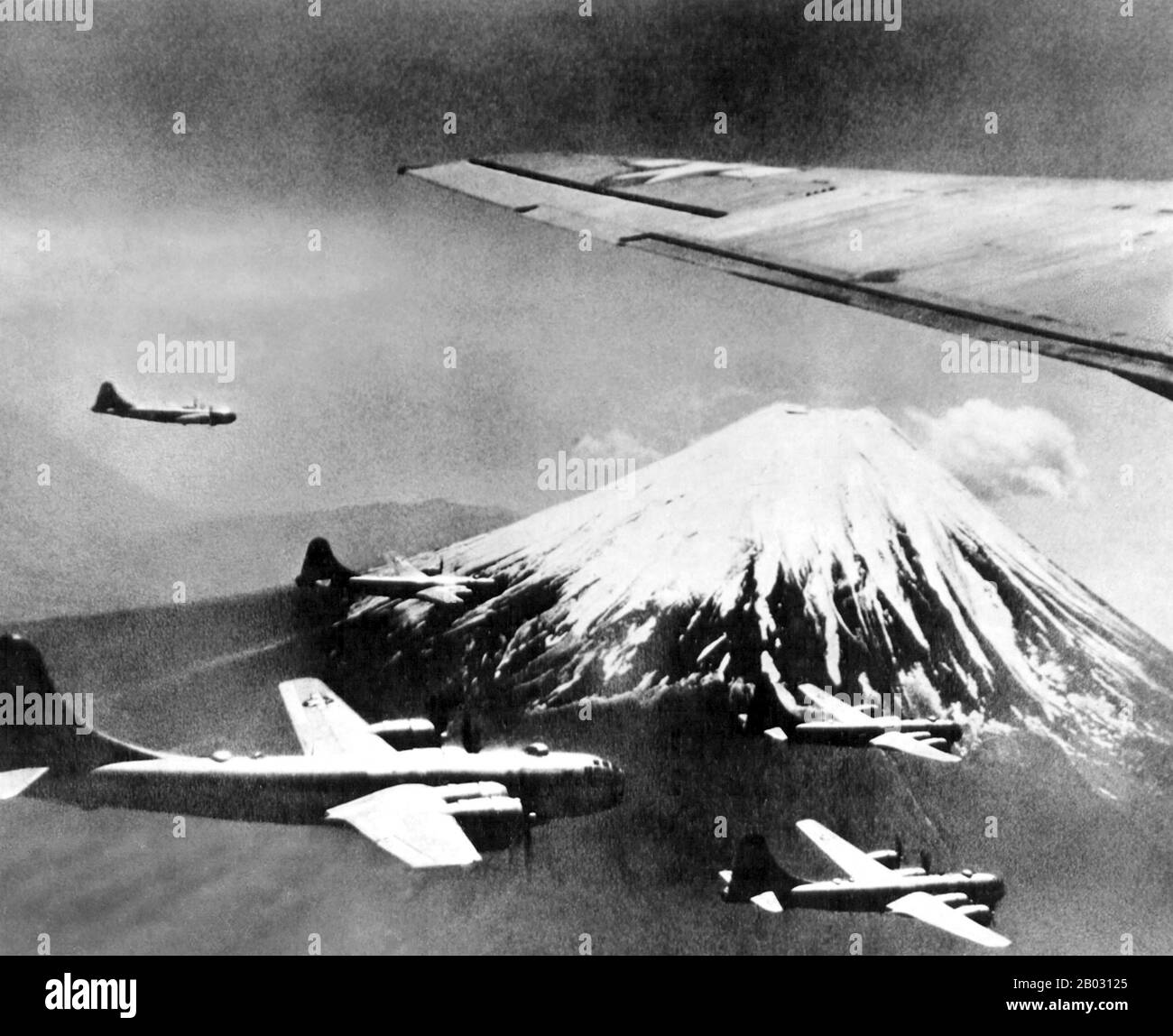 Allied forces conducted many air raids on Japan during World War II, causing extensive destruction to the country's cities and killing between 241,000 and 900,000 people. During the first years of the Pacific War, sparked by the Japanese attack on Pearl Harbor, these attacks were limited to the Doolittle Raid in April 1942 and small-scale raids on military positions in the Kuril Islands from mid-1943. Strategic bombing raids began in June 1944 and continued until the end of the war in August 1945. Allied naval and land-based tactical air units also attacked Japan during 1945. Stock Photohttps://www.alamy.com/image-license-details/?v=1https://www.alamy.com/allied-forces-conducted-many-air-raids-on-japan-during-world-war-ii-causing-extensive-destruction-to-the-countrys-cities-and-killing-between-241000-and-900000-people-during-the-first-years-of-the-pacific-war-sparked-by-the-japanese-attack-on-pearl-harbor-these-attacks-were-limited-to-the-doolittle-raid-in-april-1942-and-small-scale-raids-on-military-positions-in-the-kuril-islands-from-mid-1943-strategic-bombing-raids-began-in-june-1944-and-continued-until-the-end-of-the-war-in-august-1945-allied-naval-and-land-based-tactical-air-units-also-attacked-japan-during-1945-image344274061.html
Allied forces conducted many air raids on Japan during World War II, causing extensive destruction to the country's cities and killing between 241,000 and 900,000 people. During the first years of the Pacific War, sparked by the Japanese attack on Pearl Harbor, these attacks were limited to the Doolittle Raid in April 1942 and small-scale raids on military positions in the Kuril Islands from mid-1943. Strategic bombing raids began in June 1944 and continued until the end of the war in August 1945. Allied naval and land-based tactical air units also attacked Japan during 1945. Stock Photohttps://www.alamy.com/image-license-details/?v=1https://www.alamy.com/allied-forces-conducted-many-air-raids-on-japan-during-world-war-ii-causing-extensive-destruction-to-the-countrys-cities-and-killing-between-241000-and-900000-people-during-the-first-years-of-the-pacific-war-sparked-by-the-japanese-attack-on-pearl-harbor-these-attacks-were-limited-to-the-doolittle-raid-in-april-1942-and-small-scale-raids-on-military-positions-in-the-kuril-islands-from-mid-1943-strategic-bombing-raids-began-in-june-1944-and-continued-until-the-end-of-the-war-in-august-1945-allied-naval-and-land-based-tactical-air-units-also-attacked-japan-during-1945-image344274061.htmlRM2B03125–Allied forces conducted many air raids on Japan during World War II, causing extensive destruction to the country's cities and killing between 241,000 and 900,000 people. During the first years of the Pacific War, sparked by the Japanese attack on Pearl Harbor, these attacks were limited to the Doolittle Raid in April 1942 and small-scale raids on military positions in the Kuril Islands from mid-1943. Strategic bombing raids began in June 1944 and continued until the end of the war in August 1945. Allied naval and land-based tactical air units also attacked Japan during 1945.
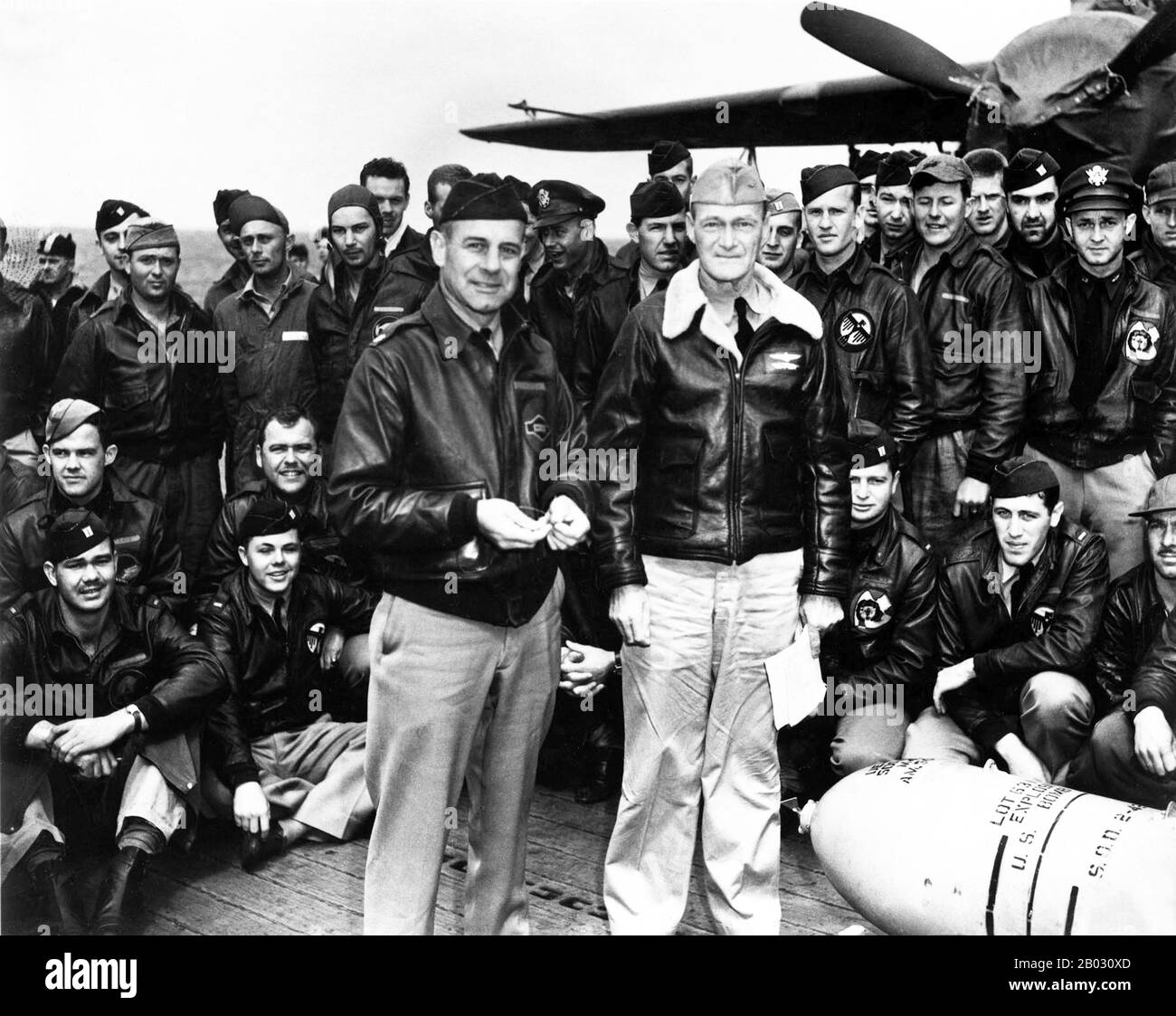 The Doolittle Raid, also known as the Tokyo Raid, on 18 April 1942, was an air raid by the United States on the Japanese capital Tokyo and other places on Honshu island during World War II, the first air raid to strike the Japanese Home Islands. It demonstrated that Japan itself was vulnerable to American air attack, served as retaliation for the Japanese attack on Pearl Harbor on 7 December 1941, and provided an important boost to U.S. morale while damaging Japanese morale. The raid was planned and led by Lieutenant Colonel James Doolittle. Sixteen U.S. Army Air Forces B-25B Mitchell medium Stock Photohttps://www.alamy.com/image-license-details/?v=1https://www.alamy.com/the-doolittle-raid-also-known-as-the-tokyo-raid-on-18-april-1942-was-an-air-raid-by-the-united-states-on-the-japanese-capital-tokyo-and-other-places-on-honshu-island-during-world-war-ii-the-first-air-raid-to-strike-the-japanese-home-islands-it-demonstrated-that-japan-itself-was-vulnerable-to-american-air-attack-served-as-retaliation-for-the-japanese-attack-on-pearl-harbor-on-7-december-1941-and-provided-an-important-boost-to-us-morale-while-damaging-japanese-morale-the-raid-was-planned-and-led-by-lieutenant-colonel-james-doolittle-sixteen-us-army-air-forces-b-25b-mitchell-medium-image344273957.html
The Doolittle Raid, also known as the Tokyo Raid, on 18 April 1942, was an air raid by the United States on the Japanese capital Tokyo and other places on Honshu island during World War II, the first air raid to strike the Japanese Home Islands. It demonstrated that Japan itself was vulnerable to American air attack, served as retaliation for the Japanese attack on Pearl Harbor on 7 December 1941, and provided an important boost to U.S. morale while damaging Japanese morale. The raid was planned and led by Lieutenant Colonel James Doolittle. Sixteen U.S. Army Air Forces B-25B Mitchell medium Stock Photohttps://www.alamy.com/image-license-details/?v=1https://www.alamy.com/the-doolittle-raid-also-known-as-the-tokyo-raid-on-18-april-1942-was-an-air-raid-by-the-united-states-on-the-japanese-capital-tokyo-and-other-places-on-honshu-island-during-world-war-ii-the-first-air-raid-to-strike-the-japanese-home-islands-it-demonstrated-that-japan-itself-was-vulnerable-to-american-air-attack-served-as-retaliation-for-the-japanese-attack-on-pearl-harbor-on-7-december-1941-and-provided-an-important-boost-to-us-morale-while-damaging-japanese-morale-the-raid-was-planned-and-led-by-lieutenant-colonel-james-doolittle-sixteen-us-army-air-forces-b-25b-mitchell-medium-image344273957.htmlRM2B030XD–The Doolittle Raid, also known as the Tokyo Raid, on 18 April 1942, was an air raid by the United States on the Japanese capital Tokyo and other places on Honshu island during World War II, the first air raid to strike the Japanese Home Islands. It demonstrated that Japan itself was vulnerable to American air attack, served as retaliation for the Japanese attack on Pearl Harbor on 7 December 1941, and provided an important boost to U.S. morale while damaging Japanese morale. The raid was planned and led by Lieutenant Colonel James Doolittle. Sixteen U.S. Army Air Forces B-25B Mitchell medium
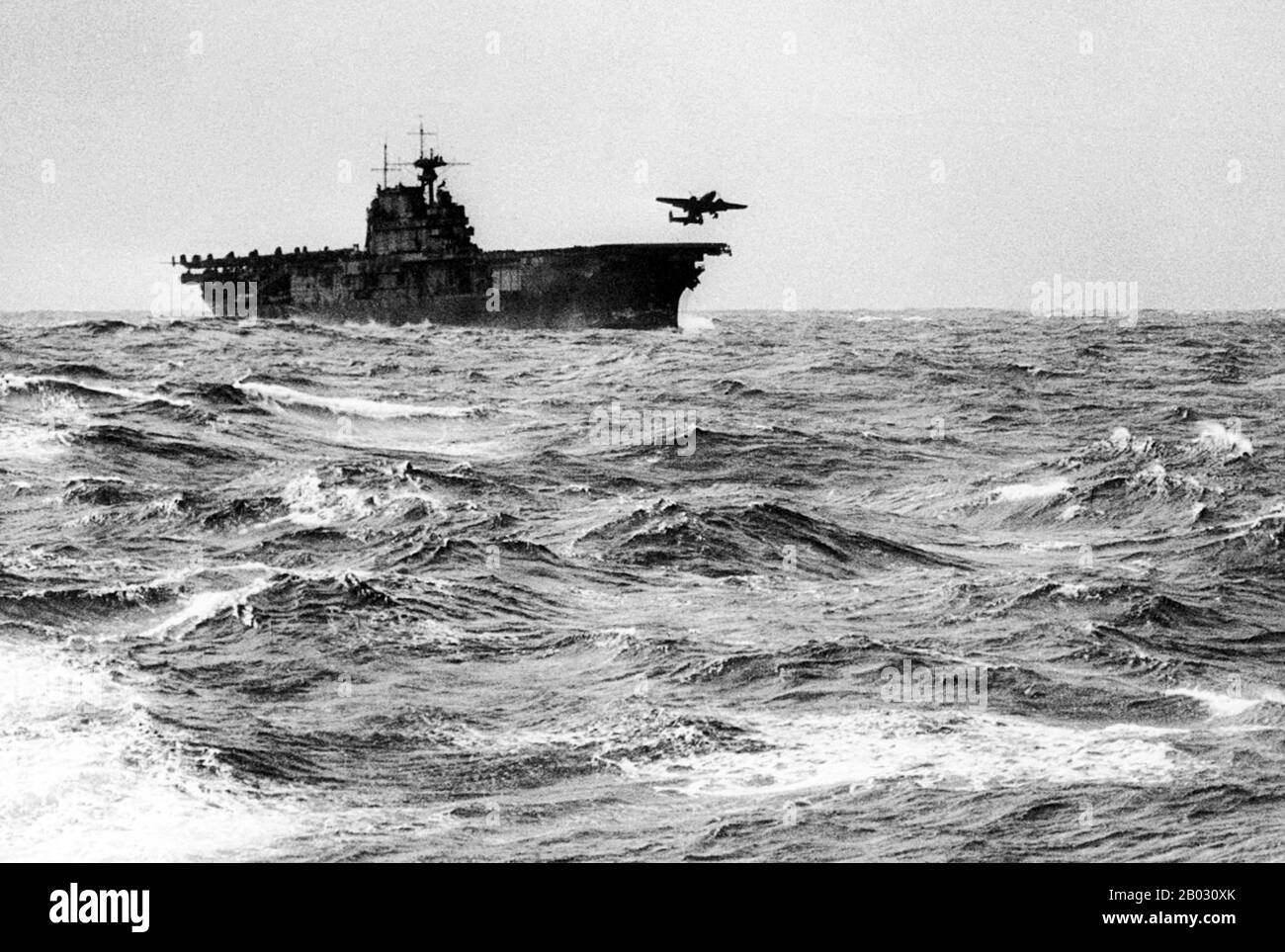 The Doolittle Raid, also known as the Tokyo Raid, on 18 April 1942, was an air raid by the United States on the Japanese capital Tokyo and other places on Honshu island during World War II, the first air raid to strike the Japanese Home Islands. It demonstrated that Japan itself was vulnerable to American air attack, served as retaliation for the Japanese attack on Pearl Harbor on 7 December 1941, and provided an important boost to U.S. morale while damaging Japanese morale. The raid was planned and led by Lieutenant Colonel James Doolittle. Sixteen U.S. Army Air Forces B-25B Mitchell medium Stock Photohttps://www.alamy.com/image-license-details/?v=1https://www.alamy.com/the-doolittle-raid-also-known-as-the-tokyo-raid-on-18-april-1942-was-an-air-raid-by-the-united-states-on-the-japanese-capital-tokyo-and-other-places-on-honshu-island-during-world-war-ii-the-first-air-raid-to-strike-the-japanese-home-islands-it-demonstrated-that-japan-itself-was-vulnerable-to-american-air-attack-served-as-retaliation-for-the-japanese-attack-on-pearl-harbor-on-7-december-1941-and-provided-an-important-boost-to-us-morale-while-damaging-japanese-morale-the-raid-was-planned-and-led-by-lieutenant-colonel-james-doolittle-sixteen-us-army-air-forces-b-25b-mitchell-medium-image344273963.html
The Doolittle Raid, also known as the Tokyo Raid, on 18 April 1942, was an air raid by the United States on the Japanese capital Tokyo and other places on Honshu island during World War II, the first air raid to strike the Japanese Home Islands. It demonstrated that Japan itself was vulnerable to American air attack, served as retaliation for the Japanese attack on Pearl Harbor on 7 December 1941, and provided an important boost to U.S. morale while damaging Japanese morale. The raid was planned and led by Lieutenant Colonel James Doolittle. Sixteen U.S. Army Air Forces B-25B Mitchell medium Stock Photohttps://www.alamy.com/image-license-details/?v=1https://www.alamy.com/the-doolittle-raid-also-known-as-the-tokyo-raid-on-18-april-1942-was-an-air-raid-by-the-united-states-on-the-japanese-capital-tokyo-and-other-places-on-honshu-island-during-world-war-ii-the-first-air-raid-to-strike-the-japanese-home-islands-it-demonstrated-that-japan-itself-was-vulnerable-to-american-air-attack-served-as-retaliation-for-the-japanese-attack-on-pearl-harbor-on-7-december-1941-and-provided-an-important-boost-to-us-morale-while-damaging-japanese-morale-the-raid-was-planned-and-led-by-lieutenant-colonel-james-doolittle-sixteen-us-army-air-forces-b-25b-mitchell-medium-image344273963.htmlRM2B030XK–The Doolittle Raid, also known as the Tokyo Raid, on 18 April 1942, was an air raid by the United States on the Japanese capital Tokyo and other places on Honshu island during World War II, the first air raid to strike the Japanese Home Islands. It demonstrated that Japan itself was vulnerable to American air attack, served as retaliation for the Japanese attack on Pearl Harbor on 7 December 1941, and provided an important boost to U.S. morale while damaging Japanese morale. The raid was planned and led by Lieutenant Colonel James Doolittle. Sixteen U.S. Army Air Forces B-25B Mitchell medium